Influence of Music on Consumer Behavior
VerifiedAdded on 2020/02/12
|42
|14467
|202
AI Summary
This assignment delves into the psychological effects of music on consumer behavior. It examines how different musical elements like pitch, volume, and genre influence consumer emotions, perceptions of store environments, and ultimately, purchase intentions. The assignment requires students to analyze existing research and theories related to music's impact on shopping experiences.
Contribute Materials
Your contribution can guide someone’s learning journey. Share your
documents today.
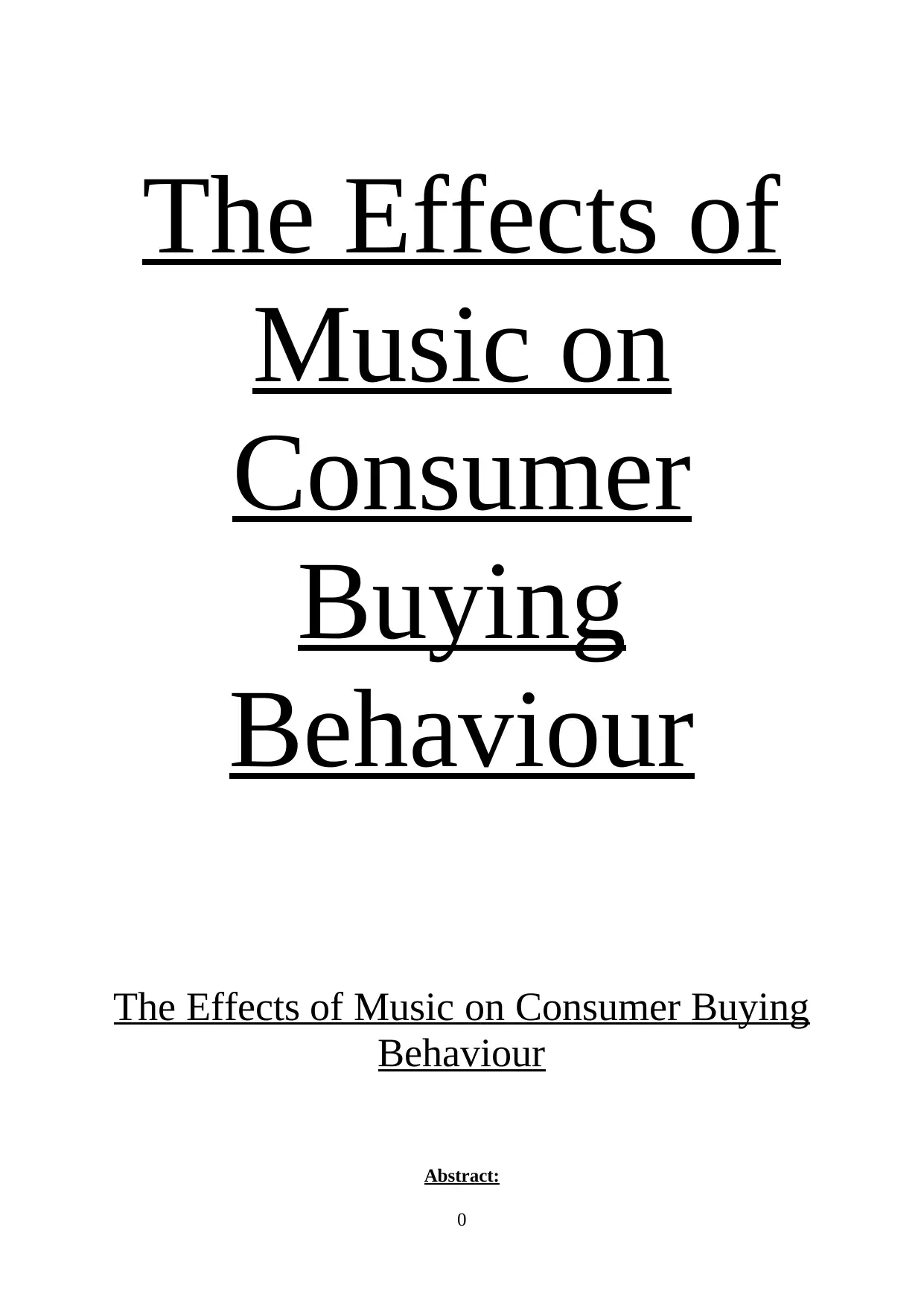
The Effects of
Music on
Consumer
Buying
Behaviour
The Effects of Music on Consumer Buying
Behaviour
Abstract:
0
Music on
Consumer
Buying
Behaviour
The Effects of Music on Consumer Buying
Behaviour
Abstract:
0
Secure Best Marks with AI Grader
Need help grading? Try our AI Grader for instant feedback on your assignments.
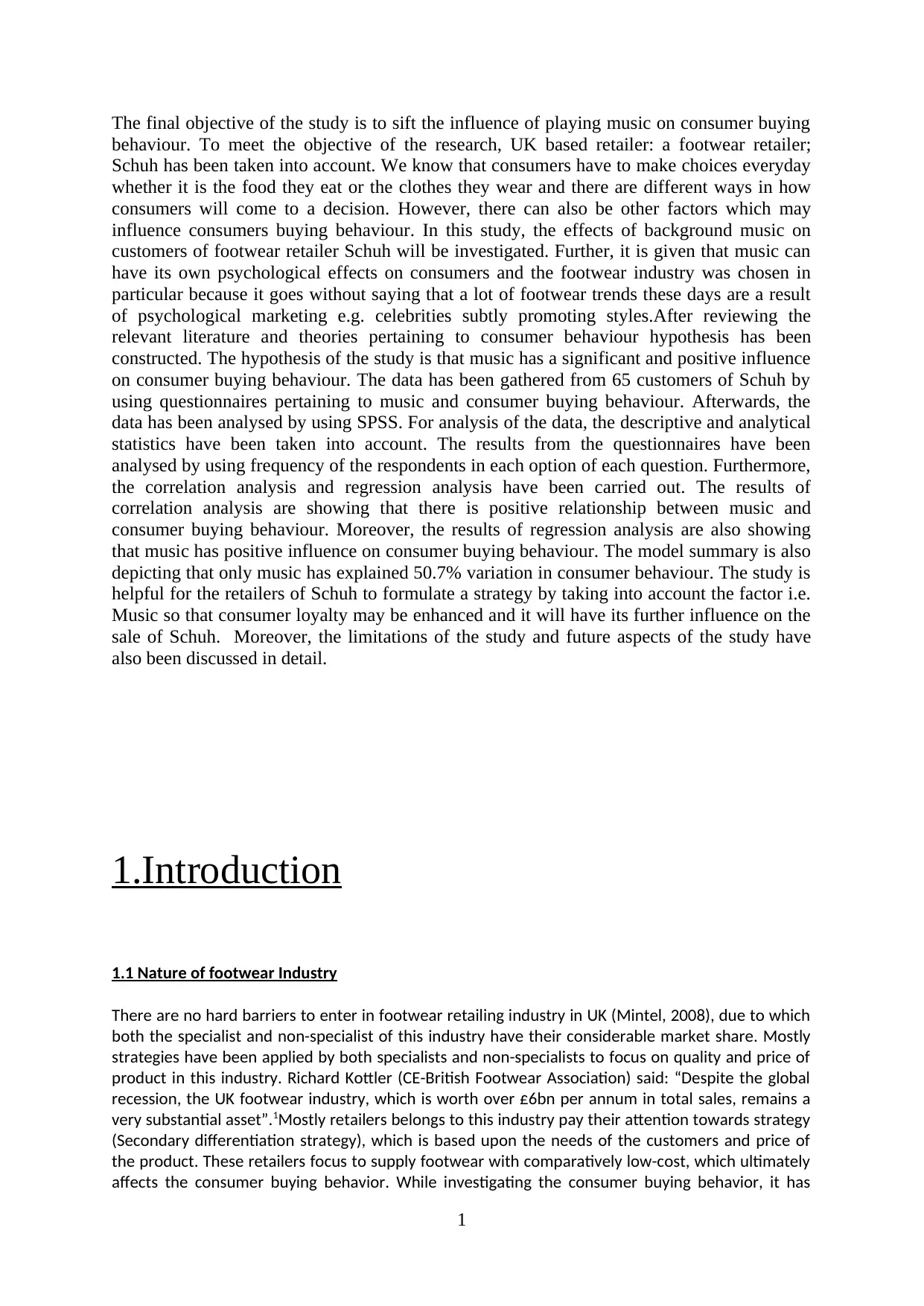
The final objective of the study is to sift the influence of playing music on consumer buying
behaviour. To meet the objective of the research, UK based retailer: a footwear retailer;
Schuh has been taken into account. We know that consumers have to make choices everyday
whether it is the food they eat or the clothes they wear and there are different ways in how
consumers will come to a decision. However, there can also be other factors which may
influence consumers buying behaviour. In this study, the effects of background music on
customers of footwear retailer Schuh will be investigated. Further, it is given that music can
have its own psychological effects on consumers and the footwear industry was chosen in
particular because it goes without saying that a lot of footwear trends these days are a result
of psychological marketing e.g. celebrities subtly promoting styles.After reviewing the
relevant literature and theories pertaining to consumer behaviour hypothesis has been
constructed. The hypothesis of the study is that music has a significant and positive influence
on consumer buying behaviour. The data has been gathered from 65 customers of Schuh by
using questionnaires pertaining to music and consumer buying behaviour. Afterwards, the
data has been analysed by using SPSS. For analysis of the data, the descriptive and analytical
statistics have been taken into account. The results from the questionnaires have been
analysed by using frequency of the respondents in each option of each question. Furthermore,
the correlation analysis and regression analysis have been carried out. The results of
correlation analysis are showing that there is positive relationship between music and
consumer buying behaviour. Moreover, the results of regression analysis are also showing
that music has positive influence on consumer buying behaviour. The model summary is also
depicting that only music has explained 50.7% variation in consumer behaviour. The study is
helpful for the retailers of Schuh to formulate a strategy by taking into account the factor i.e.
Music so that consumer loyalty may be enhanced and it will have its further influence on the
sale of Schuh. Moreover, the limitations of the study and future aspects of the study have
also been discussed in detail.
1.Introduction
1.1 Nature of footwear Industry
There are no hard barriers to enter in footwear retailing industry in UK (Mintel, 2008), due to which
both the specialist and non-specialist of this industry have their considerable market share. Mostly
strategies have been applied by both specialists and non-specialists to focus on quality and price of
product in this industry. Richard Kottler (CE-British Footwear Association) said: “Despite the global
recession, the UK footwear industry, which is worth over £6bn per annum in total sales, remains a
very substantial asset”.1Mostly retailers belongs to this industry pay their attention towards strategy
(Secondary differentiation strategy), which is based upon the needs of the customers and price of
the product. These retailers focus to supply footwear with comparatively low-cost, which ultimately
affects the consumer buying behavior. While investigating the consumer buying behavior, it has
1
behaviour. To meet the objective of the research, UK based retailer: a footwear retailer;
Schuh has been taken into account. We know that consumers have to make choices everyday
whether it is the food they eat or the clothes they wear and there are different ways in how
consumers will come to a decision. However, there can also be other factors which may
influence consumers buying behaviour. In this study, the effects of background music on
customers of footwear retailer Schuh will be investigated. Further, it is given that music can
have its own psychological effects on consumers and the footwear industry was chosen in
particular because it goes without saying that a lot of footwear trends these days are a result
of psychological marketing e.g. celebrities subtly promoting styles.After reviewing the
relevant literature and theories pertaining to consumer behaviour hypothesis has been
constructed. The hypothesis of the study is that music has a significant and positive influence
on consumer buying behaviour. The data has been gathered from 65 customers of Schuh by
using questionnaires pertaining to music and consumer buying behaviour. Afterwards, the
data has been analysed by using SPSS. For analysis of the data, the descriptive and analytical
statistics have been taken into account. The results from the questionnaires have been
analysed by using frequency of the respondents in each option of each question. Furthermore,
the correlation analysis and regression analysis have been carried out. The results of
correlation analysis are showing that there is positive relationship between music and
consumer buying behaviour. Moreover, the results of regression analysis are also showing
that music has positive influence on consumer buying behaviour. The model summary is also
depicting that only music has explained 50.7% variation in consumer behaviour. The study is
helpful for the retailers of Schuh to formulate a strategy by taking into account the factor i.e.
Music so that consumer loyalty may be enhanced and it will have its further influence on the
sale of Schuh. Moreover, the limitations of the study and future aspects of the study have
also been discussed in detail.
1.Introduction
1.1 Nature of footwear Industry
There are no hard barriers to enter in footwear retailing industry in UK (Mintel, 2008), due to which
both the specialist and non-specialist of this industry have their considerable market share. Mostly
strategies have been applied by both specialists and non-specialists to focus on quality and price of
product in this industry. Richard Kottler (CE-British Footwear Association) said: “Despite the global
recession, the UK footwear industry, which is worth over £6bn per annum in total sales, remains a
very substantial asset”.1Mostly retailers belongs to this industry pay their attention towards strategy
(Secondary differentiation strategy), which is based upon the needs of the customers and price of
the product. These retailers focus to supply footwear with comparatively low-cost, which ultimately
affects the consumer buying behavior. While investigating the consumer buying behavior, it has
1
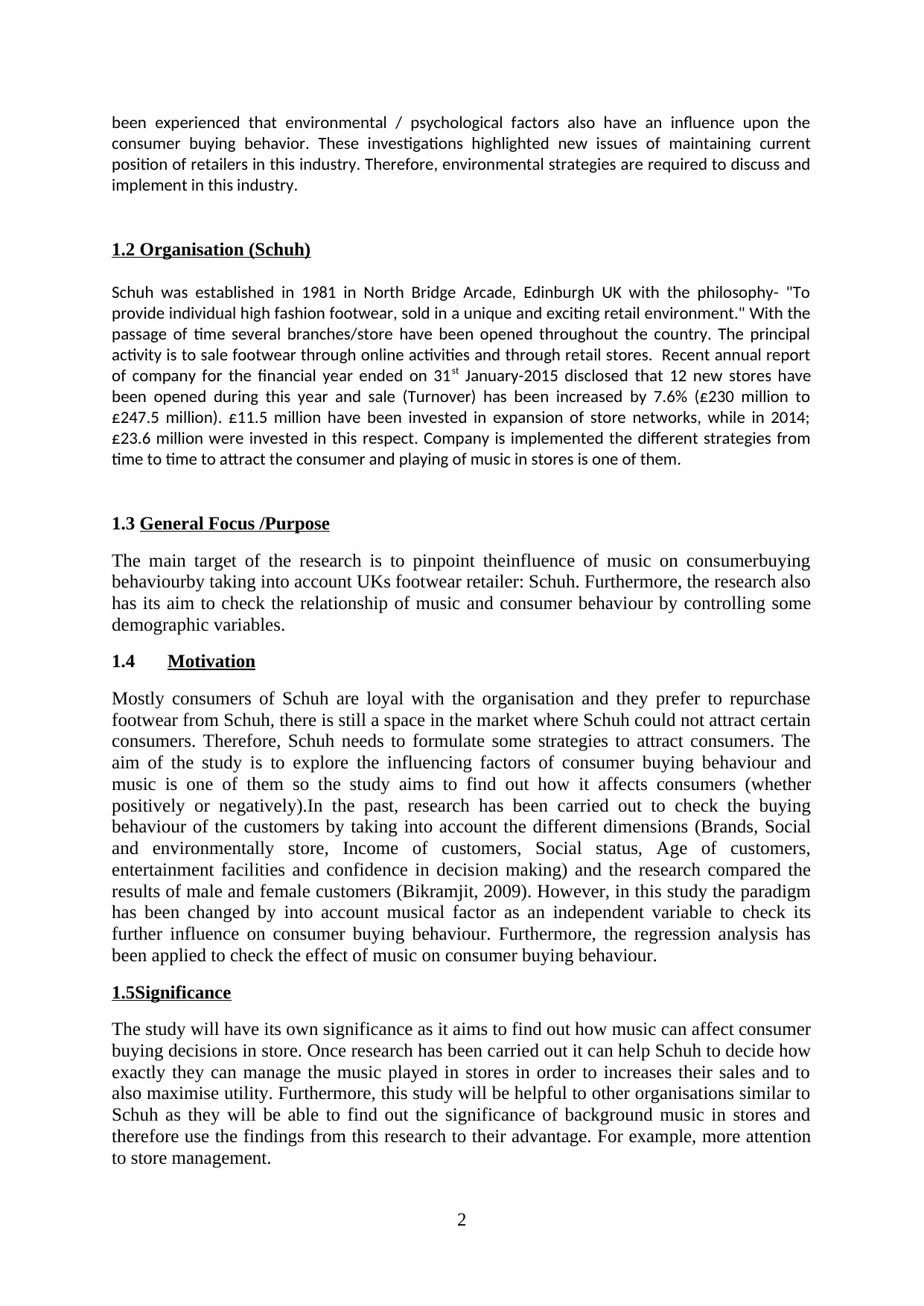
been experienced that environmental / psychological factors also have an influence upon the
consumer buying behavior. These investigations highlighted new issues of maintaining current
position of retailers in this industry. Therefore, environmental strategies are required to discuss and
implement in this industry.
1.2 Organisation (Schuh)
Schuh was established in 1981 in North Bridge Arcade, Edinburgh UK with the philosophy- "To
provide individual high fashion footwear, sold in a unique and exciting retail environment." With the
passage of time several branches/store have been opened throughout the country. The principal
activity is to sale footwear through online activities and through retail stores. Recent annual report
of company for the financial year ended on 31st January-2015 disclosed that 12 new stores have
been opened during this year and sale (Turnover) has been increased by 7.6% (£230 million to
£247.5 million). £11.5 million have been invested in expansion of store networks, while in 2014;
£23.6 million were invested in this respect. Company is implemented the different strategies from
time to time to attract the consumer and playing of music in stores is one of them.
1.3 General Focus /Purpose
The main target of the research is to pinpoint theinfluence of music on consumerbuying
behaviourby taking into account UKs footwear retailer: Schuh. Furthermore, the research also
has its aim to check the relationship of music and consumer behaviour by controlling some
demographic variables.
1.4 Motivation
Mostly consumers of Schuh are loyal with the organisation and they prefer to repurchase
footwear from Schuh, there is still a space in the market where Schuh could not attract certain
consumers. Therefore, Schuh needs to formulate some strategies to attract consumers. The
aim of the study is to explore the influencing factors of consumer buying behaviour and
music is one of them so the study aims to find out how it affects consumers (whether
positively or negatively).In the past, research has been carried out to check the buying
behaviour of the customers by taking into account the different dimensions (Brands, Social
and environmentally store, Income of customers, Social status, Age of customers,
entertainment facilities and confidence in decision making) and the research compared the
results of male and female customers (Bikramjit, 2009). However, in this study the paradigm
has been changed by into account musical factor as an independent variable to check its
further influence on consumer buying behaviour. Furthermore, the regression analysis has
been applied to check the effect of music on consumer buying behaviour.
1.5Significance
The study will have its own significance as it aims to find out how music can affect consumer
buying decisions in store. Once research has been carried out it can help Schuh to decide how
exactly they can manage the music played in stores in order to increases their sales and to
also maximise utility. Furthermore, this study will be helpful to other organisations similar to
Schuh as they will be able to find out the significance of background music in stores and
therefore use the findings from this research to their advantage. For example, more attention
to store management.
2
consumer buying behavior. These investigations highlighted new issues of maintaining current
position of retailers in this industry. Therefore, environmental strategies are required to discuss and
implement in this industry.
1.2 Organisation (Schuh)
Schuh was established in 1981 in North Bridge Arcade, Edinburgh UK with the philosophy- "To
provide individual high fashion footwear, sold in a unique and exciting retail environment." With the
passage of time several branches/store have been opened throughout the country. The principal
activity is to sale footwear through online activities and through retail stores. Recent annual report
of company for the financial year ended on 31st January-2015 disclosed that 12 new stores have
been opened during this year and sale (Turnover) has been increased by 7.6% (£230 million to
£247.5 million). £11.5 million have been invested in expansion of store networks, while in 2014;
£23.6 million were invested in this respect. Company is implemented the different strategies from
time to time to attract the consumer and playing of music in stores is one of them.
1.3 General Focus /Purpose
The main target of the research is to pinpoint theinfluence of music on consumerbuying
behaviourby taking into account UKs footwear retailer: Schuh. Furthermore, the research also
has its aim to check the relationship of music and consumer behaviour by controlling some
demographic variables.
1.4 Motivation
Mostly consumers of Schuh are loyal with the organisation and they prefer to repurchase
footwear from Schuh, there is still a space in the market where Schuh could not attract certain
consumers. Therefore, Schuh needs to formulate some strategies to attract consumers. The
aim of the study is to explore the influencing factors of consumer buying behaviour and
music is one of them so the study aims to find out how it affects consumers (whether
positively or negatively).In the past, research has been carried out to check the buying
behaviour of the customers by taking into account the different dimensions (Brands, Social
and environmentally store, Income of customers, Social status, Age of customers,
entertainment facilities and confidence in decision making) and the research compared the
results of male and female customers (Bikramjit, 2009). However, in this study the paradigm
has been changed by into account musical factor as an independent variable to check its
further influence on consumer buying behaviour. Furthermore, the regression analysis has
been applied to check the effect of music on consumer buying behaviour.
1.5Significance
The study will have its own significance as it aims to find out how music can affect consumer
buying decisions in store. Once research has been carried out it can help Schuh to decide how
exactly they can manage the music played in stores in order to increases their sales and to
also maximise utility. Furthermore, this study will be helpful to other organisations similar to
Schuh as they will be able to find out the significance of background music in stores and
therefore use the findings from this research to their advantage. For example, more attention
to store management.
2
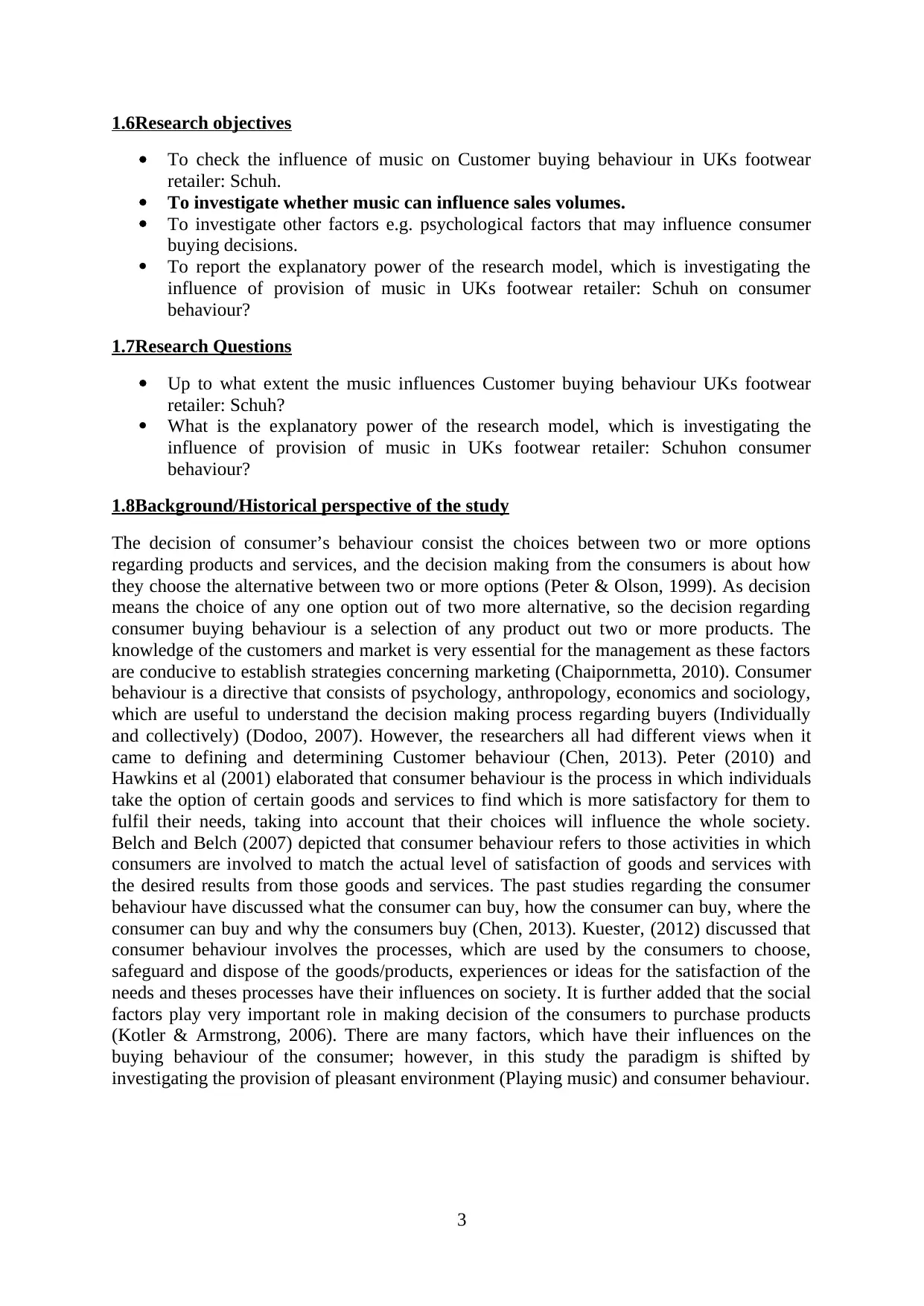
1.6Research objectives
To check the influence of music on Customer buying behaviour in UKs footwear
retailer: Schuh.
To investigate whether music can influence sales volumes.
To investigate other factors e.g. psychological factors that may influence consumer
buying decisions.
To report the explanatory power of the research model, which is investigating the
influence of provision of music in UKs footwear retailer: Schuh on consumer
behaviour?
1.7Research Questions
Up to what extent the music influences Customer buying behaviour UKs footwear
retailer: Schuh?
What is the explanatory power of the research model, which is investigating the
influence of provision of music in UKs footwear retailer: Schuhon consumer
behaviour?
1.8Background/Historical perspective of the study
The decision of consumer’s behaviour consist the choices between two or more options
regarding products and services, and the decision making from the consumers is about how
they choose the alternative between two or more options (Peter & Olson, 1999). As decision
means the choice of any one option out of two more alternative, so the decision regarding
consumer buying behaviour is a selection of any product out two or more products. The
knowledge of the customers and market is very essential for the management as these factors
are conducive to establish strategies concerning marketing (Chaipornmetta, 2010). Consumer
behaviour is a directive that consists of psychology, anthropology, economics and sociology,
which are useful to understand the decision making process regarding buyers (Individually
and collectively) (Dodoo, 2007). However, the researchers all had different views when it
came to defining and determining Customer behaviour (Chen, 2013). Peter (2010) and
Hawkins et al (2001) elaborated that consumer behaviour is the process in which individuals
take the option of certain goods and services to find which is more satisfactory for them to
fulfil their needs, taking into account that their choices will influence the whole society.
Belch and Belch (2007) depicted that consumer behaviour refers to those activities in which
consumers are involved to match the actual level of satisfaction of goods and services with
the desired results from those goods and services. The past studies regarding the consumer
behaviour have discussed what the consumer can buy, how the consumer can buy, where the
consumer can buy and why the consumers buy (Chen, 2013). Kuester, (2012) discussed that
consumer behaviour involves the processes, which are used by the consumers to choose,
safeguard and dispose of the goods/products, experiences or ideas for the satisfaction of the
needs and theses processes have their influences on society. It is further added that the social
factors play very important role in making decision of the consumers to purchase products
(Kotler & Armstrong, 2006). There are many factors, which have their influences on the
buying behaviour of the consumer; however, in this study the paradigm is shifted by
investigating the provision of pleasant environment (Playing music) and consumer behaviour.
3
To check the influence of music on Customer buying behaviour in UKs footwear
retailer: Schuh.
To investigate whether music can influence sales volumes.
To investigate other factors e.g. psychological factors that may influence consumer
buying decisions.
To report the explanatory power of the research model, which is investigating the
influence of provision of music in UKs footwear retailer: Schuh on consumer
behaviour?
1.7Research Questions
Up to what extent the music influences Customer buying behaviour UKs footwear
retailer: Schuh?
What is the explanatory power of the research model, which is investigating the
influence of provision of music in UKs footwear retailer: Schuhon consumer
behaviour?
1.8Background/Historical perspective of the study
The decision of consumer’s behaviour consist the choices between two or more options
regarding products and services, and the decision making from the consumers is about how
they choose the alternative between two or more options (Peter & Olson, 1999). As decision
means the choice of any one option out of two more alternative, so the decision regarding
consumer buying behaviour is a selection of any product out two or more products. The
knowledge of the customers and market is very essential for the management as these factors
are conducive to establish strategies concerning marketing (Chaipornmetta, 2010). Consumer
behaviour is a directive that consists of psychology, anthropology, economics and sociology,
which are useful to understand the decision making process regarding buyers (Individually
and collectively) (Dodoo, 2007). However, the researchers all had different views when it
came to defining and determining Customer behaviour (Chen, 2013). Peter (2010) and
Hawkins et al (2001) elaborated that consumer behaviour is the process in which individuals
take the option of certain goods and services to find which is more satisfactory for them to
fulfil their needs, taking into account that their choices will influence the whole society.
Belch and Belch (2007) depicted that consumer behaviour refers to those activities in which
consumers are involved to match the actual level of satisfaction of goods and services with
the desired results from those goods and services. The past studies regarding the consumer
behaviour have discussed what the consumer can buy, how the consumer can buy, where the
consumer can buy and why the consumers buy (Chen, 2013). Kuester, (2012) discussed that
consumer behaviour involves the processes, which are used by the consumers to choose,
safeguard and dispose of the goods/products, experiences or ideas for the satisfaction of the
needs and theses processes have their influences on society. It is further added that the social
factors play very important role in making decision of the consumers to purchase products
(Kotler & Armstrong, 2006). There are many factors, which have their influences on the
buying behaviour of the consumer; however, in this study the paradigm is shifted by
investigating the provision of pleasant environment (Playing music) and consumer behaviour.
3
Secure Best Marks with AI Grader
Need help grading? Try our AI Grader for instant feedback on your assignments.

2.Literature Review
2.1 Theoretical Frame work for consumer behaviour
Microeconomic theory of consumer behaviour as developed by Alfred Marshall is significant.
The Theory presumes that an individual is a rational buyer who has complete information
4
2.1 Theoretical Frame work for consumer behaviour
Microeconomic theory of consumer behaviour as developed by Alfred Marshall is significant.
The Theory presumes that an individual is a rational buyer who has complete information
4
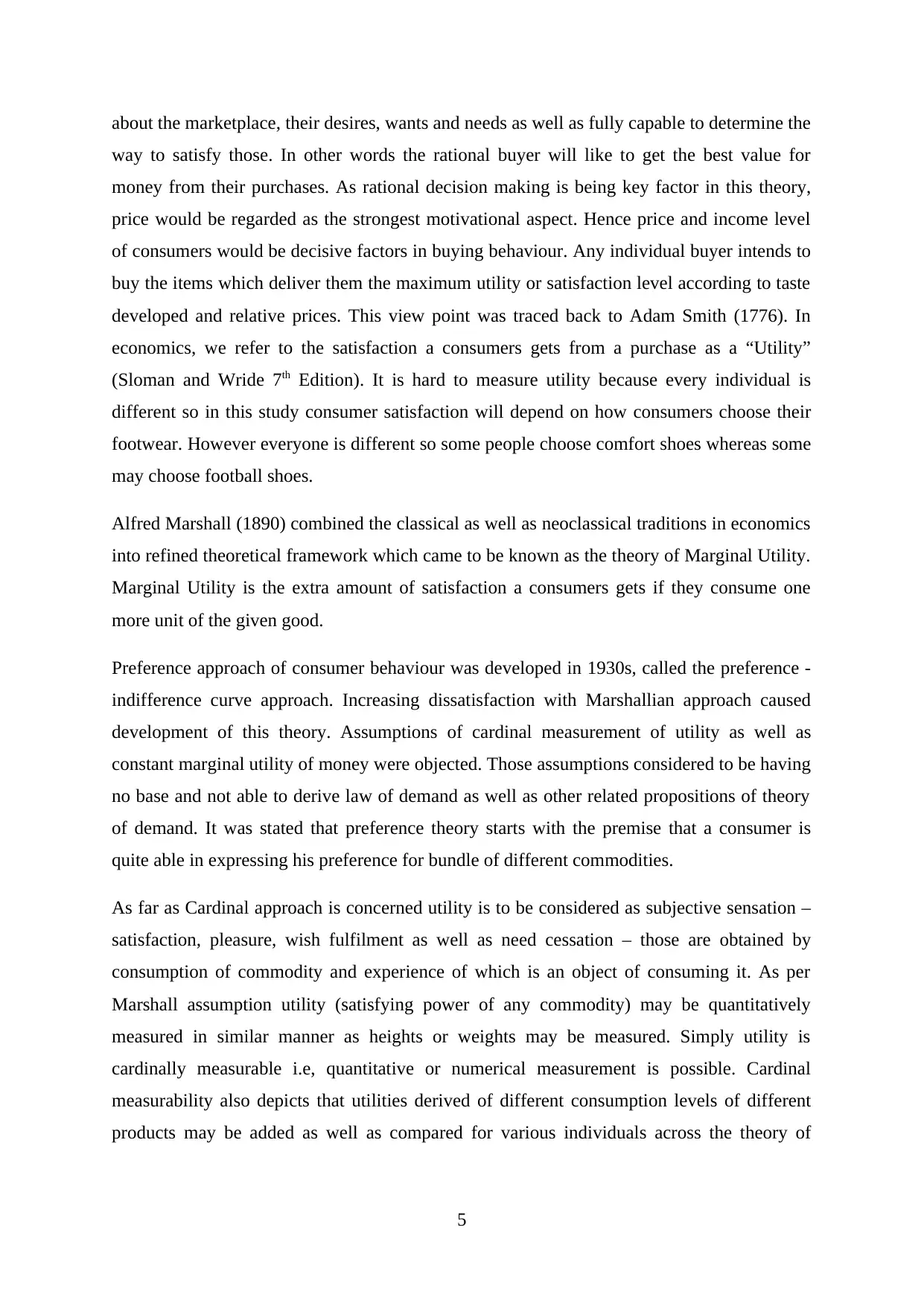
about the marketplace, their desires, wants and needs as well as fully capable to determine the
way to satisfy those. In other words the rational buyer will like to get the best value for
money from their purchases. As rational decision making is being key factor in this theory,
price would be regarded as the strongest motivational aspect. Hence price and income level
of consumers would be decisive factors in buying behaviour. Any individual buyer intends to
buy the items which deliver them the maximum utility or satisfaction level according to taste
developed and relative prices. This view point was traced back to Adam Smith (1776). In
economics, we refer to the satisfaction a consumers gets from a purchase as a “Utility”
(Sloman and Wride 7th Edition). It is hard to measure utility because every individual is
different so in this study consumer satisfaction will depend on how consumers choose their
footwear. However everyone is different so some people choose comfort shoes whereas some
may choose football shoes.
Alfred Marshall (1890) combined the classical as well as neoclassical traditions in economics
into refined theoretical framework which came to be known as the theory of Marginal Utility.
Marginal Utility is the extra amount of satisfaction a consumers gets if they consume one
more unit of the given good.
Preference approach of consumer behaviour was developed in 1930s, called the preference -
indifference curve approach. Increasing dissatisfaction with Marshallian approach caused
development of this theory. Assumptions of cardinal measurement of utility as well as
constant marginal utility of money were objected. Those assumptions considered to be having
no base and not able to derive law of demand as well as other related propositions of theory
of demand. It was stated that preference theory starts with the premise that a consumer is
quite able in expressing his preference for bundle of different commodities.
As far as Cardinal approach is concerned utility is to be considered as subjective sensation –
satisfaction, pleasure, wish fulfilment as well as need cessation – those are obtained by
consumption of commodity and experience of which is an object of consuming it. As per
Marshall assumption utility (satisfying power of any commodity) may be quantitatively
measured in similar manner as heights or weights may be measured. Simply utility is
cardinally measurable i.e, quantitative or numerical measurement is possible. Cardinal
measurability also depicts that utilities derived of different consumption levels of different
products may be added as well as compared for various individuals across the theory of
5
way to satisfy those. In other words the rational buyer will like to get the best value for
money from their purchases. As rational decision making is being key factor in this theory,
price would be regarded as the strongest motivational aspect. Hence price and income level
of consumers would be decisive factors in buying behaviour. Any individual buyer intends to
buy the items which deliver them the maximum utility or satisfaction level according to taste
developed and relative prices. This view point was traced back to Adam Smith (1776). In
economics, we refer to the satisfaction a consumers gets from a purchase as a “Utility”
(Sloman and Wride 7th Edition). It is hard to measure utility because every individual is
different so in this study consumer satisfaction will depend on how consumers choose their
footwear. However everyone is different so some people choose comfort shoes whereas some
may choose football shoes.
Alfred Marshall (1890) combined the classical as well as neoclassical traditions in economics
into refined theoretical framework which came to be known as the theory of Marginal Utility.
Marginal Utility is the extra amount of satisfaction a consumers gets if they consume one
more unit of the given good.
Preference approach of consumer behaviour was developed in 1930s, called the preference -
indifference curve approach. Increasing dissatisfaction with Marshallian approach caused
development of this theory. Assumptions of cardinal measurement of utility as well as
constant marginal utility of money were objected. Those assumptions considered to be having
no base and not able to derive law of demand as well as other related propositions of theory
of demand. It was stated that preference theory starts with the premise that a consumer is
quite able in expressing his preference for bundle of different commodities.
As far as Cardinal approach is concerned utility is to be considered as subjective sensation –
satisfaction, pleasure, wish fulfilment as well as need cessation – those are obtained by
consumption of commodity and experience of which is an object of consuming it. As per
Marshall assumption utility (satisfying power of any commodity) may be quantitatively
measured in similar manner as heights or weights may be measured. Simply utility is
cardinally measurable i.e, quantitative or numerical measurement is possible. Cardinal
measurability also depicts that utilities derived of different consumption levels of different
products may be added as well as compared for various individuals across the theory of
5
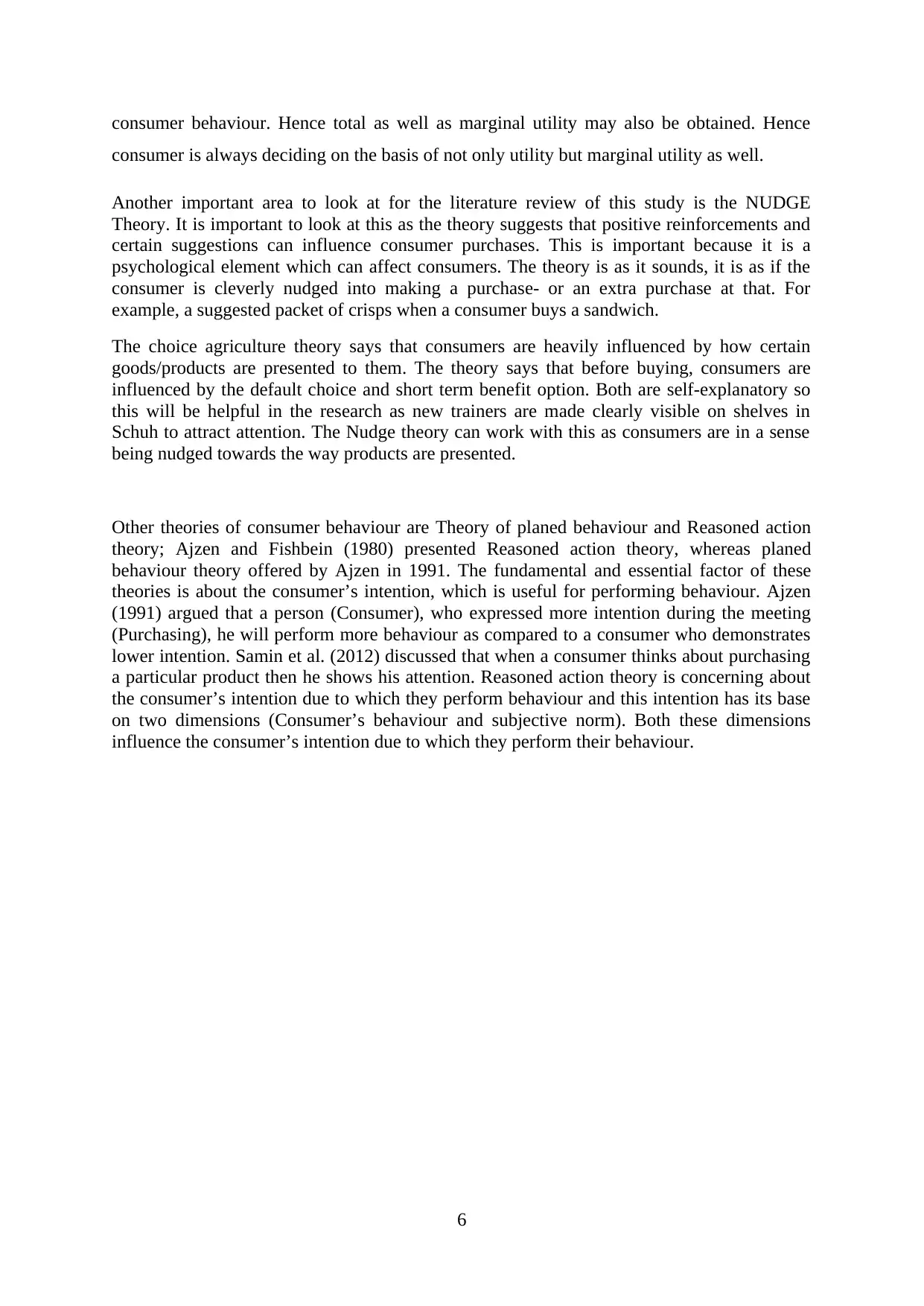
consumer behaviour. Hence total as well as marginal utility may also be obtained. Hence
consumer is always deciding on the basis of not only utility but marginal utility as well.
Another important area to look at for the literature review of this study is the NUDGE
Theory. It is important to look at this as the theory suggests that positive reinforcements and
certain suggestions can influence consumer purchases. This is important because it is a
psychological element which can affect consumers. The theory is as it sounds, it is as if the
consumer is cleverly nudged into making a purchase- or an extra purchase at that. For
example, a suggested packet of crisps when a consumer buys a sandwich.
The choice agriculture theory says that consumers are heavily influenced by how certain
goods/products are presented to them. The theory says that before buying, consumers are
influenced by the default choice and short term benefit option. Both are self-explanatory so
this will be helpful in the research as new trainers are made clearly visible on shelves in
Schuh to attract attention. The Nudge theory can work with this as consumers are in a sense
being nudged towards the way products are presented.
Other theories of consumer behaviour are Theory of planed behaviour and Reasoned action
theory; Ajzen and Fishbein (1980) presented Reasoned action theory, whereas planed
behaviour theory offered by Ajzen in 1991. The fundamental and essential factor of these
theories is about the consumer’s intention, which is useful for performing behaviour. Ajzen
(1991) argued that a person (Consumer), who expressed more intention during the meeting
(Purchasing), he will perform more behaviour as compared to a consumer who demonstrates
lower intention. Samin et al. (2012) discussed that when a consumer thinks about purchasing
a particular product then he shows his attention. Reasoned action theory is concerning about
the consumer’s intention due to which they perform behaviour and this intention has its base
on two dimensions (Consumer’s behaviour and subjective norm). Both these dimensions
influence the consumer’s intention due to which they perform their behaviour.
6
consumer is always deciding on the basis of not only utility but marginal utility as well.
Another important area to look at for the literature review of this study is the NUDGE
Theory. It is important to look at this as the theory suggests that positive reinforcements and
certain suggestions can influence consumer purchases. This is important because it is a
psychological element which can affect consumers. The theory is as it sounds, it is as if the
consumer is cleverly nudged into making a purchase- or an extra purchase at that. For
example, a suggested packet of crisps when a consumer buys a sandwich.
The choice agriculture theory says that consumers are heavily influenced by how certain
goods/products are presented to them. The theory says that before buying, consumers are
influenced by the default choice and short term benefit option. Both are self-explanatory so
this will be helpful in the research as new trainers are made clearly visible on shelves in
Schuh to attract attention. The Nudge theory can work with this as consumers are in a sense
being nudged towards the way products are presented.
Other theories of consumer behaviour are Theory of planed behaviour and Reasoned action
theory; Ajzen and Fishbein (1980) presented Reasoned action theory, whereas planed
behaviour theory offered by Ajzen in 1991. The fundamental and essential factor of these
theories is about the consumer’s intention, which is useful for performing behaviour. Ajzen
(1991) argued that a person (Consumer), who expressed more intention during the meeting
(Purchasing), he will perform more behaviour as compared to a consumer who demonstrates
lower intention. Samin et al. (2012) discussed that when a consumer thinks about purchasing
a particular product then he shows his attention. Reasoned action theory is concerning about
the consumer’s intention due to which they perform behaviour and this intention has its base
on two dimensions (Consumer’s behaviour and subjective norm). Both these dimensions
influence the consumer’s intention due to which they perform their behaviour.
6
Paraphrase This Document
Need a fresh take? Get an instant paraphrase of this document with our AI Paraphraser
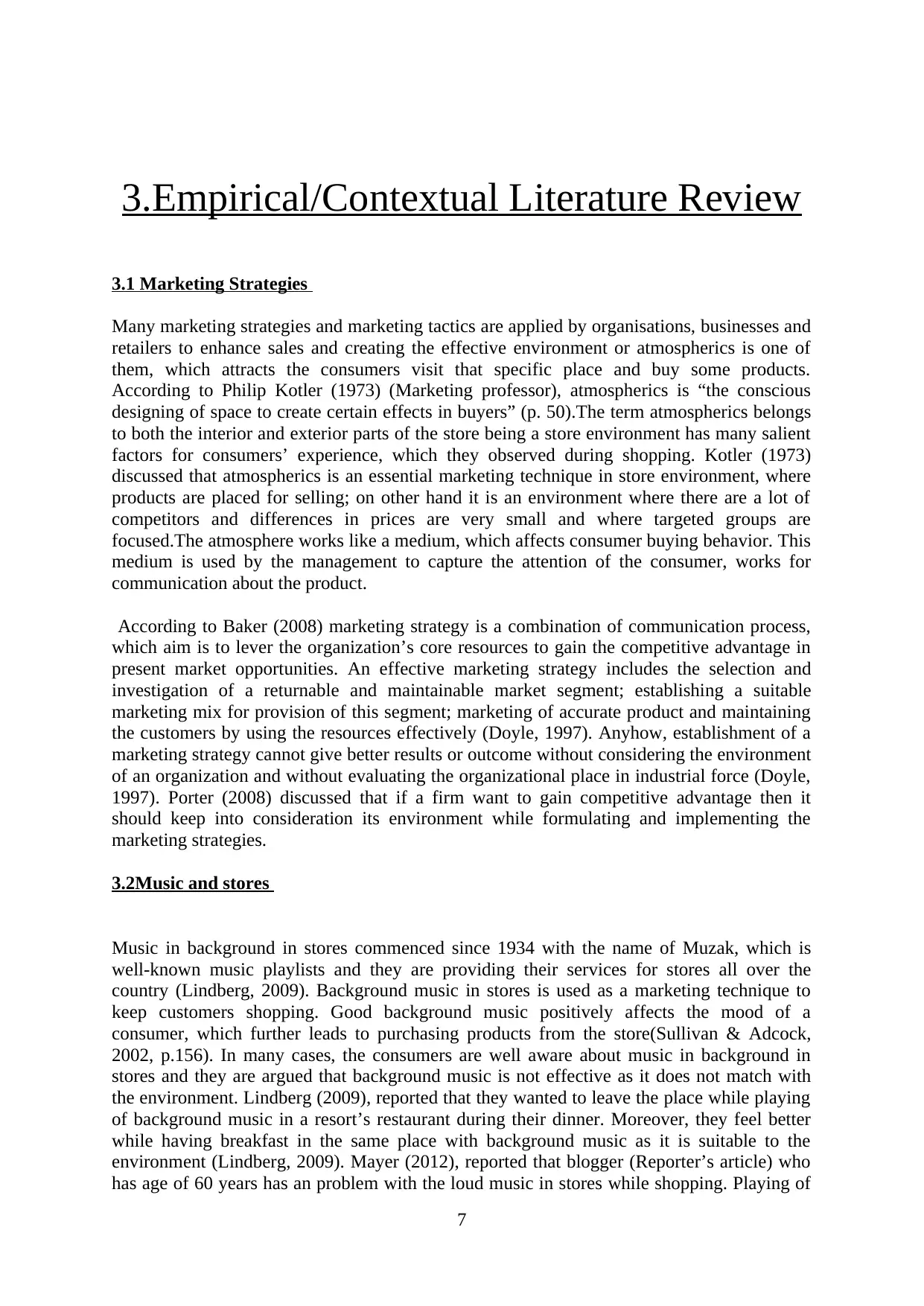
3.Empirical/Contextual Literature Review
3.1 Marketing Strategies
Many marketing strategies and marketing tactics are applied by organisations, businesses and
retailers to enhance sales and creating the effective environment or atmospherics is one of
them, which attracts the consumers visit that specific place and buy some products.
According to Philip Kotler (1973) (Marketing professor), atmospherics is “the conscious
designing of space to create certain effects in buyers” (p. 50).The term atmospherics belongs
to both the interior and exterior parts of the store being a store environment has many salient
factors for consumers’ experience, which they observed during shopping. Kotler (1973)
discussed that atmospherics is an essential marketing technique in store environment, where
products are placed for selling; on other hand it is an environment where there are a lot of
competitors and differences in prices are very small and where targeted groups are
focused.The atmosphere works like a medium, which affects consumer buying behavior. This
medium is used by the management to capture the attention of the consumer, works for
communication about the product.
According to Baker (2008) marketing strategy is a combination of communication process,
which aim is to lever the organization’s core resources to gain the competitive advantage in
present market opportunities. An effective marketing strategy includes the selection and
investigation of a returnable and maintainable market segment; establishing a suitable
marketing mix for provision of this segment; marketing of accurate product and maintaining
the customers by using the resources effectively (Doyle, 1997). Anyhow, establishment of a
marketing strategy cannot give better results or outcome without considering the environment
of an organization and without evaluating the organizational place in industrial force (Doyle,
1997). Porter (2008) discussed that if a firm want to gain competitive advantage then it
should keep into consideration its environment while formulating and implementing the
marketing strategies.
3.2Music and stores
Music in background in stores commenced since 1934 with the name of Muzak, which is
well-known music playlists and they are providing their services for stores all over the
country (Lindberg, 2009). Background music in stores is used as a marketing technique to
keep customers shopping. Good background music positively affects the mood of a
consumer, which further leads to purchasing products from the store(Sullivan & Adcock,
2002, p.156). In many cases, the consumers are well aware about music in background in
stores and they are argued that background music is not effective as it does not match with
the environment. Lindberg (2009), reported that they wanted to leave the place while playing
of background music in a resort’s restaurant during their dinner. Moreover, they feel better
while having breakfast in the same place with background music as it is suitable to the
environment (Lindberg, 2009). Mayer (2012), reported that blogger (Reporter’s article) who
has age of 60 years has an problem with the loud music in stores while shopping. Playing of
7
3.1 Marketing Strategies
Many marketing strategies and marketing tactics are applied by organisations, businesses and
retailers to enhance sales and creating the effective environment or atmospherics is one of
them, which attracts the consumers visit that specific place and buy some products.
According to Philip Kotler (1973) (Marketing professor), atmospherics is “the conscious
designing of space to create certain effects in buyers” (p. 50).The term atmospherics belongs
to both the interior and exterior parts of the store being a store environment has many salient
factors for consumers’ experience, which they observed during shopping. Kotler (1973)
discussed that atmospherics is an essential marketing technique in store environment, where
products are placed for selling; on other hand it is an environment where there are a lot of
competitors and differences in prices are very small and where targeted groups are
focused.The atmosphere works like a medium, which affects consumer buying behavior. This
medium is used by the management to capture the attention of the consumer, works for
communication about the product.
According to Baker (2008) marketing strategy is a combination of communication process,
which aim is to lever the organization’s core resources to gain the competitive advantage in
present market opportunities. An effective marketing strategy includes the selection and
investigation of a returnable and maintainable market segment; establishing a suitable
marketing mix for provision of this segment; marketing of accurate product and maintaining
the customers by using the resources effectively (Doyle, 1997). Anyhow, establishment of a
marketing strategy cannot give better results or outcome without considering the environment
of an organization and without evaluating the organizational place in industrial force (Doyle,
1997). Porter (2008) discussed that if a firm want to gain competitive advantage then it
should keep into consideration its environment while formulating and implementing the
marketing strategies.
3.2Music and stores
Music in background in stores commenced since 1934 with the name of Muzak, which is
well-known music playlists and they are providing their services for stores all over the
country (Lindberg, 2009). Background music in stores is used as a marketing technique to
keep customers shopping. Good background music positively affects the mood of a
consumer, which further leads to purchasing products from the store(Sullivan & Adcock,
2002, p.156). In many cases, the consumers are well aware about music in background in
stores and they are argued that background music is not effective as it does not match with
the environment. Lindberg (2009), reported that they wanted to leave the place while playing
of background music in a resort’s restaurant during their dinner. Moreover, they feel better
while having breakfast in the same place with background music as it is suitable to the
environment (Lindberg, 2009). Mayer (2012), reported that blogger (Reporter’s article) who
has age of 60 years has an problem with the loud music in stores while shopping. Playing of
7
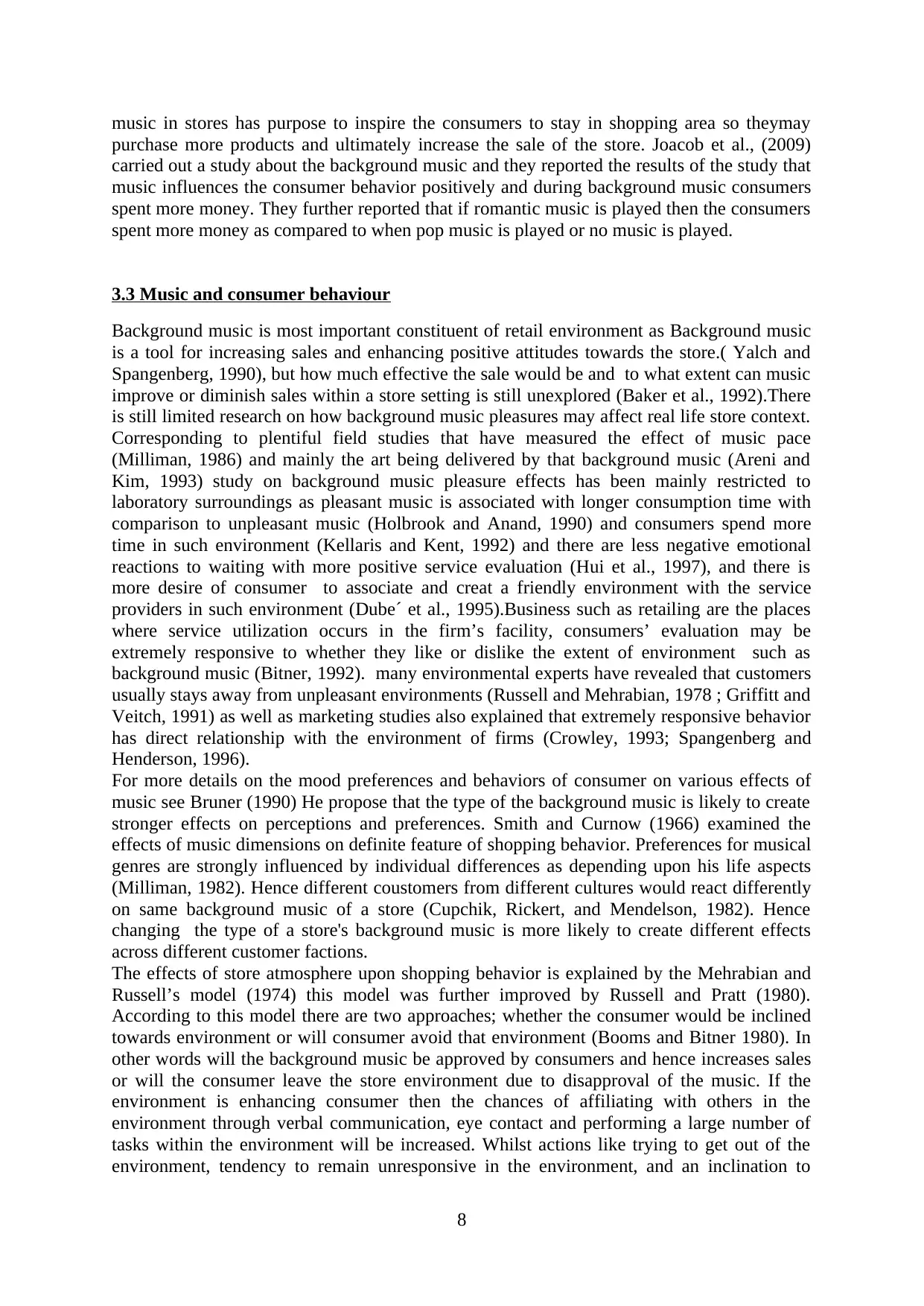
music in stores has purpose to inspire the consumers to stay in shopping area so theymay
purchase more products and ultimately increase the sale of the store. Joacob et al., (2009)
carried out a study about the background music and they reported the results of the study that
music influences the consumer behavior positively and during background music consumers
spent more money. They further reported that if romantic music is played then the consumers
spent more money as compared to when pop music is played or no music is played.
3.3 Music and consumer behaviour
Background music is most important constituent of retail environment as Background music
is a tool for increasing sales and enhancing positive attitudes towards the store.( Yalch and
Spangenberg, 1990), but how much effective the sale would be and to what extent can music
improve or diminish sales within a store setting is still unexplored (Baker et al., 1992).There
is still limited research on how background music pleasures may affect real life store context.
Corresponding to plentiful field studies that have measured the effect of music pace
(Milliman, 1986) and mainly the art being delivered by that background music (Areni and
Kim, 1993) study on background music pleasure effects has been mainly restricted to
laboratory surroundings as pleasant music is associated with longer consumption time with
comparison to unpleasant music (Holbrook and Anand, 1990) and consumers spend more
time in such environment (Kellaris and Kent, 1992) and there are less negative emotional
reactions to waiting with more positive service evaluation (Hui et al., 1997), and there is
more desire of consumer to associate and creat a friendly environment with the service
providers in such environment (Dube´ et al., 1995).Business such as retailing are the places
where service utilization occurs in the firm’s facility, consumers’ evaluation may be
extremely responsive to whether they like or dislike the extent of environment such as
background music (Bitner, 1992). many environmental experts have revealed that customers
usually stays away from unpleasant environments (Russell and Mehrabian, 1978 ; Griffitt and
Veitch, 1991) as well as marketing studies also explained that extremely responsive behavior
has direct relationship with the environment of firms (Crowley, 1993; Spangenberg and
Henderson, 1996).
For more details on the mood preferences and behaviors of consumer on various effects of
music see Bruner (1990) He propose that the type of the background music is likely to create
stronger effects on perceptions and preferences. Smith and Curnow (1966) examined the
effects of music dimensions on definite feature of shopping behavior. Preferences for musical
genres are strongly influenced by individual differences as depending upon his life aspects
(Milliman, 1982). Hence different coustomers from different cultures would react differently
on same background music of a store (Cupchik, Rickert, and Mendelson, 1982). Hence
changing the type of a store's background music is more likely to create different effects
across different customer factions.
The effects of store atmosphere upon shopping behavior is explained by the Mehrabian and
Russell’s model (1974) this model was further improved by Russell and Pratt (1980).
According to this model there are two approaches; whether the consumer would be inclined
towards environment or will consumer avoid that environment (Booms and Bitner 1980). In
other words will the background music be approved by consumers and hence increases sales
or will the consumer leave the store environment due to disapproval of the music. If the
environment is enhancing consumer then the chances of affiliating with others in the
environment through verbal communication, eye contact and performing a large number of
tasks within the environment will be increased. Whilst actions like trying to get out of the
environment, tendency to remain unresponsive in the environment, and an inclination to
8
purchase more products and ultimately increase the sale of the store. Joacob et al., (2009)
carried out a study about the background music and they reported the results of the study that
music influences the consumer behavior positively and during background music consumers
spent more money. They further reported that if romantic music is played then the consumers
spent more money as compared to when pop music is played or no music is played.
3.3 Music and consumer behaviour
Background music is most important constituent of retail environment as Background music
is a tool for increasing sales and enhancing positive attitudes towards the store.( Yalch and
Spangenberg, 1990), but how much effective the sale would be and to what extent can music
improve or diminish sales within a store setting is still unexplored (Baker et al., 1992).There
is still limited research on how background music pleasures may affect real life store context.
Corresponding to plentiful field studies that have measured the effect of music pace
(Milliman, 1986) and mainly the art being delivered by that background music (Areni and
Kim, 1993) study on background music pleasure effects has been mainly restricted to
laboratory surroundings as pleasant music is associated with longer consumption time with
comparison to unpleasant music (Holbrook and Anand, 1990) and consumers spend more
time in such environment (Kellaris and Kent, 1992) and there are less negative emotional
reactions to waiting with more positive service evaluation (Hui et al., 1997), and there is
more desire of consumer to associate and creat a friendly environment with the service
providers in such environment (Dube´ et al., 1995).Business such as retailing are the places
where service utilization occurs in the firm’s facility, consumers’ evaluation may be
extremely responsive to whether they like or dislike the extent of environment such as
background music (Bitner, 1992). many environmental experts have revealed that customers
usually stays away from unpleasant environments (Russell and Mehrabian, 1978 ; Griffitt and
Veitch, 1991) as well as marketing studies also explained that extremely responsive behavior
has direct relationship with the environment of firms (Crowley, 1993; Spangenberg and
Henderson, 1996).
For more details on the mood preferences and behaviors of consumer on various effects of
music see Bruner (1990) He propose that the type of the background music is likely to create
stronger effects on perceptions and preferences. Smith and Curnow (1966) examined the
effects of music dimensions on definite feature of shopping behavior. Preferences for musical
genres are strongly influenced by individual differences as depending upon his life aspects
(Milliman, 1982). Hence different coustomers from different cultures would react differently
on same background music of a store (Cupchik, Rickert, and Mendelson, 1982). Hence
changing the type of a store's background music is more likely to create different effects
across different customer factions.
The effects of store atmosphere upon shopping behavior is explained by the Mehrabian and
Russell’s model (1974) this model was further improved by Russell and Pratt (1980).
According to this model there are two approaches; whether the consumer would be inclined
towards environment or will consumer avoid that environment (Booms and Bitner 1980). In
other words will the background music be approved by consumers and hence increases sales
or will the consumer leave the store environment due to disapproval of the music. If the
environment is enhancing consumer then the chances of affiliating with others in the
environment through verbal communication, eye contact and performing a large number of
tasks within the environment will be increased. Whilst actions like trying to get out of the
environment, tendency to remain unresponsive in the environment, and an inclination to
8
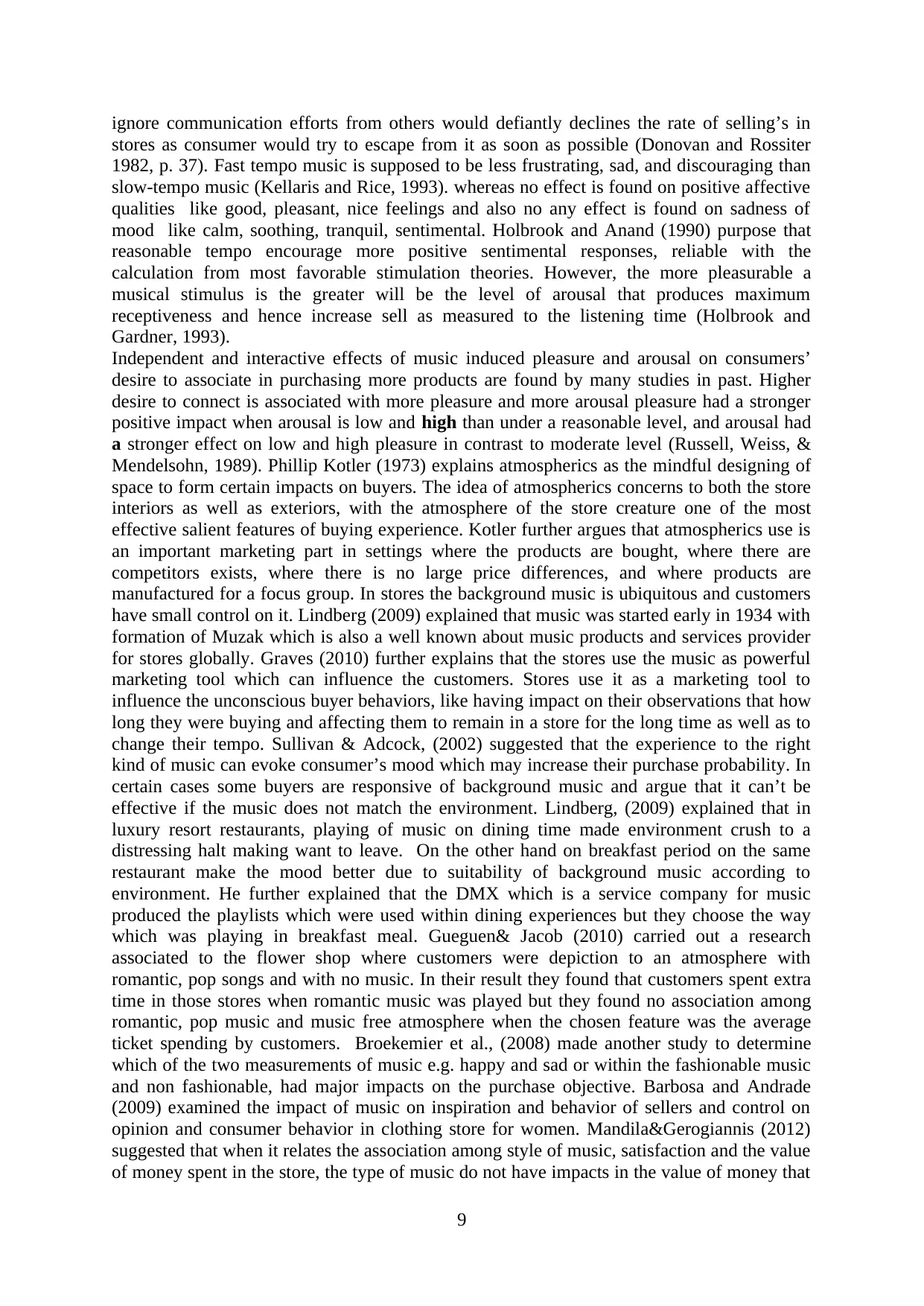
ignore communication efforts from others would defiantly declines the rate of selling’s in
stores as consumer would try to escape from it as soon as possible (Donovan and Rossiter
1982, p. 37). Fast tempo music is supposed to be less frustrating, sad, and discouraging than
slow-tempo music (Kellaris and Rice, 1993). whereas no effect is found on positive affective
qualities like good, pleasant, nice feelings and also no any effect is found on sadness of
mood like calm, soothing, tranquil, sentimental. Holbrook and Anand (1990) purpose that
reasonable tempo encourage more positive sentimental responses, reliable with the
calculation from most favorable stimulation theories. However, the more pleasurable a
musical stimulus is the greater will be the level of arousal that produces maximum
receptiveness and hence increase sell as measured to the listening time (Holbrook and
Gardner, 1993).
Independent and interactive effects of music induced pleasure and arousal on consumers’
desire to associate in purchasing more products are found by many studies in past. Higher
desire to connect is associated with more pleasure and more arousal pleasure had a stronger
positive impact when arousal is low and high than under a reasonable level, and arousal had
a stronger effect on low and high pleasure in contrast to moderate level (Russell, Weiss, &
Mendelsohn, 1989). Phillip Kotler (1973) explains atmospherics as the mindful designing of
space to form certain impacts on buyers. The idea of atmospherics concerns to both the store
interiors as well as exteriors, with the atmosphere of the store creature one of the most
effective salient features of buying experience. Kotler further argues that atmospherics use is
an important marketing part in settings where the products are bought, where there are
competitors exists, where there is no large price differences, and where products are
manufactured for a focus group. In stores the background music is ubiquitous and customers
have small control on it. Lindberg (2009) explained that music was started early in 1934 with
formation of Muzak which is also a well known about music products and services provider
for stores globally. Graves (2010) further explains that the stores use the music as powerful
marketing tool which can influence the customers. Stores use it as a marketing tool to
influence the unconscious buyer behaviors, like having impact on their observations that how
long they were buying and affecting them to remain in a store for the long time as well as to
change their tempo. Sullivan & Adcock, (2002) suggested that the experience to the right
kind of music can evoke consumer’s mood which may increase their purchase probability. In
certain cases some buyers are responsive of background music and argue that it can’t be
effective if the music does not match the environment. Lindberg, (2009) explained that in
luxury resort restaurants, playing of music on dining time made environment crush to a
distressing halt making want to leave. On the other hand on breakfast period on the same
restaurant make the mood better due to suitability of background music according to
environment. He further explained that the DMX which is a service company for music
produced the playlists which were used within dining experiences but they choose the way
which was playing in breakfast meal. Gueguen& Jacob (2010) carried out a research
associated to the flower shop where customers were depiction to an atmosphere with
romantic, pop songs and with no music. In their result they found that customers spent extra
time in those stores when romantic music was played but they found no association among
romantic, pop music and music free atmosphere when the chosen feature was the average
ticket spending by customers. Broekemier et al., (2008) made another study to determine
which of the two measurements of music e.g. happy and sad or within the fashionable music
and non fashionable, had major impacts on the purchase objective. Barbosa and Andrade
(2009) examined the impact of music on inspiration and behavior of sellers and control on
opinion and consumer behavior in clothing store for women. Mandila&Gerogiannis (2012)
suggested that when it relates the association among style of music, satisfaction and the value
of money spent in the store, the type of music do not have impacts in the value of money that
9
stores as consumer would try to escape from it as soon as possible (Donovan and Rossiter
1982, p. 37). Fast tempo music is supposed to be less frustrating, sad, and discouraging than
slow-tempo music (Kellaris and Rice, 1993). whereas no effect is found on positive affective
qualities like good, pleasant, nice feelings and also no any effect is found on sadness of
mood like calm, soothing, tranquil, sentimental. Holbrook and Anand (1990) purpose that
reasonable tempo encourage more positive sentimental responses, reliable with the
calculation from most favorable stimulation theories. However, the more pleasurable a
musical stimulus is the greater will be the level of arousal that produces maximum
receptiveness and hence increase sell as measured to the listening time (Holbrook and
Gardner, 1993).
Independent and interactive effects of music induced pleasure and arousal on consumers’
desire to associate in purchasing more products are found by many studies in past. Higher
desire to connect is associated with more pleasure and more arousal pleasure had a stronger
positive impact when arousal is low and high than under a reasonable level, and arousal had
a stronger effect on low and high pleasure in contrast to moderate level (Russell, Weiss, &
Mendelsohn, 1989). Phillip Kotler (1973) explains atmospherics as the mindful designing of
space to form certain impacts on buyers. The idea of atmospherics concerns to both the store
interiors as well as exteriors, with the atmosphere of the store creature one of the most
effective salient features of buying experience. Kotler further argues that atmospherics use is
an important marketing part in settings where the products are bought, where there are
competitors exists, where there is no large price differences, and where products are
manufactured for a focus group. In stores the background music is ubiquitous and customers
have small control on it. Lindberg (2009) explained that music was started early in 1934 with
formation of Muzak which is also a well known about music products and services provider
for stores globally. Graves (2010) further explains that the stores use the music as powerful
marketing tool which can influence the customers. Stores use it as a marketing tool to
influence the unconscious buyer behaviors, like having impact on their observations that how
long they were buying and affecting them to remain in a store for the long time as well as to
change their tempo. Sullivan & Adcock, (2002) suggested that the experience to the right
kind of music can evoke consumer’s mood which may increase their purchase probability. In
certain cases some buyers are responsive of background music and argue that it can’t be
effective if the music does not match the environment. Lindberg, (2009) explained that in
luxury resort restaurants, playing of music on dining time made environment crush to a
distressing halt making want to leave. On the other hand on breakfast period on the same
restaurant make the mood better due to suitability of background music according to
environment. He further explained that the DMX which is a service company for music
produced the playlists which were used within dining experiences but they choose the way
which was playing in breakfast meal. Gueguen& Jacob (2010) carried out a research
associated to the flower shop where customers were depiction to an atmosphere with
romantic, pop songs and with no music. In their result they found that customers spent extra
time in those stores when romantic music was played but they found no association among
romantic, pop music and music free atmosphere when the chosen feature was the average
ticket spending by customers. Broekemier et al., (2008) made another study to determine
which of the two measurements of music e.g. happy and sad or within the fashionable music
and non fashionable, had major impacts on the purchase objective. Barbosa and Andrade
(2009) examined the impact of music on inspiration and behavior of sellers and control on
opinion and consumer behavior in clothing store for women. Mandila&Gerogiannis (2012)
suggested that when it relates the association among style of music, satisfaction and the value
of money spent in the store, the type of music do not have impacts in the value of money that
9
Secure Best Marks with AI Grader
Need help grading? Try our AI Grader for instant feedback on your assignments.
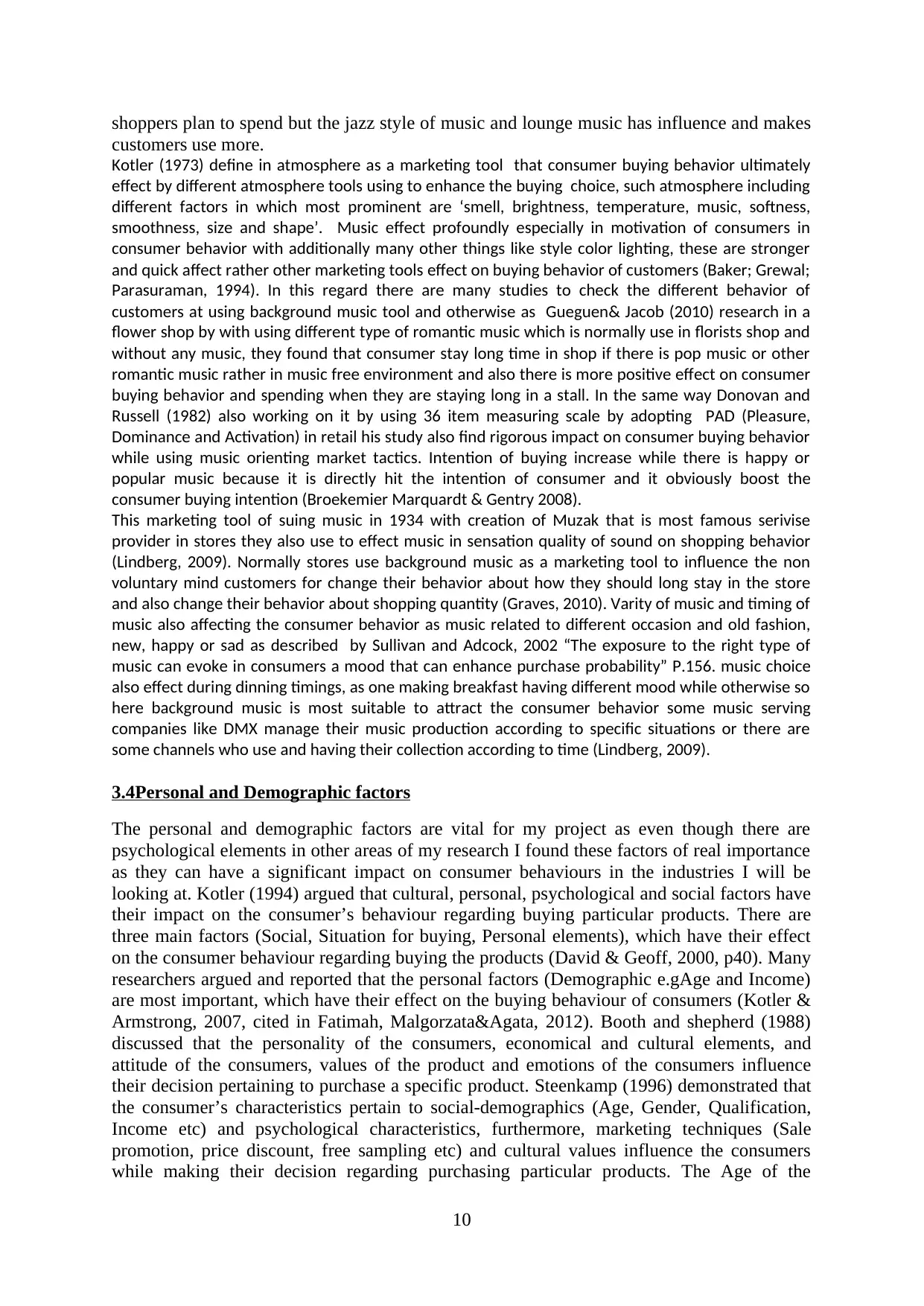
shoppers plan to spend but the jazz style of music and lounge music has influence and makes
customers use more.
Kotler (1973) define in atmosphere as a marketing tool that consumer buying behavior ultimately
effect by different atmosphere tools using to enhance the buying choice, such atmosphere including
different factors in which most prominent are ‘smell, brightness, temperature, music, softness,
smoothness, size and shape’. Music effect profoundly especially in motivation of consumers in
consumer behavior with additionally many other things like style color lighting, these are stronger
and quick affect rather other marketing tools effect on buying behavior of customers (Baker; Grewal;
Parasuraman, 1994). In this regard there are many studies to check the different behavior of
customers at using background music tool and otherwise as Gueguen& Jacob (2010) research in a
flower shop by with using different type of romantic music which is normally use in florists shop and
without any music, they found that consumer stay long time in shop if there is pop music or other
romantic music rather in music free environment and also there is more positive effect on consumer
buying behavior and spending when they are staying long in a stall. In the same way Donovan and
Russell (1982) also working on it by using 36 item measuring scale by adopting PAD (Pleasure,
Dominance and Activation) in retail his study also find rigorous impact on consumer buying behavior
while using music orienting market tactics. Intention of buying increase while there is happy or
popular music because it is directly hit the intention of consumer and it obviously boost the
consumer buying intention (Broekemier Marquardt & Gentry 2008).
This marketing tool of suing music in 1934 with creation of Muzak that is most famous serivise
provider in stores they also use to effect music in sensation quality of sound on shopping behavior
(Lindberg, 2009). Normally stores use background music as a marketing tool to influence the non
voluntary mind customers for change their behavior about how they should long stay in the store
and also change their behavior about shopping quantity (Graves, 2010). Varity of music and timing of
music also affecting the consumer behavior as music related to different occasion and old fashion,
new, happy or sad as described by Sullivan and Adcock, 2002 “The exposure to the right type of
music can evoke in consumers a mood that can enhance purchase probability” P.156. music choice
also effect during dinning timings, as one making breakfast having different mood while otherwise so
here background music is most suitable to attract the consumer behavior some music serving
companies like DMX manage their music production according to specific situations or there are
some channels who use and having their collection according to time (Lindberg, 2009).
3.4Personal and Demographic factors
The personal and demographic factors are vital for my project as even though there are
psychological elements in other areas of my research I found these factors of real importance
as they can have a significant impact on consumer behaviours in the industries I will be
looking at. Kotler (1994) argued that cultural, personal, psychological and social factors have
their impact on the consumer’s behaviour regarding buying particular products. There are
three main factors (Social, Situation for buying, Personal elements), which have their effect
on the consumer behaviour regarding buying the products (David & Geoff, 2000, p40). Many
researchers argued and reported that the personal factors (Demographic e.gAge and Income)
are most important, which have their effect on the buying behaviour of consumers (Kotler &
Armstrong, 2007, cited in Fatimah, Malgorzata&Agata, 2012). Booth and shepherd (1988)
discussed that the personality of the consumers, economical and cultural elements, and
attitude of the consumers, values of the product and emotions of the consumers influence
their decision pertaining to purchase a specific product. Steenkamp (1996) demonstrated that
the consumer’s characteristics pertain to social-demographics (Age, Gender, Qualification,
Income etc) and psychological characteristics, furthermore, marketing techniques (Sale
promotion, price discount, free sampling etc) and cultural values influence the consumers
while making their decision regarding purchasing particular products. The Age of the
10
customers use more.
Kotler (1973) define in atmosphere as a marketing tool that consumer buying behavior ultimately
effect by different atmosphere tools using to enhance the buying choice, such atmosphere including
different factors in which most prominent are ‘smell, brightness, temperature, music, softness,
smoothness, size and shape’. Music effect profoundly especially in motivation of consumers in
consumer behavior with additionally many other things like style color lighting, these are stronger
and quick affect rather other marketing tools effect on buying behavior of customers (Baker; Grewal;
Parasuraman, 1994). In this regard there are many studies to check the different behavior of
customers at using background music tool and otherwise as Gueguen& Jacob (2010) research in a
flower shop by with using different type of romantic music which is normally use in florists shop and
without any music, they found that consumer stay long time in shop if there is pop music or other
romantic music rather in music free environment and also there is more positive effect on consumer
buying behavior and spending when they are staying long in a stall. In the same way Donovan and
Russell (1982) also working on it by using 36 item measuring scale by adopting PAD (Pleasure,
Dominance and Activation) in retail his study also find rigorous impact on consumer buying behavior
while using music orienting market tactics. Intention of buying increase while there is happy or
popular music because it is directly hit the intention of consumer and it obviously boost the
consumer buying intention (Broekemier Marquardt & Gentry 2008).
This marketing tool of suing music in 1934 with creation of Muzak that is most famous serivise
provider in stores they also use to effect music in sensation quality of sound on shopping behavior
(Lindberg, 2009). Normally stores use background music as a marketing tool to influence the non
voluntary mind customers for change their behavior about how they should long stay in the store
and also change their behavior about shopping quantity (Graves, 2010). Varity of music and timing of
music also affecting the consumer behavior as music related to different occasion and old fashion,
new, happy or sad as described by Sullivan and Adcock, 2002 “The exposure to the right type of
music can evoke in consumers a mood that can enhance purchase probability” P.156. music choice
also effect during dinning timings, as one making breakfast having different mood while otherwise so
here background music is most suitable to attract the consumer behavior some music serving
companies like DMX manage their music production according to specific situations or there are
some channels who use and having their collection according to time (Lindberg, 2009).
3.4Personal and Demographic factors
The personal and demographic factors are vital for my project as even though there are
psychological elements in other areas of my research I found these factors of real importance
as they can have a significant impact on consumer behaviours in the industries I will be
looking at. Kotler (1994) argued that cultural, personal, psychological and social factors have
their impact on the consumer’s behaviour regarding buying particular products. There are
three main factors (Social, Situation for buying, Personal elements), which have their effect
on the consumer behaviour regarding buying the products (David & Geoff, 2000, p40). Many
researchers argued and reported that the personal factors (Demographic e.gAge and Income)
are most important, which have their effect on the buying behaviour of consumers (Kotler &
Armstrong, 2007, cited in Fatimah, Malgorzata&Agata, 2012). Booth and shepherd (1988)
discussed that the personality of the consumers, economical and cultural elements, and
attitude of the consumers, values of the product and emotions of the consumers influence
their decision pertaining to purchase a specific product. Steenkamp (1996) demonstrated that
the consumer’s characteristics pertain to social-demographics (Age, Gender, Qualification,
Income etc) and psychological characteristics, furthermore, marketing techniques (Sale
promotion, price discount, free sampling etc) and cultural values influence the consumers
while making their decision regarding purchasing particular products. The Age of the
10

consumer has its influence on the buying behaviour of the consumer as with the passage of
time the preference of goods or product is changed. Life cycle of a family is distributed into
several stages e.g. Childhood, young, married and unmarried couples etc. and these stages of
life cycle are conducive for the marketers or producers to provides suitable products
according to each stage (Cherlin 2000).
3.5 Construction of Hypothesis
After reviewing the literature in detail, the following hypothesis is established.
H: Music has positive and significant influence on consumer buying behaviour.
4.Research Methodology
Research type
Qualitative and quantitative are the main two research types that can be selected by
the researcher. For setting highly suitable methodology researcher is required to make
selection of suitable research type. The rationale behind this, selection of further techniques
such as approach, philosophy, data analysis etc. is highly dependent upon the type of
investigation carried out by the scholar. Thus, by considering and evaluating the research
issue scholar can select suitable type. Under qualitative investigation, scholar makes
assessment of reasons and opinions that are associated with the issue which is going to be
investigated. Hence, qualitative investigation is highly significant which in turn helps in
framing hypothesis for the future study or investigation. Such type of investigation helps in
finding suitable solution when sample size is not too large.
On the others side, quantitative investigation implies for the one in which researcher
assesses problem and presents solution by analyzing numeric data set. Hence, with the motive
to derive logical and suitable solution of the problem quantitative research type has been
selected by the scholar. Thus, solution of the issue has been presented by the scholar by
evaluating the responses provided by the customers. By considering such aspect, it can be
stated that quantitative investigation has been carried out by the researcher to get deeper
11
time the preference of goods or product is changed. Life cycle of a family is distributed into
several stages e.g. Childhood, young, married and unmarried couples etc. and these stages of
life cycle are conducive for the marketers or producers to provides suitable products
according to each stage (Cherlin 2000).
3.5 Construction of Hypothesis
After reviewing the literature in detail, the following hypothesis is established.
H: Music has positive and significant influence on consumer buying behaviour.
4.Research Methodology
Research type
Qualitative and quantitative are the main two research types that can be selected by
the researcher. For setting highly suitable methodology researcher is required to make
selection of suitable research type. The rationale behind this, selection of further techniques
such as approach, philosophy, data analysis etc. is highly dependent upon the type of
investigation carried out by the scholar. Thus, by considering and evaluating the research
issue scholar can select suitable type. Under qualitative investigation, scholar makes
assessment of reasons and opinions that are associated with the issue which is going to be
investigated. Hence, qualitative investigation is highly significant which in turn helps in
framing hypothesis for the future study or investigation. Such type of investigation helps in
finding suitable solution when sample size is not too large.
On the others side, quantitative investigation implies for the one in which researcher
assesses problem and presents solution by analyzing numeric data set. Hence, with the motive
to derive logical and suitable solution of the problem quantitative research type has been
selected by the scholar. Thus, solution of the issue has been presented by the scholar by
evaluating the responses provided by the customers. By considering such aspect, it can be
stated that quantitative investigation has been carried out by the researcher to get deeper
11

insight about the impact of music on the buying behavior of individuals. By making
assessment of such aspect researcher would become able to assess the extent to which buying
behavior and decision making aspect of customers of Schujh are influenced.
Research approach
Inductive and deductive are the main two approaches of the research that can be
undertaken to address specific issue or problem. Selection of research approach is highly
based on the type of investigation undertaken. By keeping in mind the type of investigation
undertaken researcher can select suitable approach. Inductive and deductive approach of the
research highly differs from each other to the significant level. In research, inductive
approach helps in finding the best solution when qualitative investigation is undertaken. Such
approach of the research lays high level of emphasis on the generalization of new theoretical
framework.
On the contrary to this, in deductive approach researcher starts with the existing
theoretical framework and thereby tests hypothesis to derive suitable solution from
quantitative data set. Thus, confirmation of hypothesis is one of the main objectives behind
the selection of deductive approach. Hence, the major difference between the two
approaches is that under deductive approach researcher undertakes existing framework. On
the other side, under inductive approach, scholar places emphasis on the development of new
framework. Hence, in this, deductive approach of the research has been selected by the
scholar. The reason behind the adoption of such approach is that it helps in assessing suitable
solution when quantitative data is going to be evaluated. Thus, by undertaking deductive
approach scholar would become able to identify the extent to which buying behavior and
decision making of the customers of UK Footwear retailer such as Schuh is affected from
music. Hence, by undertaking the theories related to customer buying behavior and decision
making hypothesis has been tested by the scholar.
Research philosophy
In the field of research, philosophies provide deeper insight about the manner in
which data will be gathered and analyzed to find out the suitable solution of issue.
Philosophies of the research can be divided into two types such as interpretivism and
positivism. Under interpretivism philosophy scholar presents solution of the issue by
analyzing the assumed qualitative data set. On the other side, positivism philosophy
researcher presents solution by evaluating the given or realistic facts and figures. Research
12
assessment of such aspect researcher would become able to assess the extent to which buying
behavior and decision making aspect of customers of Schujh are influenced.
Research approach
Inductive and deductive are the main two approaches of the research that can be
undertaken to address specific issue or problem. Selection of research approach is highly
based on the type of investigation undertaken. By keeping in mind the type of investigation
undertaken researcher can select suitable approach. Inductive and deductive approach of the
research highly differs from each other to the significant level. In research, inductive
approach helps in finding the best solution when qualitative investigation is undertaken. Such
approach of the research lays high level of emphasis on the generalization of new theoretical
framework.
On the contrary to this, in deductive approach researcher starts with the existing
theoretical framework and thereby tests hypothesis to derive suitable solution from
quantitative data set. Thus, confirmation of hypothesis is one of the main objectives behind
the selection of deductive approach. Hence, the major difference between the two
approaches is that under deductive approach researcher undertakes existing framework. On
the other side, under inductive approach, scholar places emphasis on the development of new
framework. Hence, in this, deductive approach of the research has been selected by the
scholar. The reason behind the adoption of such approach is that it helps in assessing suitable
solution when quantitative data is going to be evaluated. Thus, by undertaking deductive
approach scholar would become able to identify the extent to which buying behavior and
decision making of the customers of UK Footwear retailer such as Schuh is affected from
music. Hence, by undertaking the theories related to customer buying behavior and decision
making hypothesis has been tested by the scholar.
Research philosophy
In the field of research, philosophies provide deeper insight about the manner in
which data will be gathered and analyzed to find out the suitable solution of issue.
Philosophies of the research can be divided into two types such as interpretivism and
positivism. Under interpretivism philosophy scholar presents solution of the issue by
analyzing the assumed qualitative data set. On the other side, positivism philosophy
researcher presents solution by evaluating the given or realistic facts and figures. Research
12
Paraphrase This Document
Need a fresh take? Get an instant paraphrase of this document with our AI Paraphraser
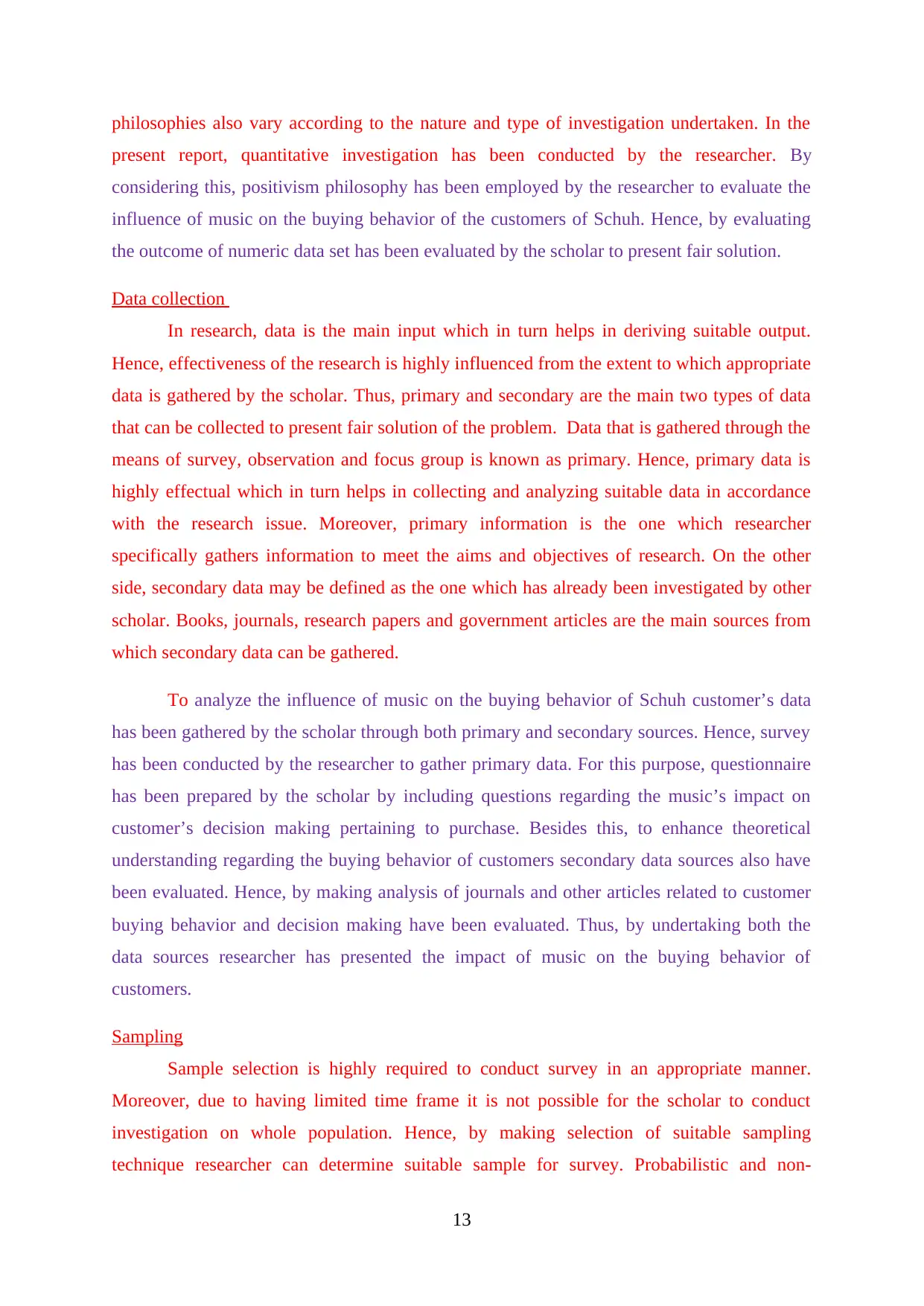
philosophies also vary according to the nature and type of investigation undertaken. In the
present report, quantitative investigation has been conducted by the researcher. By
considering this, positivism philosophy has been employed by the researcher to evaluate the
influence of music on the buying behavior of the customers of Schuh. Hence, by evaluating
the outcome of numeric data set has been evaluated by the scholar to present fair solution.
Data collection
In research, data is the main input which in turn helps in deriving suitable output.
Hence, effectiveness of the research is highly influenced from the extent to which appropriate
data is gathered by the scholar. Thus, primary and secondary are the main two types of data
that can be collected to present fair solution of the problem. Data that is gathered through the
means of survey, observation and focus group is known as primary. Hence, primary data is
highly effectual which in turn helps in collecting and analyzing suitable data in accordance
with the research issue. Moreover, primary information is the one which researcher
specifically gathers information to meet the aims and objectives of research. On the other
side, secondary data may be defined as the one which has already been investigated by other
scholar. Books, journals, research papers and government articles are the main sources from
which secondary data can be gathered.
To analyze the influence of music on the buying behavior of Schuh customer’s data
has been gathered by the scholar through both primary and secondary sources. Hence, survey
has been conducted by the researcher to gather primary data. For this purpose, questionnaire
has been prepared by the scholar by including questions regarding the music’s impact on
customer’s decision making pertaining to purchase. Besides this, to enhance theoretical
understanding regarding the buying behavior of customers secondary data sources also have
been evaluated. Hence, by making analysis of journals and other articles related to customer
buying behavior and decision making have been evaluated. Thus, by undertaking both the
data sources researcher has presented the impact of music on the buying behavior of
customers.
Sampling
Sample selection is highly required to conduct survey in an appropriate manner.
Moreover, due to having limited time frame it is not possible for the scholar to conduct
investigation on whole population. Hence, by making selection of suitable sampling
technique researcher can determine suitable sample for survey. Probabilistic and non-
13
present report, quantitative investigation has been conducted by the researcher. By
considering this, positivism philosophy has been employed by the researcher to evaluate the
influence of music on the buying behavior of the customers of Schuh. Hence, by evaluating
the outcome of numeric data set has been evaluated by the scholar to present fair solution.
Data collection
In research, data is the main input which in turn helps in deriving suitable output.
Hence, effectiveness of the research is highly influenced from the extent to which appropriate
data is gathered by the scholar. Thus, primary and secondary are the main two types of data
that can be collected to present fair solution of the problem. Data that is gathered through the
means of survey, observation and focus group is known as primary. Hence, primary data is
highly effectual which in turn helps in collecting and analyzing suitable data in accordance
with the research issue. Moreover, primary information is the one which researcher
specifically gathers information to meet the aims and objectives of research. On the other
side, secondary data may be defined as the one which has already been investigated by other
scholar. Books, journals, research papers and government articles are the main sources from
which secondary data can be gathered.
To analyze the influence of music on the buying behavior of Schuh customer’s data
has been gathered by the scholar through both primary and secondary sources. Hence, survey
has been conducted by the researcher to gather primary data. For this purpose, questionnaire
has been prepared by the scholar by including questions regarding the music’s impact on
customer’s decision making pertaining to purchase. Besides this, to enhance theoretical
understanding regarding the buying behavior of customers secondary data sources also have
been evaluated. Hence, by making analysis of journals and other articles related to customer
buying behavior and decision making have been evaluated. Thus, by undertaking both the
data sources researcher has presented the impact of music on the buying behavior of
customers.
Sampling
Sample selection is highly required to conduct survey in an appropriate manner.
Moreover, due to having limited time frame it is not possible for the scholar to conduct
investigation on whole population. Hence, by making selection of suitable sampling
technique researcher can determine suitable sample for survey. Probabilistic and non-
13
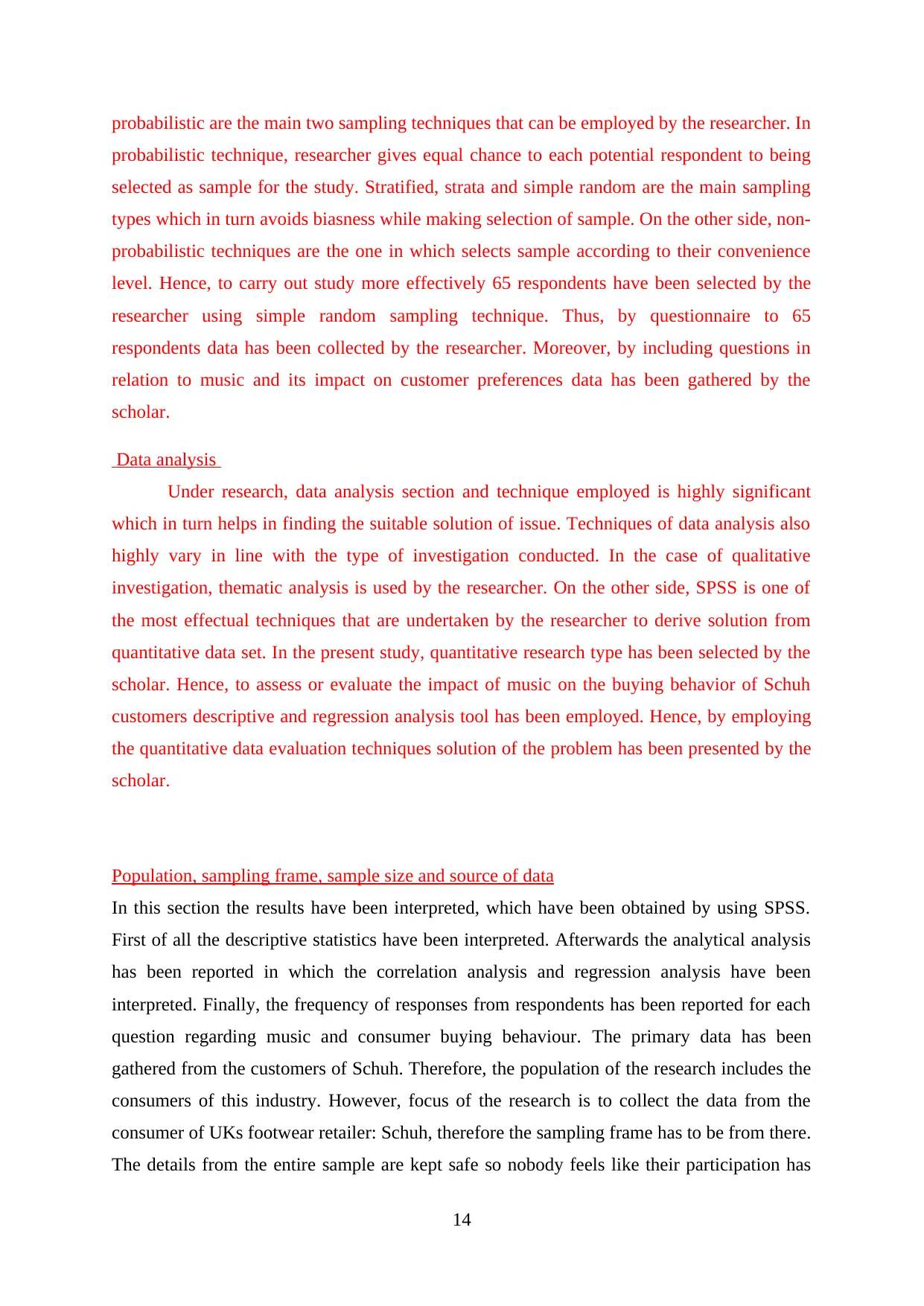
probabilistic are the main two sampling techniques that can be employed by the researcher. In
probabilistic technique, researcher gives equal chance to each potential respondent to being
selected as sample for the study. Stratified, strata and simple random are the main sampling
types which in turn avoids biasness while making selection of sample. On the other side, non-
probabilistic techniques are the one in which selects sample according to their convenience
level. Hence, to carry out study more effectively 65 respondents have been selected by the
researcher using simple random sampling technique. Thus, by questionnaire to 65
respondents data has been collected by the researcher. Moreover, by including questions in
relation to music and its impact on customer preferences data has been gathered by the
scholar.
Data analysis
Under research, data analysis section and technique employed is highly significant
which in turn helps in finding the suitable solution of issue. Techniques of data analysis also
highly vary in line with the type of investigation conducted. In the case of qualitative
investigation, thematic analysis is used by the researcher. On the other side, SPSS is one of
the most effectual techniques that are undertaken by the researcher to derive solution from
quantitative data set. In the present study, quantitative research type has been selected by the
scholar. Hence, to assess or evaluate the impact of music on the buying behavior of Schuh
customers descriptive and regression analysis tool has been employed. Hence, by employing
the quantitative data evaluation techniques solution of the problem has been presented by the
scholar.
Population, sampling frame, sample size and source of data
In this section the results have been interpreted, which have been obtained by using SPSS.
First of all the descriptive statistics have been interpreted. Afterwards the analytical analysis
has been reported in which the correlation analysis and regression analysis have been
interpreted. Finally, the frequency of responses from respondents has been reported for each
question regarding music and consumer buying behaviour. The primary data has been
gathered from the customers of Schuh. Therefore, the population of the research includes the
consumers of this industry. However, focus of the research is to collect the data from the
consumer of UKs footwear retailer: Schuh, therefore the sampling frame has to be from there.
The details from the entire sample are kept safe so nobody feels like their participation has
14
probabilistic technique, researcher gives equal chance to each potential respondent to being
selected as sample for the study. Stratified, strata and simple random are the main sampling
types which in turn avoids biasness while making selection of sample. On the other side, non-
probabilistic techniques are the one in which selects sample according to their convenience
level. Hence, to carry out study more effectively 65 respondents have been selected by the
researcher using simple random sampling technique. Thus, by questionnaire to 65
respondents data has been collected by the researcher. Moreover, by including questions in
relation to music and its impact on customer preferences data has been gathered by the
scholar.
Data analysis
Under research, data analysis section and technique employed is highly significant
which in turn helps in finding the suitable solution of issue. Techniques of data analysis also
highly vary in line with the type of investigation conducted. In the case of qualitative
investigation, thematic analysis is used by the researcher. On the other side, SPSS is one of
the most effectual techniques that are undertaken by the researcher to derive solution from
quantitative data set. In the present study, quantitative research type has been selected by the
scholar. Hence, to assess or evaluate the impact of music on the buying behavior of Schuh
customers descriptive and regression analysis tool has been employed. Hence, by employing
the quantitative data evaluation techniques solution of the problem has been presented by the
scholar.
Population, sampling frame, sample size and source of data
In this section the results have been interpreted, which have been obtained by using SPSS.
First of all the descriptive statistics have been interpreted. Afterwards the analytical analysis
has been reported in which the correlation analysis and regression analysis have been
interpreted. Finally, the frequency of responses from respondents has been reported for each
question regarding music and consumer buying behaviour. The primary data has been
gathered from the customers of Schuh. Therefore, the population of the research includes the
consumers of this industry. However, focus of the research is to collect the data from the
consumer of UKs footwear retailer: Schuh, therefore the sampling frame has to be from there.
The details from the entire sample are kept safe so nobody feels like their participation has
14
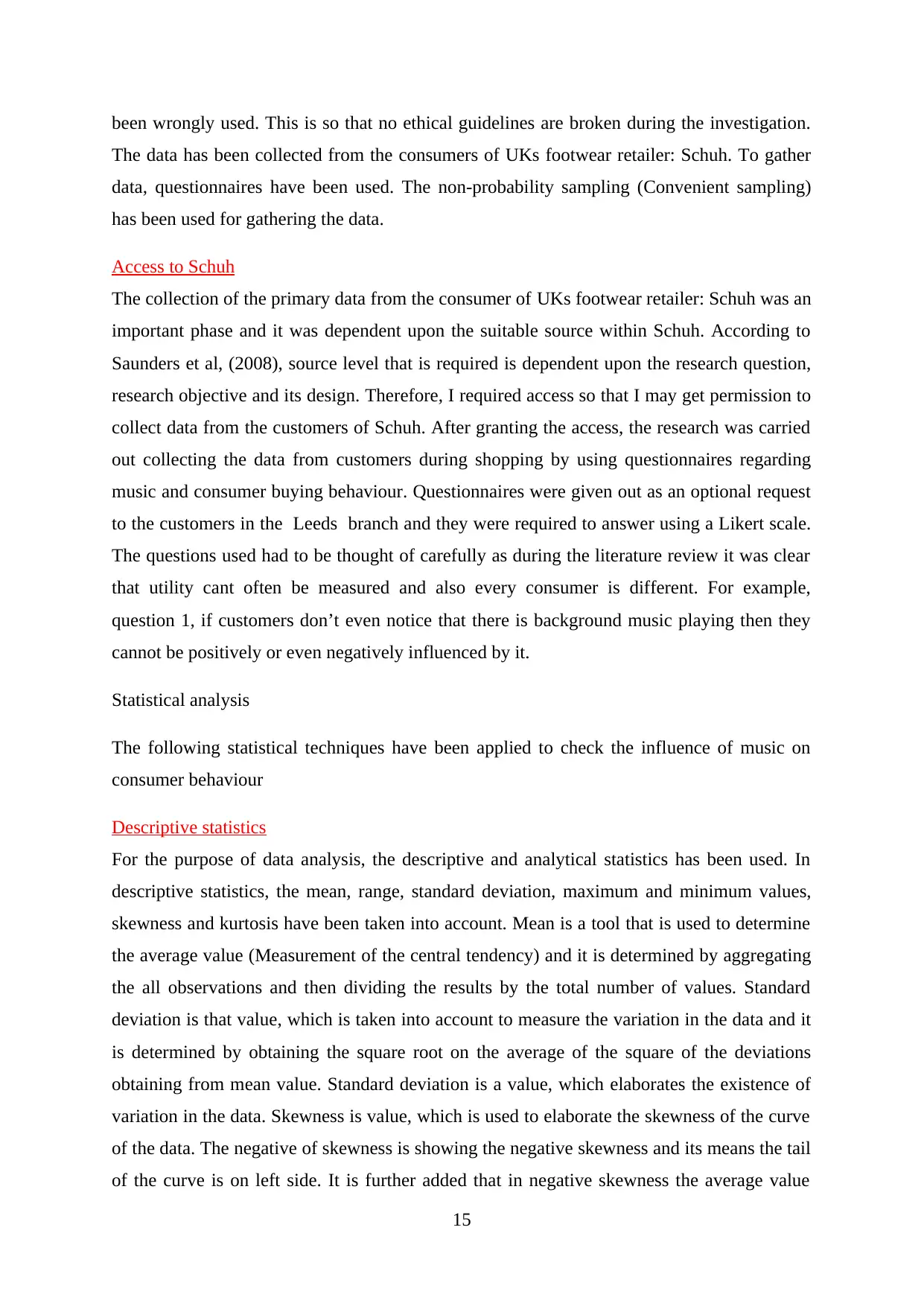
been wrongly used. This is so that no ethical guidelines are broken during the investigation.
The data has been collected from the consumers of UKs footwear retailer: Schuh. To gather
data, questionnaires have been used. The non-probability sampling (Convenient sampling)
has been used for gathering the data.
Access to Schuh
The collection of the primary data from the consumer of UKs footwear retailer: Schuh was an
important phase and it was dependent upon the suitable source within Schuh. According to
Saunders et al, (2008), source level that is required is dependent upon the research question,
research objective and its design. Therefore, I required access so that I may get permission to
collect data from the customers of Schuh. After granting the access, the research was carried
out collecting the data from customers during shopping by using questionnaires regarding
music and consumer buying behaviour. Questionnaires were given out as an optional request
to the customers in the Leeds branch and they were required to answer using a Likert scale.
The questions used had to be thought of carefully as during the literature review it was clear
that utility cant often be measured and also every consumer is different. For example,
question 1, if customers don’t even notice that there is background music playing then they
cannot be positively or even negatively influenced by it.
Statistical analysis
The following statistical techniques have been applied to check the influence of music on
consumer behaviour
Descriptive statistics
For the purpose of data analysis, the descriptive and analytical statistics has been used. In
descriptive statistics, the mean, range, standard deviation, maximum and minimum values,
skewness and kurtosis have been taken into account. Mean is a tool that is used to determine
the average value (Measurement of the central tendency) and it is determined by aggregating
the all observations and then dividing the results by the total number of values. Standard
deviation is that value, which is taken into account to measure the variation in the data and it
is determined by obtaining the square root on the average of the square of the deviations
obtaining from mean value. Standard deviation is a value, which elaborates the existence of
variation in the data. Skewness is value, which is used to elaborate the skewness of the curve
of the data. The negative of skewness is showing the negative skewness and its means the tail
of the curve is on left side. It is further added that in negative skewness the average value
15
The data has been collected from the consumers of UKs footwear retailer: Schuh. To gather
data, questionnaires have been used. The non-probability sampling (Convenient sampling)
has been used for gathering the data.
Access to Schuh
The collection of the primary data from the consumer of UKs footwear retailer: Schuh was an
important phase and it was dependent upon the suitable source within Schuh. According to
Saunders et al, (2008), source level that is required is dependent upon the research question,
research objective and its design. Therefore, I required access so that I may get permission to
collect data from the customers of Schuh. After granting the access, the research was carried
out collecting the data from customers during shopping by using questionnaires regarding
music and consumer buying behaviour. Questionnaires were given out as an optional request
to the customers in the Leeds branch and they were required to answer using a Likert scale.
The questions used had to be thought of carefully as during the literature review it was clear
that utility cant often be measured and also every consumer is different. For example,
question 1, if customers don’t even notice that there is background music playing then they
cannot be positively or even negatively influenced by it.
Statistical analysis
The following statistical techniques have been applied to check the influence of music on
consumer behaviour
Descriptive statistics
For the purpose of data analysis, the descriptive and analytical statistics has been used. In
descriptive statistics, the mean, range, standard deviation, maximum and minimum values,
skewness and kurtosis have been taken into account. Mean is a tool that is used to determine
the average value (Measurement of the central tendency) and it is determined by aggregating
the all observations and then dividing the results by the total number of values. Standard
deviation is that value, which is taken into account to measure the variation in the data and it
is determined by obtaining the square root on the average of the square of the deviations
obtaining from mean value. Standard deviation is a value, which elaborates the existence of
variation in the data. Skewness is value, which is used to elaborate the skewness of the curve
of the data. The negative of skewness is showing the negative skewness and its means the tail
of the curve is on left side. It is further added that in negative skewness the average value
15
Secure Best Marks with AI Grader
Need help grading? Try our AI Grader for instant feedback on your assignments.
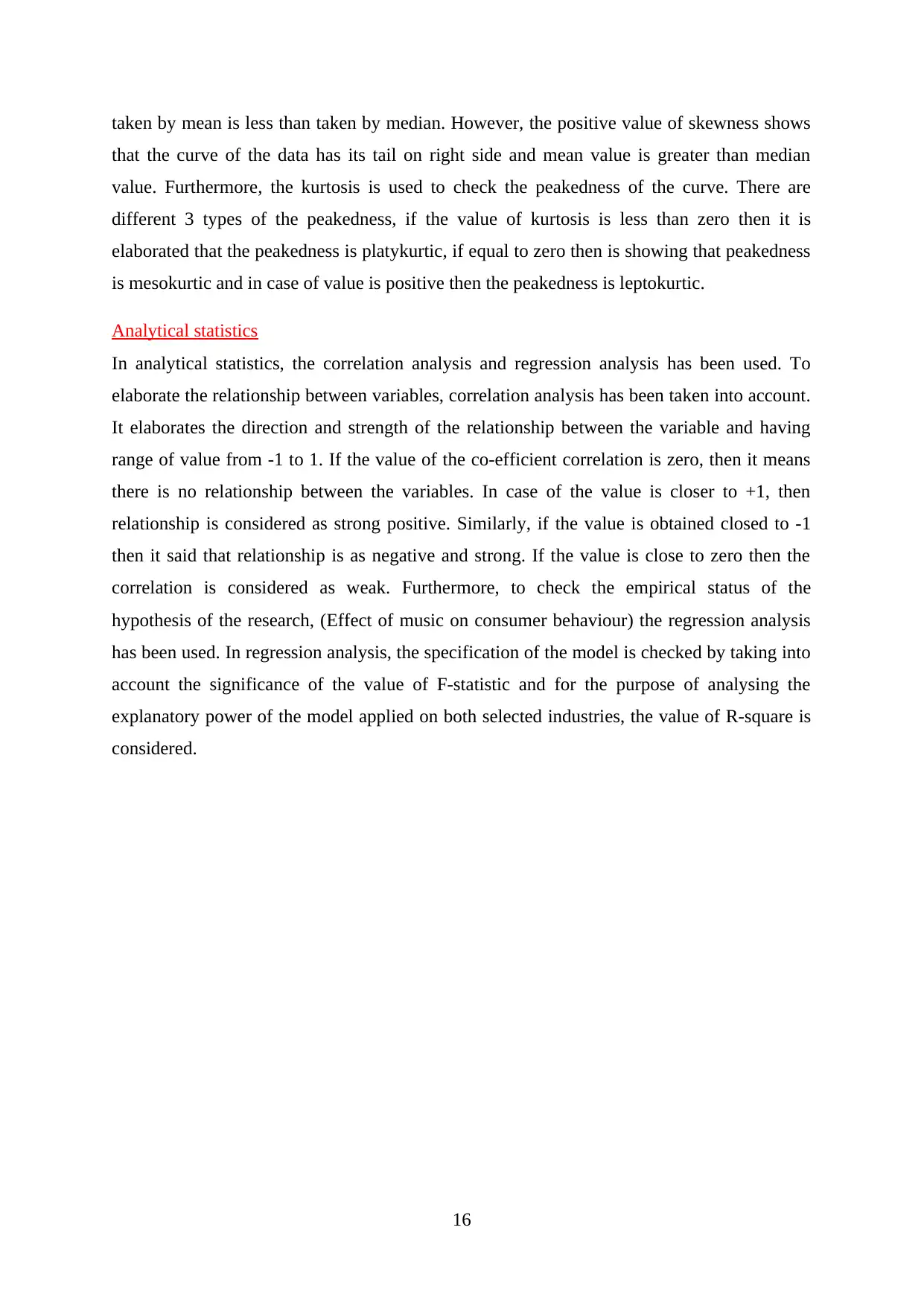
taken by mean is less than taken by median. However, the positive value of skewness shows
that the curve of the data has its tail on right side and mean value is greater than median
value. Furthermore, the kurtosis is used to check the peakedness of the curve. There are
different 3 types of the peakedness, if the value of kurtosis is less than zero then it is
elaborated that the peakedness is platykurtic, if equal to zero then is showing that peakedness
is mesokurtic and in case of value is positive then the peakedness is leptokurtic.
Analytical statistics
In analytical statistics, the correlation analysis and regression analysis has been used. To
elaborate the relationship between variables, correlation analysis has been taken into account.
It elaborates the direction and strength of the relationship between the variable and having
range of value from -1 to 1. If the value of the co-efficient correlation is zero, then it means
there is no relationship between the variables. In case of the value is closer to +1, then
relationship is considered as strong positive. Similarly, if the value is obtained closed to -1
then it said that relationship is as negative and strong. If the value is close to zero then the
correlation is considered as weak. Furthermore, to check the empirical status of the
hypothesis of the research, (Effect of music on consumer behaviour) the regression analysis
has been used. In regression analysis, the specification of the model is checked by taking into
account the significance of the value of F-statistic and for the purpose of analysing the
explanatory power of the model applied on both selected industries, the value of R-square is
considered.
16
that the curve of the data has its tail on right side and mean value is greater than median
value. Furthermore, the kurtosis is used to check the peakedness of the curve. There are
different 3 types of the peakedness, if the value of kurtosis is less than zero then it is
elaborated that the peakedness is platykurtic, if equal to zero then is showing that peakedness
is mesokurtic and in case of value is positive then the peakedness is leptokurtic.
Analytical statistics
In analytical statistics, the correlation analysis and regression analysis has been used. To
elaborate the relationship between variables, correlation analysis has been taken into account.
It elaborates the direction and strength of the relationship between the variable and having
range of value from -1 to 1. If the value of the co-efficient correlation is zero, then it means
there is no relationship between the variables. In case of the value is closer to +1, then
relationship is considered as strong positive. Similarly, if the value is obtained closed to -1
then it said that relationship is as negative and strong. If the value is close to zero then the
correlation is considered as weak. Furthermore, to check the empirical status of the
hypothesis of the research, (Effect of music on consumer behaviour) the regression analysis
has been used. In regression analysis, the specification of the model is checked by taking into
account the significance of the value of F-statistic and for the purpose of analysing the
explanatory power of the model applied on both selected industries, the value of R-square is
considered.
16
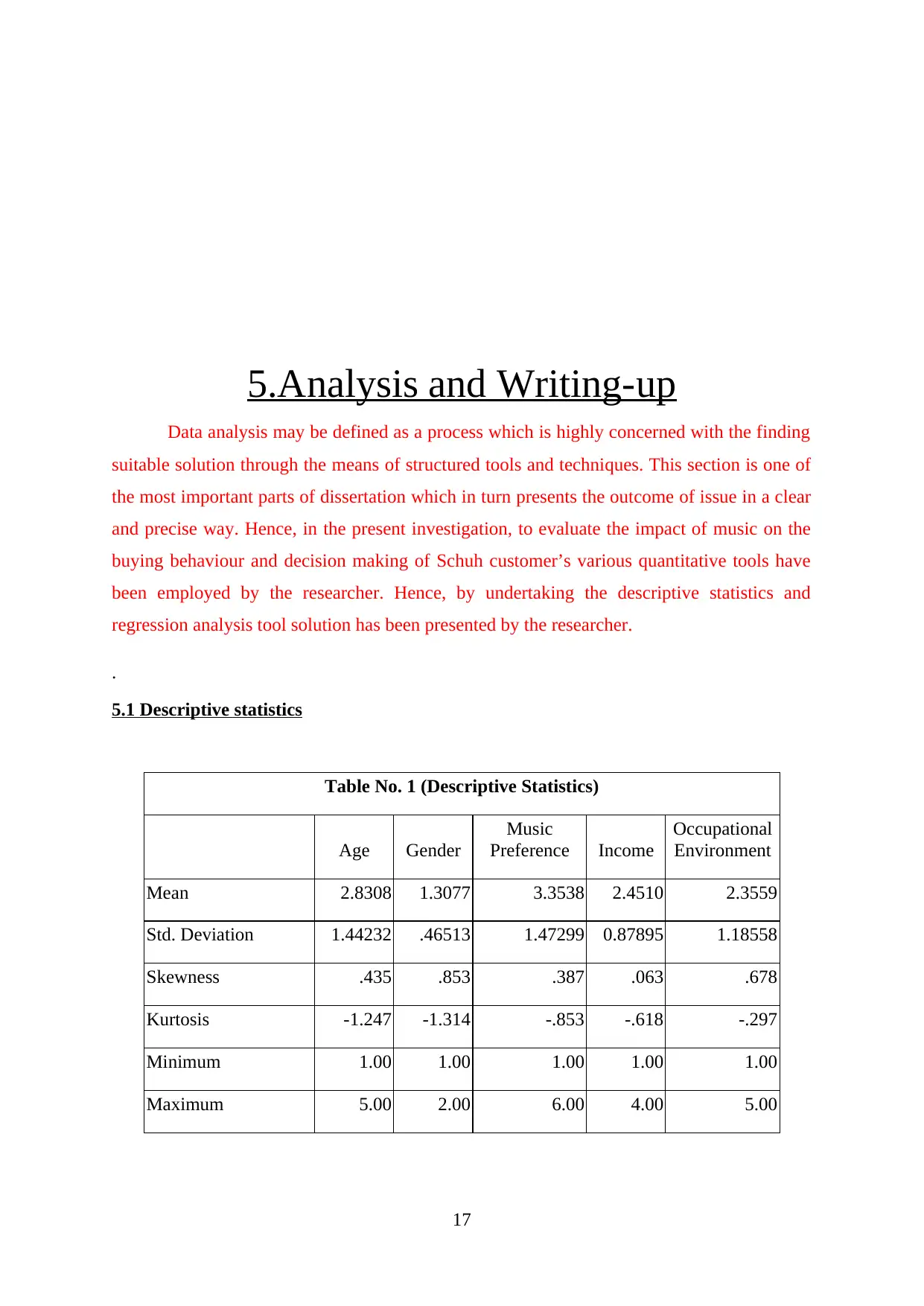
5.Analysis and Writing-up
Data analysis may be defined as a process which is highly concerned with the finding
suitable solution through the means of structured tools and techniques. This section is one of
the most important parts of dissertation which in turn presents the outcome of issue in a clear
and precise way. Hence, in the present investigation, to evaluate the impact of music on the
buying behaviour and decision making of Schuh customer’s various quantitative tools have
been employed by the researcher. Hence, by undertaking the descriptive statistics and
regression analysis tool solution has been presented by the researcher.
.
5.1 Descriptive statistics
Table No. 1 (Descriptive Statistics)
Age Gender
Music
Preference Income
Occupational
Environment
Mean 2.8308 1.3077 3.3538 2.4510 2.3559
Std. Deviation 1.44232 .46513 1.47299 0.87895 1.18558
Skewness .435 .853 .387 .063 .678
Kurtosis -1.247 -1.314 -.853 -.618 -.297
Minimum 1.00 1.00 1.00 1.00 1.00
Maximum 5.00 2.00 6.00 4.00 5.00
17
Data analysis may be defined as a process which is highly concerned with the finding
suitable solution through the means of structured tools and techniques. This section is one of
the most important parts of dissertation which in turn presents the outcome of issue in a clear
and precise way. Hence, in the present investigation, to evaluate the impact of music on the
buying behaviour and decision making of Schuh customer’s various quantitative tools have
been employed by the researcher. Hence, by undertaking the descriptive statistics and
regression analysis tool solution has been presented by the researcher.
.
5.1 Descriptive statistics
Table No. 1 (Descriptive Statistics)
Age Gender
Music
Preference Income
Occupational
Environment
Mean 2.8308 1.3077 3.3538 2.4510 2.3559
Std. Deviation 1.44232 .46513 1.47299 0.87895 1.18558
Skewness .435 .853 .387 .063 .678
Kurtosis -1.247 -1.314 -.853 -.618 -.297
Minimum 1.00 1.00 1.00 1.00 1.00
Maximum 5.00 2.00 6.00 4.00 5.00
17
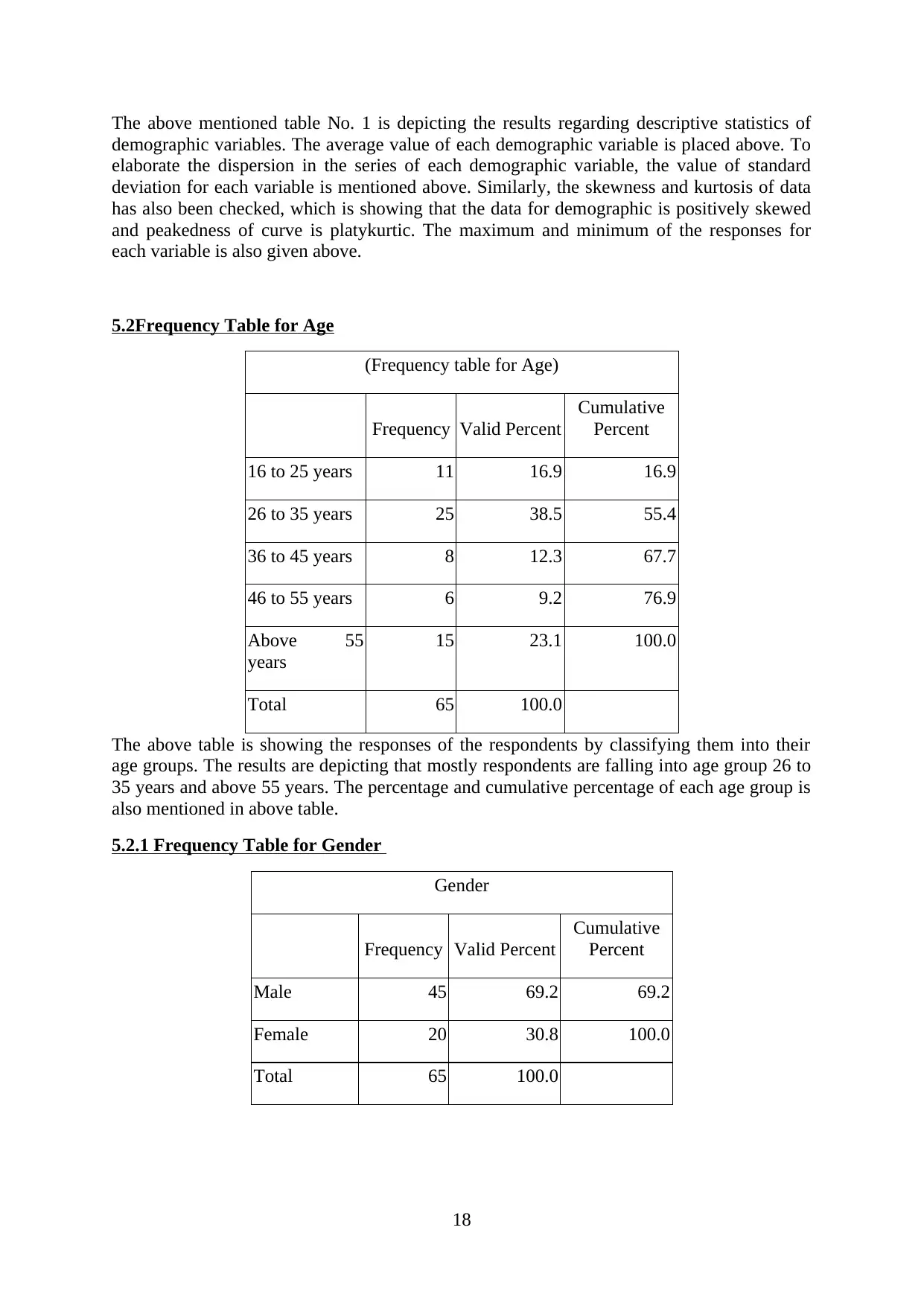
The above mentioned table No. 1 is depicting the results regarding descriptive statistics of
demographic variables. The average value of each demographic variable is placed above. To
elaborate the dispersion in the series of each demographic variable, the value of standard
deviation for each variable is mentioned above. Similarly, the skewness and kurtosis of data
has also been checked, which is showing that the data for demographic is positively skewed
and peakedness of curve is platykurtic. The maximum and minimum of the responses for
each variable is also given above.
5.2Frequency Table for Age
(Frequency table for Age)
Frequency Valid Percent
Cumulative
Percent
16 to 25 years 11 16.9 16.9
26 to 35 years 25 38.5 55.4
36 to 45 years 8 12.3 67.7
46 to 55 years 6 9.2 76.9
Above 55
years
15 23.1 100.0
Total 65 100.0
The above table is showing the responses of the respondents by classifying them into their
age groups. The results are depicting that mostly respondents are falling into age group 26 to
35 years and above 55 years. The percentage and cumulative percentage of each age group is
also mentioned in above table.
5.2.1 Frequency Table for Gender
Gender
Frequency Valid Percent
Cumulative
Percent
Male 45 69.2 69.2
Female 20 30.8 100.0
Total 65 100.0
18
demographic variables. The average value of each demographic variable is placed above. To
elaborate the dispersion in the series of each demographic variable, the value of standard
deviation for each variable is mentioned above. Similarly, the skewness and kurtosis of data
has also been checked, which is showing that the data for demographic is positively skewed
and peakedness of curve is platykurtic. The maximum and minimum of the responses for
each variable is also given above.
5.2Frequency Table for Age
(Frequency table for Age)
Frequency Valid Percent
Cumulative
Percent
16 to 25 years 11 16.9 16.9
26 to 35 years 25 38.5 55.4
36 to 45 years 8 12.3 67.7
46 to 55 years 6 9.2 76.9
Above 55
years
15 23.1 100.0
Total 65 100.0
The above table is showing the responses of the respondents by classifying them into their
age groups. The results are depicting that mostly respondents are falling into age group 26 to
35 years and above 55 years. The percentage and cumulative percentage of each age group is
also mentioned in above table.
5.2.1 Frequency Table for Gender
Gender
Frequency Valid Percent
Cumulative
Percent
Male 45 69.2 69.2
Female 20 30.8 100.0
Total 65 100.0
18
Paraphrase This Document
Need a fresh take? Get an instant paraphrase of this document with our AI Paraphraser
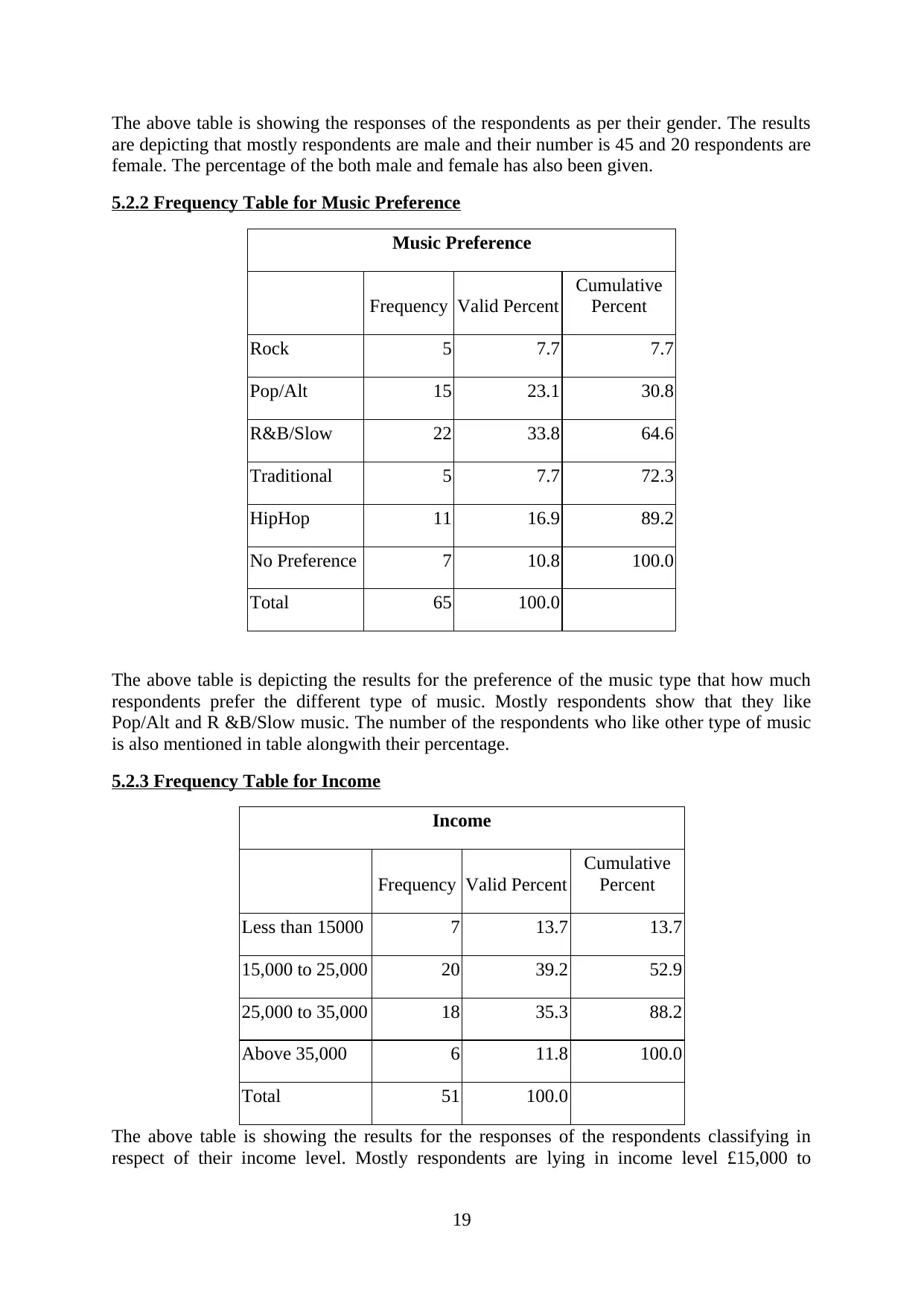
The above table is showing the responses of the respondents as per their gender. The results
are depicting that mostly respondents are male and their number is 45 and 20 respondents are
female. The percentage of the both male and female has also been given.
5.2.2 Frequency Table for Music Preference
Music Preference
Frequency Valid Percent
Cumulative
Percent
Rock 5 7.7 7.7
Pop/Alt 15 23.1 30.8
R&B/Slow 22 33.8 64.6
Traditional 5 7.7 72.3
HipHop 11 16.9 89.2
No Preference 7 10.8 100.0
Total 65 100.0
The above table is depicting the results for the preference of the music type that how much
respondents prefer the different type of music. Mostly respondents show that they like
Pop/Alt and R &B/Slow music. The number of the respondents who like other type of music
is also mentioned in table alongwith their percentage.
5.2.3 Frequency Table for Income
Income
Frequency Valid Percent
Cumulative
Percent
Less than 15000 7 13.7 13.7
15,000 to 25,000 20 39.2 52.9
25,000 to 35,000 18 35.3 88.2
Above 35,000 6 11.8 100.0
Total 51 100.0
The above table is showing the results for the responses of the respondents classifying in
respect of their income level. Mostly respondents are lying in income level £15,000 to
19
are depicting that mostly respondents are male and their number is 45 and 20 respondents are
female. The percentage of the both male and female has also been given.
5.2.2 Frequency Table for Music Preference
Music Preference
Frequency Valid Percent
Cumulative
Percent
Rock 5 7.7 7.7
Pop/Alt 15 23.1 30.8
R&B/Slow 22 33.8 64.6
Traditional 5 7.7 72.3
HipHop 11 16.9 89.2
No Preference 7 10.8 100.0
Total 65 100.0
The above table is depicting the results for the preference of the music type that how much
respondents prefer the different type of music. Mostly respondents show that they like
Pop/Alt and R &B/Slow music. The number of the respondents who like other type of music
is also mentioned in table alongwith their percentage.
5.2.3 Frequency Table for Income
Income
Frequency Valid Percent
Cumulative
Percent
Less than 15000 7 13.7 13.7
15,000 to 25,000 20 39.2 52.9
25,000 to 35,000 18 35.3 88.2
Above 35,000 6 11.8 100.0
Total 51 100.0
The above table is showing the results for the responses of the respondents classifying in
respect of their income level. Mostly respondents are lying in income level £15,000 to
19
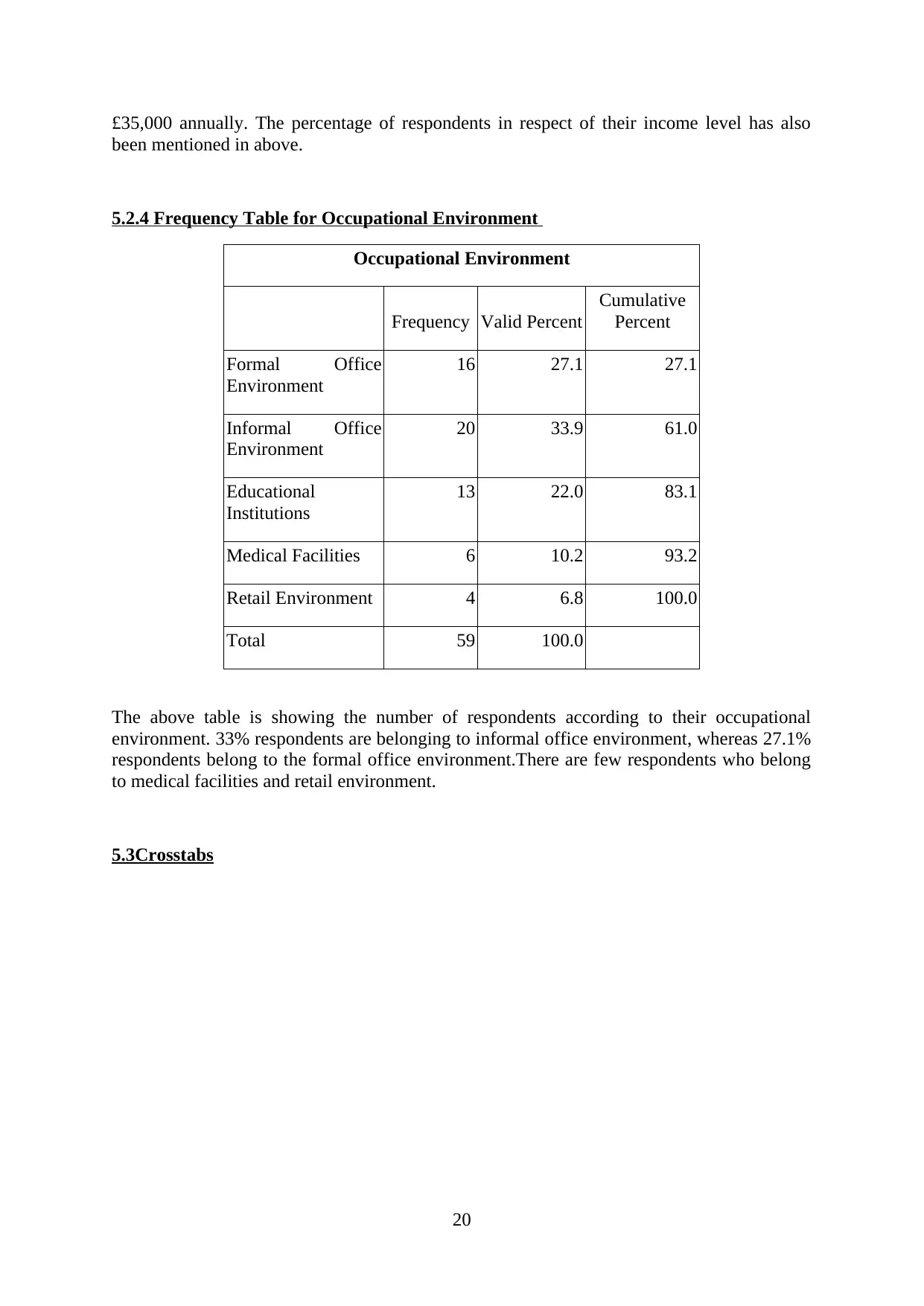
£35,000 annually. The percentage of respondents in respect of their income level has also
been mentioned in above.
5.2.4 Frequency Table for Occupational Environment
Occupational Environment
Frequency Valid Percent
Cumulative
Percent
Formal Office
Environment
16 27.1 27.1
Informal Office
Environment
20 33.9 61.0
Educational
Institutions
13 22.0 83.1
Medical Facilities 6 10.2 93.2
Retail Environment 4 6.8 100.0
Total 59 100.0
The above table is showing the number of respondents according to their occupational
environment. 33% respondents are belonging to informal office environment, whereas 27.1%
respondents belong to the formal office environment.There are few respondents who belong
to medical facilities and retail environment.
5.3Crosstabs
20
been mentioned in above.
5.2.4 Frequency Table for Occupational Environment
Occupational Environment
Frequency Valid Percent
Cumulative
Percent
Formal Office
Environment
16 27.1 27.1
Informal Office
Environment
20 33.9 61.0
Educational
Institutions
13 22.0 83.1
Medical Facilities 6 10.2 93.2
Retail Environment 4 6.8 100.0
Total 59 100.0
The above table is showing the number of respondents according to their occupational
environment. 33% respondents are belonging to informal office environment, whereas 27.1%
respondents belong to the formal office environment.There are few respondents who belong
to medical facilities and retail environment.
5.3Crosstabs
20

4.3.1 Age * Music Preference Crosstabulation
Music Preference
Rock Pop/Alt R&B/Slow Traditional HipHop
Age 16 to 25 years 0 2 4 0 4
26 to 35 years 3 6 9 0 6
36 to 45 years 2 1 5 0 0
46 to 55 years 0 4 0 1 1
Above 55
years
0 2 4 4 0
Total 5 15 22 5 11
The above two way table is showing the results of the classification of the respondents
according to their age group and preference of music. 22 respondents out of 65 of all ages are
showing their preference of slow music.
4.3.2 Gender * Music Preference Crosstabulation
Music Preference
Rock Pop/Alt R&B/Slow Traditional HipHop
Gender Male 4 9 13 3 10
Female 1 6 9 2 1
Total 5 15 22 5 11
The above two way table is showing the results of the classification of the respondents
according to gender and preference of music. 22 respondents out of 65 including male and
female are showing their preference of slow music.
5.4 Analytical analysis
5.4.1 Partial Correlation
21
Music Preference
Rock Pop/Alt R&B/Slow Traditional HipHop
Age 16 to 25 years 0 2 4 0 4
26 to 35 years 3 6 9 0 6
36 to 45 years 2 1 5 0 0
46 to 55 years 0 4 0 1 1
Above 55
years
0 2 4 4 0
Total 5 15 22 5 11
The above two way table is showing the results of the classification of the respondents
according to their age group and preference of music. 22 respondents out of 65 of all ages are
showing their preference of slow music.
4.3.2 Gender * Music Preference Crosstabulation
Music Preference
Rock Pop/Alt R&B/Slow Traditional HipHop
Gender Male 4 9 13 3 10
Female 1 6 9 2 1
Total 5 15 22 5 11
The above two way table is showing the results of the classification of the respondents
according to gender and preference of music. 22 respondents out of 65 including male and
female are showing their preference of slow music.
5.4 Analytical analysis
5.4.1 Partial Correlation
21
Secure Best Marks with AI Grader
Need help grading? Try our AI Grader for instant feedback on your assignments.
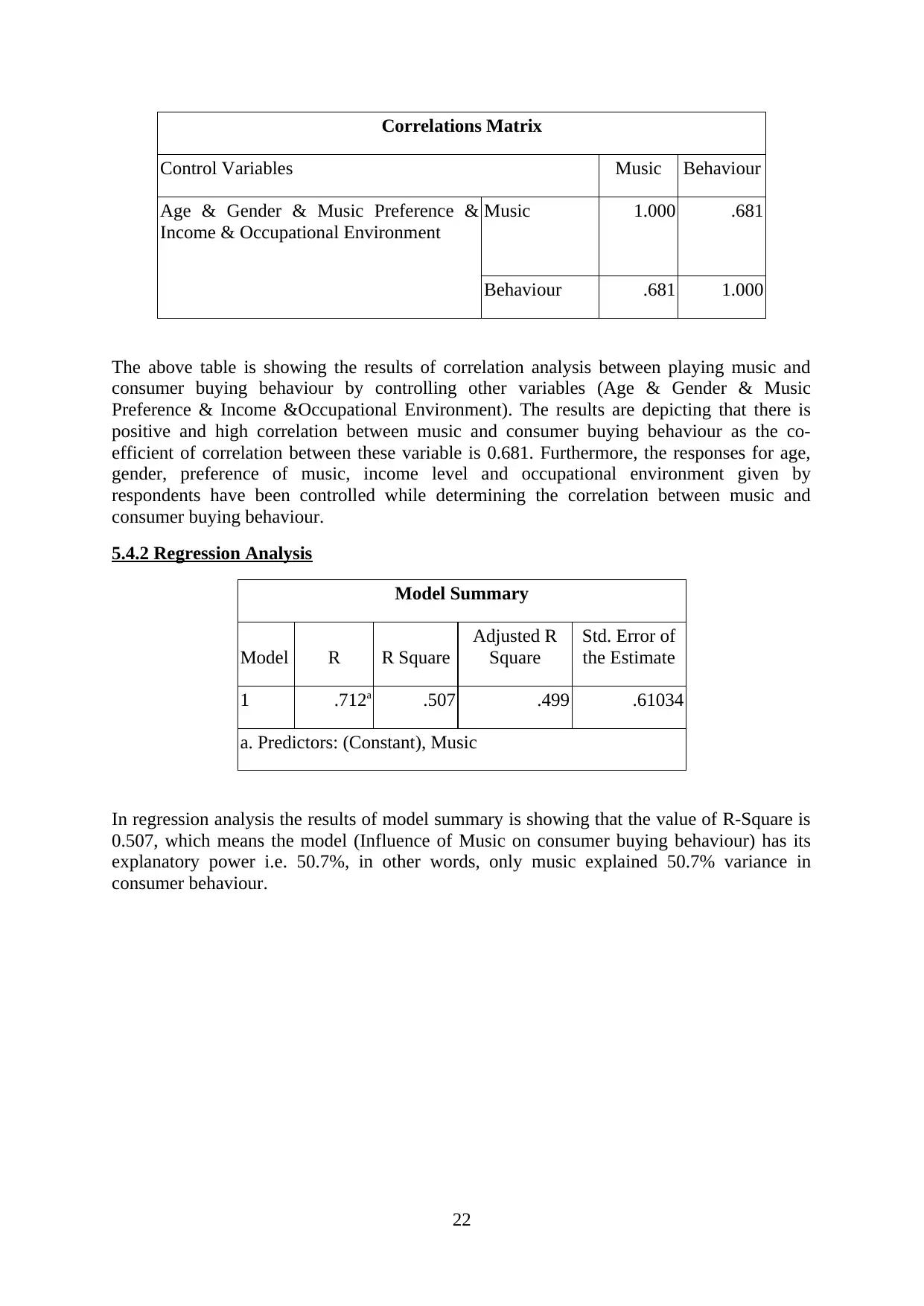
Correlations Matrix
Control Variables Music Behaviour
Age & Gender & Music Preference &
Income & Occupational Environment
Music 1.000 .681
Behaviour .681 1.000
The above table is showing the results of correlation analysis between playing music and
consumer buying behaviour by controlling other variables (Age & Gender & Music
Preference & Income &Occupational Environment). The results are depicting that there is
positive and high correlation between music and consumer buying behaviour as the co-
efficient of correlation between these variable is 0.681. Furthermore, the responses for age,
gender, preference of music, income level and occupational environment given by
respondents have been controlled while determining the correlation between music and
consumer buying behaviour.
5.4.2 Regression Analysis
Model Summary
Model R R Square
Adjusted R
Square
Std. Error of
the Estimate
1 .712a .507 .499 .61034
a. Predictors: (Constant), Music
In regression analysis the results of model summary is showing that the value of R-Square is
0.507, which means the model (Influence of Music on consumer buying behaviour) has its
explanatory power i.e. 50.7%, in other words, only music explained 50.7% variance in
consumer behaviour.
22
Control Variables Music Behaviour
Age & Gender & Music Preference &
Income & Occupational Environment
Music 1.000 .681
Behaviour .681 1.000
The above table is showing the results of correlation analysis between playing music and
consumer buying behaviour by controlling other variables (Age & Gender & Music
Preference & Income &Occupational Environment). The results are depicting that there is
positive and high correlation between music and consumer buying behaviour as the co-
efficient of correlation between these variable is 0.681. Furthermore, the responses for age,
gender, preference of music, income level and occupational environment given by
respondents have been controlled while determining the correlation between music and
consumer buying behaviour.
5.4.2 Regression Analysis
Model Summary
Model R R Square
Adjusted R
Square
Std. Error of
the Estimate
1 .712a .507 .499 .61034
a. Predictors: (Constant), Music
In regression analysis the results of model summary is showing that the value of R-Square is
0.507, which means the model (Influence of Music on consumer buying behaviour) has its
explanatory power i.e. 50.7%, in other words, only music explained 50.7% variance in
consumer behaviour.
22
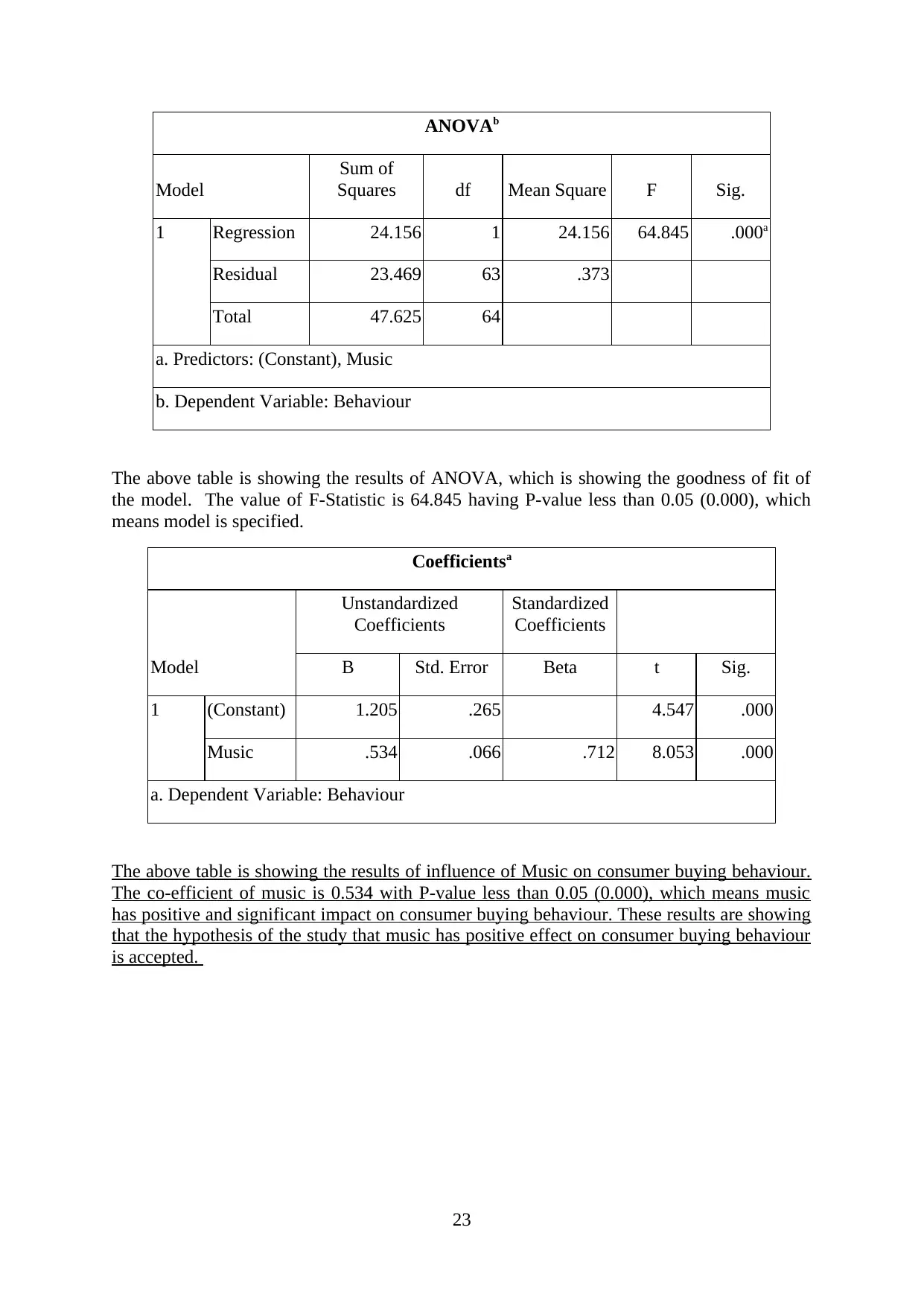
ANOVAb
Model
Sum of
Squares df Mean Square F Sig.
1 Regression 24.156 1 24.156 64.845 .000a
Residual 23.469 63 .373
Total 47.625 64
a. Predictors: (Constant), Music
b. Dependent Variable: Behaviour
The above table is showing the results of ANOVA, which is showing the goodness of fit of
the model. The value of F-Statistic is 64.845 having P-value less than 0.05 (0.000), which
means model is specified.
Coefficientsa
Model
Unstandardized
Coefficients
Standardized
Coefficients
B Std. Error Beta t Sig.
1 (Constant) 1.205 .265 4.547 .000
Music .534 .066 .712 8.053 .000
a. Dependent Variable: Behaviour
The above table is showing the results of influence of Music on consumer buying behaviour.
The co-efficient of music is 0.534 with P-value less than 0.05 (0.000), which means music
has positive and significant impact on consumer buying behaviour. These results are showing
that the hypothesis of the study that music has positive effect on consumer buying behaviour
is accepted.
23
Model
Sum of
Squares df Mean Square F Sig.
1 Regression 24.156 1 24.156 64.845 .000a
Residual 23.469 63 .373
Total 47.625 64
a. Predictors: (Constant), Music
b. Dependent Variable: Behaviour
The above table is showing the results of ANOVA, which is showing the goodness of fit of
the model. The value of F-Statistic is 64.845 having P-value less than 0.05 (0.000), which
means model is specified.
Coefficientsa
Model
Unstandardized
Coefficients
Standardized
Coefficients
B Std. Error Beta t Sig.
1 (Constant) 1.205 .265 4.547 .000
Music .534 .066 .712 8.053 .000
a. Dependent Variable: Behaviour
The above table is showing the results of influence of Music on consumer buying behaviour.
The co-efficient of music is 0.534 with P-value less than 0.05 (0.000), which means music
has positive and significant impact on consumer buying behaviour. These results are showing
that the hypothesis of the study that music has positive effect on consumer buying behaviour
is accepted.
23
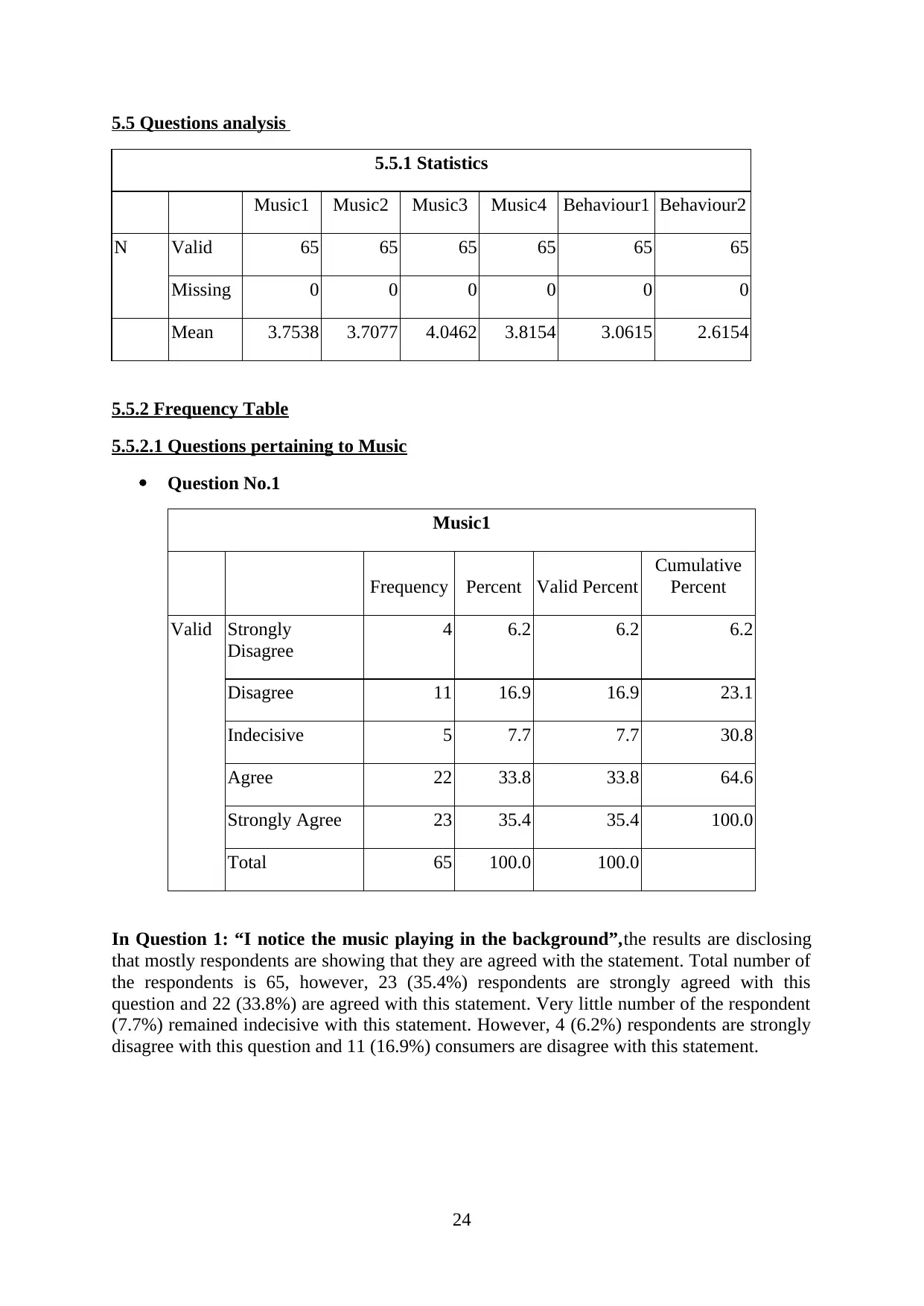
5.5 Questions analysis
5.5.1 Statistics
Music1 Music2 Music3 Music4 Behaviour1 Behaviour2
N Valid 65 65 65 65 65 65
Missing 0 0 0 0 0 0
Mean 3.7538 3.7077 4.0462 3.8154 3.0615 2.6154
5.5.2 Frequency Table
5.5.2.1 Questions pertaining to Music
Question No.1
Music1
Frequency Percent Valid Percent
Cumulative
Percent
Valid Strongly
Disagree
4 6.2 6.2 6.2
Disagree 11 16.9 16.9 23.1
Indecisive 5 7.7 7.7 30.8
Agree 22 33.8 33.8 64.6
Strongly Agree 23 35.4 35.4 100.0
Total 65 100.0 100.0
In Question 1: “I notice the music playing in the background”,the results are disclosing
that mostly respondents are showing that they are agreed with the statement. Total number of
the respondents is 65, however, 23 (35.4%) respondents are strongly agreed with this
question and 22 (33.8%) are agreed with this statement. Very little number of the respondent
(7.7%) remained indecisive with this statement. However, 4 (6.2%) respondents are strongly
disagree with this question and 11 (16.9%) consumers are disagree with this statement.
24
5.5.1 Statistics
Music1 Music2 Music3 Music4 Behaviour1 Behaviour2
N Valid 65 65 65 65 65 65
Missing 0 0 0 0 0 0
Mean 3.7538 3.7077 4.0462 3.8154 3.0615 2.6154
5.5.2 Frequency Table
5.5.2.1 Questions pertaining to Music
Question No.1
Music1
Frequency Percent Valid Percent
Cumulative
Percent
Valid Strongly
Disagree
4 6.2 6.2 6.2
Disagree 11 16.9 16.9 23.1
Indecisive 5 7.7 7.7 30.8
Agree 22 33.8 33.8 64.6
Strongly Agree 23 35.4 35.4 100.0
Total 65 100.0 100.0
In Question 1: “I notice the music playing in the background”,the results are disclosing
that mostly respondents are showing that they are agreed with the statement. Total number of
the respondents is 65, however, 23 (35.4%) respondents are strongly agreed with this
question and 22 (33.8%) are agreed with this statement. Very little number of the respondent
(7.7%) remained indecisive with this statement. However, 4 (6.2%) respondents are strongly
disagree with this question and 11 (16.9%) consumers are disagree with this statement.
24
Paraphrase This Document
Need a fresh take? Get an instant paraphrase of this document with our AI Paraphraser
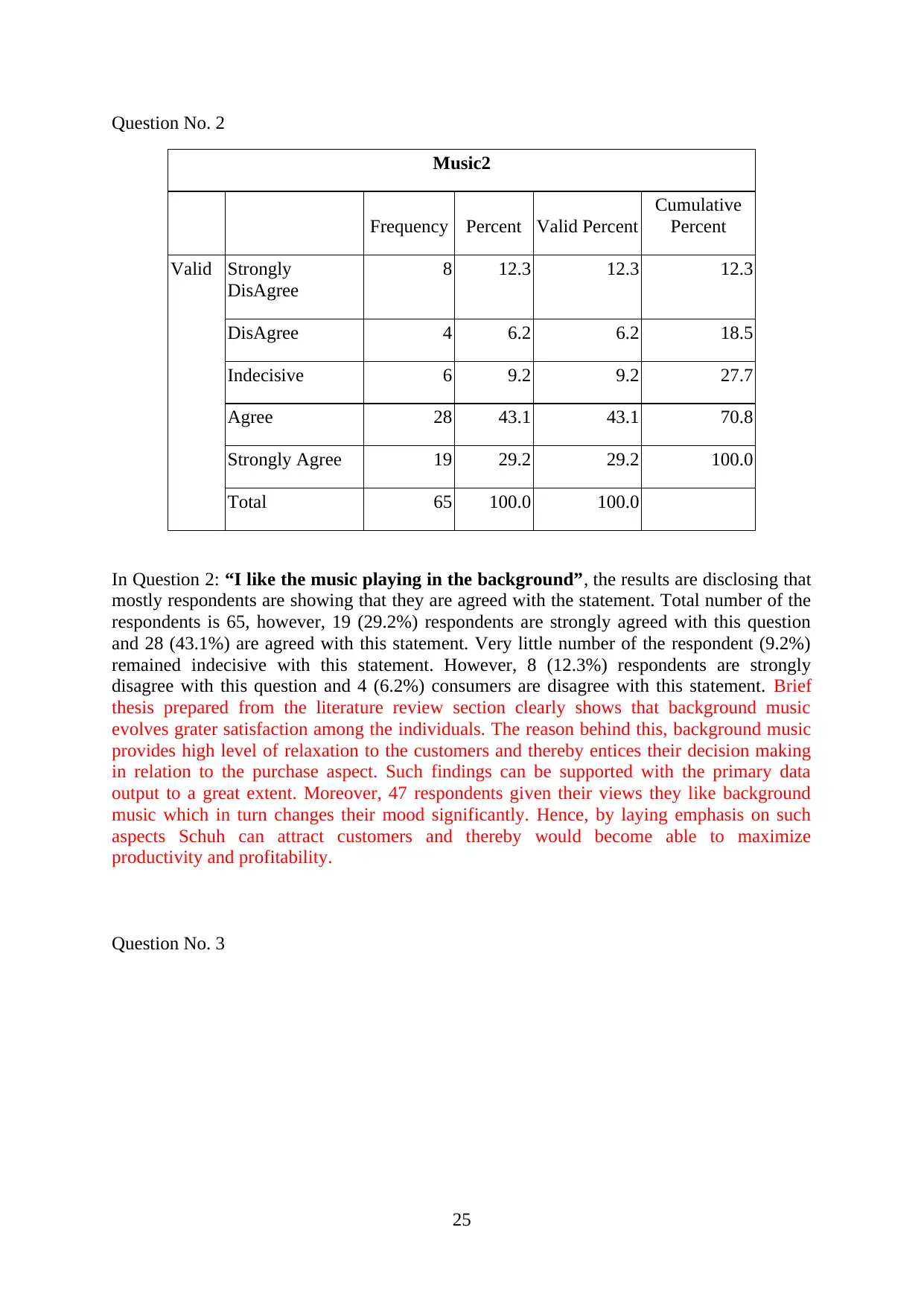
Question No. 2
Music2
Frequency Percent Valid Percent
Cumulative
Percent
Valid Strongly
DisAgree
8 12.3 12.3 12.3
DisAgree 4 6.2 6.2 18.5
Indecisive 6 9.2 9.2 27.7
Agree 28 43.1 43.1 70.8
Strongly Agree 19 29.2 29.2 100.0
Total 65 100.0 100.0
In Question 2: “I like the music playing in the background”, the results are disclosing that
mostly respondents are showing that they are agreed with the statement. Total number of the
respondents is 65, however, 19 (29.2%) respondents are strongly agreed with this question
and 28 (43.1%) are agreed with this statement. Very little number of the respondent (9.2%)
remained indecisive with this statement. However, 8 (12.3%) respondents are strongly
disagree with this question and 4 (6.2%) consumers are disagree with this statement. Brief
thesis prepared from the literature review section clearly shows that background music
evolves grater satisfaction among the individuals. The reason behind this, background music
provides high level of relaxation to the customers and thereby entices their decision making
in relation to the purchase aspect. Such findings can be supported with the primary data
output to a great extent. Moreover, 47 respondents given their views they like background
music which in turn changes their mood significantly. Hence, by laying emphasis on such
aspects Schuh can attract customers and thereby would become able to maximize
productivity and profitability.
Question No. 3
25
Music2
Frequency Percent Valid Percent
Cumulative
Percent
Valid Strongly
DisAgree
8 12.3 12.3 12.3
DisAgree 4 6.2 6.2 18.5
Indecisive 6 9.2 9.2 27.7
Agree 28 43.1 43.1 70.8
Strongly Agree 19 29.2 29.2 100.0
Total 65 100.0 100.0
In Question 2: “I like the music playing in the background”, the results are disclosing that
mostly respondents are showing that they are agreed with the statement. Total number of the
respondents is 65, however, 19 (29.2%) respondents are strongly agreed with this question
and 28 (43.1%) are agreed with this statement. Very little number of the respondent (9.2%)
remained indecisive with this statement. However, 8 (12.3%) respondents are strongly
disagree with this question and 4 (6.2%) consumers are disagree with this statement. Brief
thesis prepared from the literature review section clearly shows that background music
evolves grater satisfaction among the individuals. The reason behind this, background music
provides high level of relaxation to the customers and thereby entices their decision making
in relation to the purchase aspect. Such findings can be supported with the primary data
output to a great extent. Moreover, 47 respondents given their views they like background
music which in turn changes their mood significantly. Hence, by laying emphasis on such
aspects Schuh can attract customers and thereby would become able to maximize
productivity and profitability.
Question No. 3
25
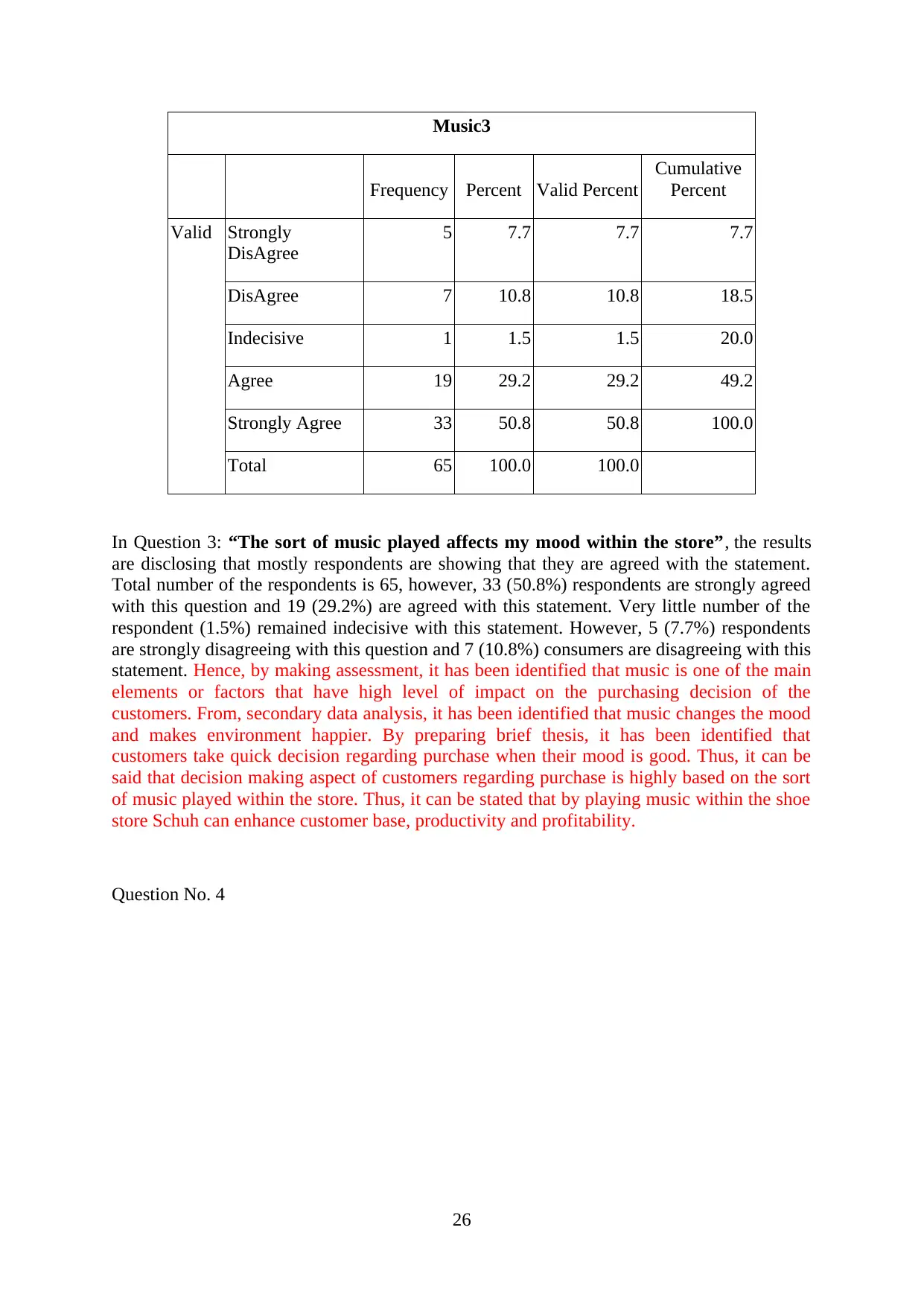
Music3
Frequency Percent Valid Percent
Cumulative
Percent
Valid Strongly
DisAgree
5 7.7 7.7 7.7
DisAgree 7 10.8 10.8 18.5
Indecisive 1 1.5 1.5 20.0
Agree 19 29.2 29.2 49.2
Strongly Agree 33 50.8 50.8 100.0
Total 65 100.0 100.0
In Question 3: “The sort of music played affects my mood within the store”, the results
are disclosing that mostly respondents are showing that they are agreed with the statement.
Total number of the respondents is 65, however, 33 (50.8%) respondents are strongly agreed
with this question and 19 (29.2%) are agreed with this statement. Very little number of the
respondent (1.5%) remained indecisive with this statement. However, 5 (7.7%) respondents
are strongly disagreeing with this question and 7 (10.8%) consumers are disagreeing with this
statement. Hence, by making assessment, it has been identified that music is one of the main
elements or factors that have high level of impact on the purchasing decision of the
customers. From, secondary data analysis, it has been identified that music changes the mood
and makes environment happier. By preparing brief thesis, it has been identified that
customers take quick decision regarding purchase when their mood is good. Thus, it can be
said that decision making aspect of customers regarding purchase is highly based on the sort
of music played within the store. Thus, it can be stated that by playing music within the shoe
store Schuh can enhance customer base, productivity and profitability.
Question No. 4
26
Frequency Percent Valid Percent
Cumulative
Percent
Valid Strongly
DisAgree
5 7.7 7.7 7.7
DisAgree 7 10.8 10.8 18.5
Indecisive 1 1.5 1.5 20.0
Agree 19 29.2 29.2 49.2
Strongly Agree 33 50.8 50.8 100.0
Total 65 100.0 100.0
In Question 3: “The sort of music played affects my mood within the store”, the results
are disclosing that mostly respondents are showing that they are agreed with the statement.
Total number of the respondents is 65, however, 33 (50.8%) respondents are strongly agreed
with this question and 19 (29.2%) are agreed with this statement. Very little number of the
respondent (1.5%) remained indecisive with this statement. However, 5 (7.7%) respondents
are strongly disagreeing with this question and 7 (10.8%) consumers are disagreeing with this
statement. Hence, by making assessment, it has been identified that music is one of the main
elements or factors that have high level of impact on the purchasing decision of the
customers. From, secondary data analysis, it has been identified that music changes the mood
and makes environment happier. By preparing brief thesis, it has been identified that
customers take quick decision regarding purchase when their mood is good. Thus, it can be
said that decision making aspect of customers regarding purchase is highly based on the sort
of music played within the store. Thus, it can be stated that by playing music within the shoe
store Schuh can enhance customer base, productivity and profitability.
Question No. 4
26
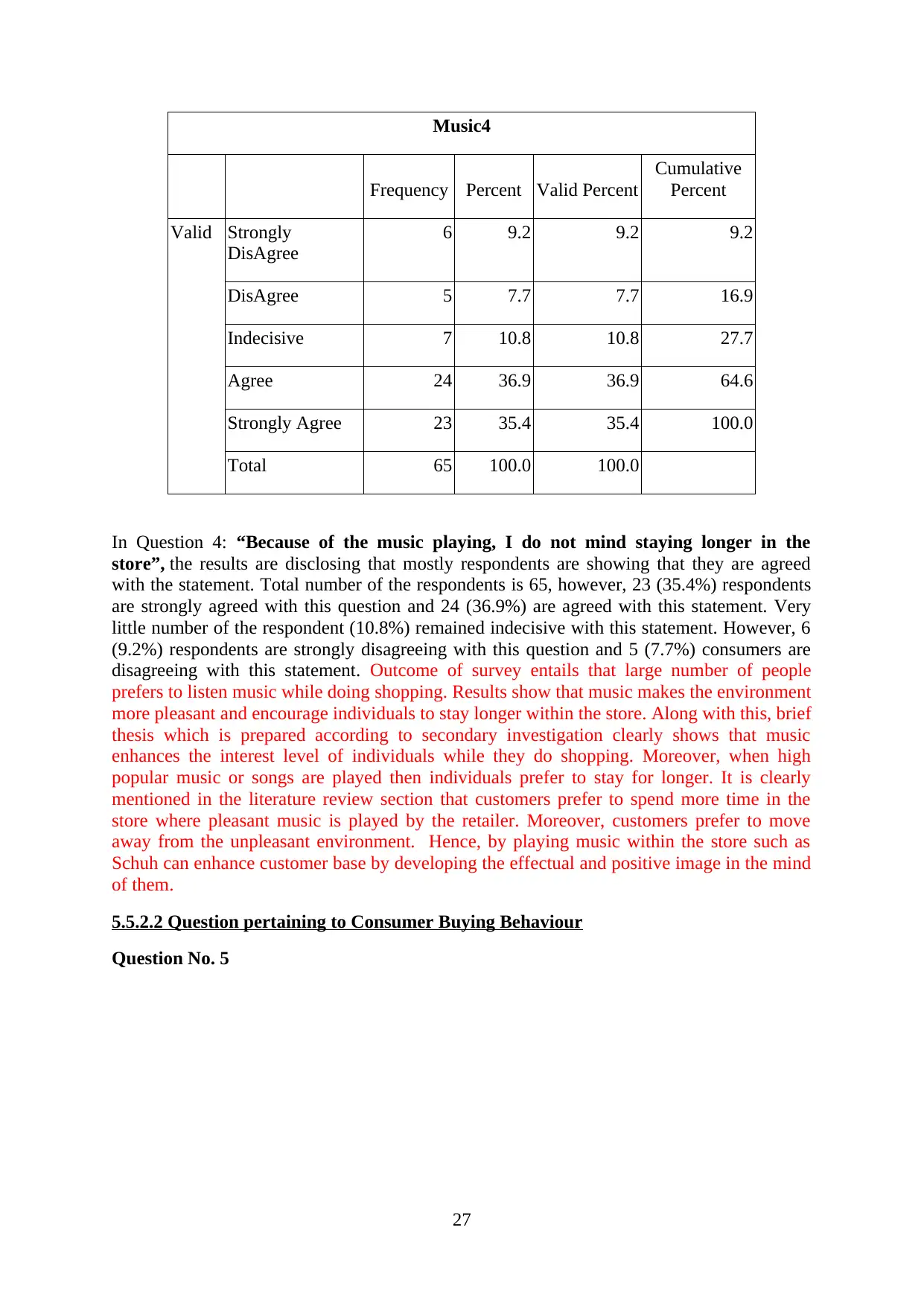
Music4
Frequency Percent Valid Percent
Cumulative
Percent
Valid Strongly
DisAgree
6 9.2 9.2 9.2
DisAgree 5 7.7 7.7 16.9
Indecisive 7 10.8 10.8 27.7
Agree 24 36.9 36.9 64.6
Strongly Agree 23 35.4 35.4 100.0
Total 65 100.0 100.0
In Question 4: “Because of the music playing, I do not mind staying longer in the
store”, the results are disclosing that mostly respondents are showing that they are agreed
with the statement. Total number of the respondents is 65, however, 23 (35.4%) respondents
are strongly agreed with this question and 24 (36.9%) are agreed with this statement. Very
little number of the respondent (10.8%) remained indecisive with this statement. However, 6
(9.2%) respondents are strongly disagreeing with this question and 5 (7.7%) consumers are
disagreeing with this statement. Outcome of survey entails that large number of people
prefers to listen music while doing shopping. Results show that music makes the environment
more pleasant and encourage individuals to stay longer within the store. Along with this, brief
thesis which is prepared according to secondary investigation clearly shows that music
enhances the interest level of individuals while they do shopping. Moreover, when high
popular music or songs are played then individuals prefer to stay for longer. It is clearly
mentioned in the literature review section that customers prefer to spend more time in the
store where pleasant music is played by the retailer. Moreover, customers prefer to move
away from the unpleasant environment. Hence, by playing music within the store such as
Schuh can enhance customer base by developing the effectual and positive image in the mind
of them.
5.5.2.2 Question pertaining to Consumer Buying Behaviour
Question No. 5
27
Frequency Percent Valid Percent
Cumulative
Percent
Valid Strongly
DisAgree
6 9.2 9.2 9.2
DisAgree 5 7.7 7.7 16.9
Indecisive 7 10.8 10.8 27.7
Agree 24 36.9 36.9 64.6
Strongly Agree 23 35.4 35.4 100.0
Total 65 100.0 100.0
In Question 4: “Because of the music playing, I do not mind staying longer in the
store”, the results are disclosing that mostly respondents are showing that they are agreed
with the statement. Total number of the respondents is 65, however, 23 (35.4%) respondents
are strongly agreed with this question and 24 (36.9%) are agreed with this statement. Very
little number of the respondent (10.8%) remained indecisive with this statement. However, 6
(9.2%) respondents are strongly disagreeing with this question and 5 (7.7%) consumers are
disagreeing with this statement. Outcome of survey entails that large number of people
prefers to listen music while doing shopping. Results show that music makes the environment
more pleasant and encourage individuals to stay longer within the store. Along with this, brief
thesis which is prepared according to secondary investigation clearly shows that music
enhances the interest level of individuals while they do shopping. Moreover, when high
popular music or songs are played then individuals prefer to stay for longer. It is clearly
mentioned in the literature review section that customers prefer to spend more time in the
store where pleasant music is played by the retailer. Moreover, customers prefer to move
away from the unpleasant environment. Hence, by playing music within the store such as
Schuh can enhance customer base by developing the effectual and positive image in the mind
of them.
5.5.2.2 Question pertaining to Consumer Buying Behaviour
Question No. 5
27
Secure Best Marks with AI Grader
Need help grading? Try our AI Grader for instant feedback on your assignments.
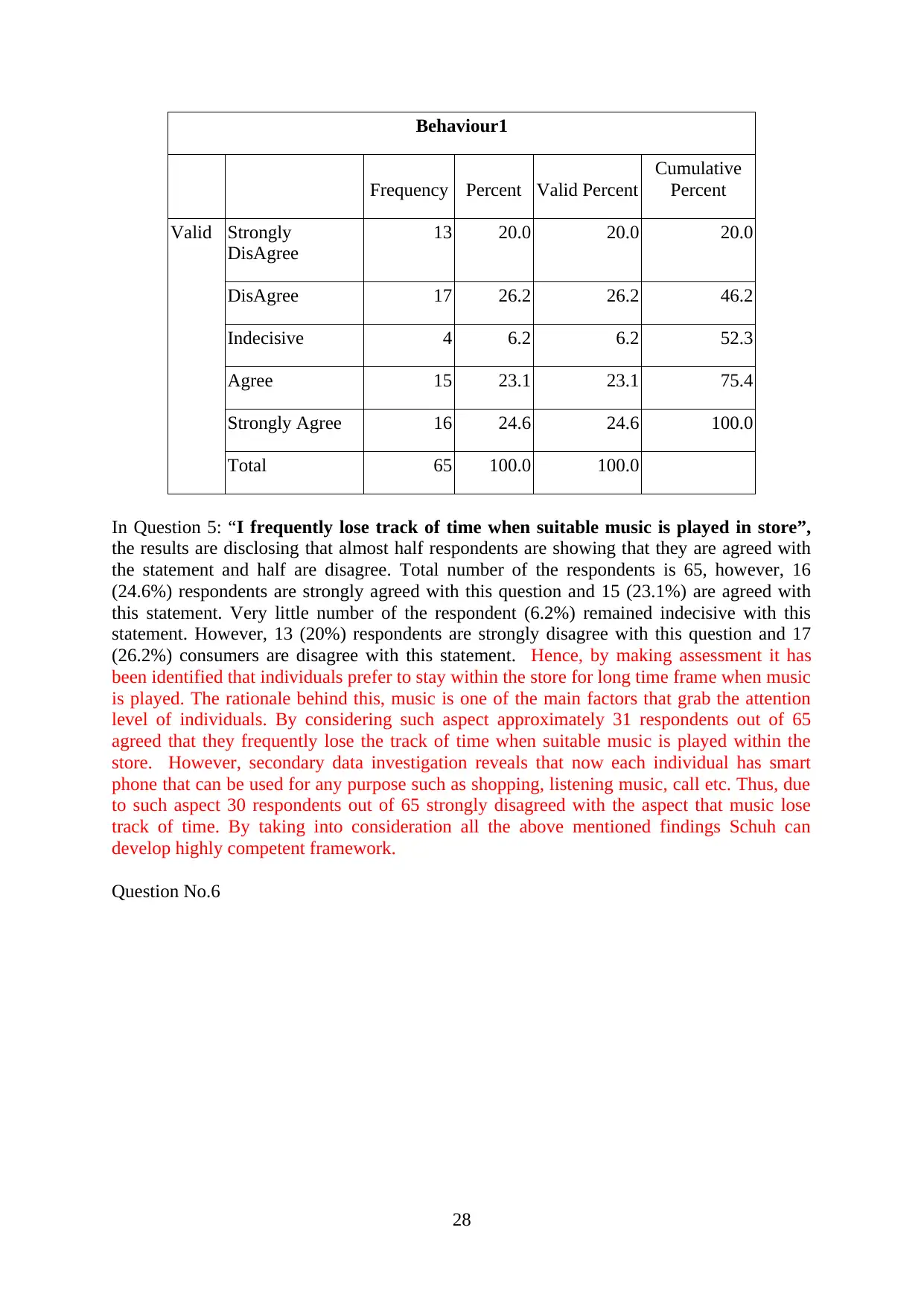
Behaviour1
Frequency Percent Valid Percent
Cumulative
Percent
Valid Strongly
DisAgree
13 20.0 20.0 20.0
DisAgree 17 26.2 26.2 46.2
Indecisive 4 6.2 6.2 52.3
Agree 15 23.1 23.1 75.4
Strongly Agree 16 24.6 24.6 100.0
Total 65 100.0 100.0
In Question 5: “I frequently lose track of time when suitable music is played in store”,
the results are disclosing that almost half respondents are showing that they are agreed with
the statement and half are disagree. Total number of the respondents is 65, however, 16
(24.6%) respondents are strongly agreed with this question and 15 (23.1%) are agreed with
this statement. Very little number of the respondent (6.2%) remained indecisive with this
statement. However, 13 (20%) respondents are strongly disagree with this question and 17
(26.2%) consumers are disagree with this statement. Hence, by making assessment it has
been identified that individuals prefer to stay within the store for long time frame when music
is played. The rationale behind this, music is one of the main factors that grab the attention
level of individuals. By considering such aspect approximately 31 respondents out of 65
agreed that they frequently lose the track of time when suitable music is played within the
store. However, secondary data investigation reveals that now each individual has smart
phone that can be used for any purpose such as shopping, listening music, call etc. Thus, due
to such aspect 30 respondents out of 65 strongly disagreed with the aspect that music lose
track of time. By taking into consideration all the above mentioned findings Schuh can
develop highly competent framework.
Question No.6
28
Frequency Percent Valid Percent
Cumulative
Percent
Valid Strongly
DisAgree
13 20.0 20.0 20.0
DisAgree 17 26.2 26.2 46.2
Indecisive 4 6.2 6.2 52.3
Agree 15 23.1 23.1 75.4
Strongly Agree 16 24.6 24.6 100.0
Total 65 100.0 100.0
In Question 5: “I frequently lose track of time when suitable music is played in store”,
the results are disclosing that almost half respondents are showing that they are agreed with
the statement and half are disagree. Total number of the respondents is 65, however, 16
(24.6%) respondents are strongly agreed with this question and 15 (23.1%) are agreed with
this statement. Very little number of the respondent (6.2%) remained indecisive with this
statement. However, 13 (20%) respondents are strongly disagree with this question and 17
(26.2%) consumers are disagree with this statement. Hence, by making assessment it has
been identified that individuals prefer to stay within the store for long time frame when music
is played. The rationale behind this, music is one of the main factors that grab the attention
level of individuals. By considering such aspect approximately 31 respondents out of 65
agreed that they frequently lose the track of time when suitable music is played within the
store. However, secondary data investigation reveals that now each individual has smart
phone that can be used for any purpose such as shopping, listening music, call etc. Thus, due
to such aspect 30 respondents out of 65 strongly disagreed with the aspect that music lose
track of time. By taking into consideration all the above mentioned findings Schuh can
develop highly competent framework.
Question No.6
28
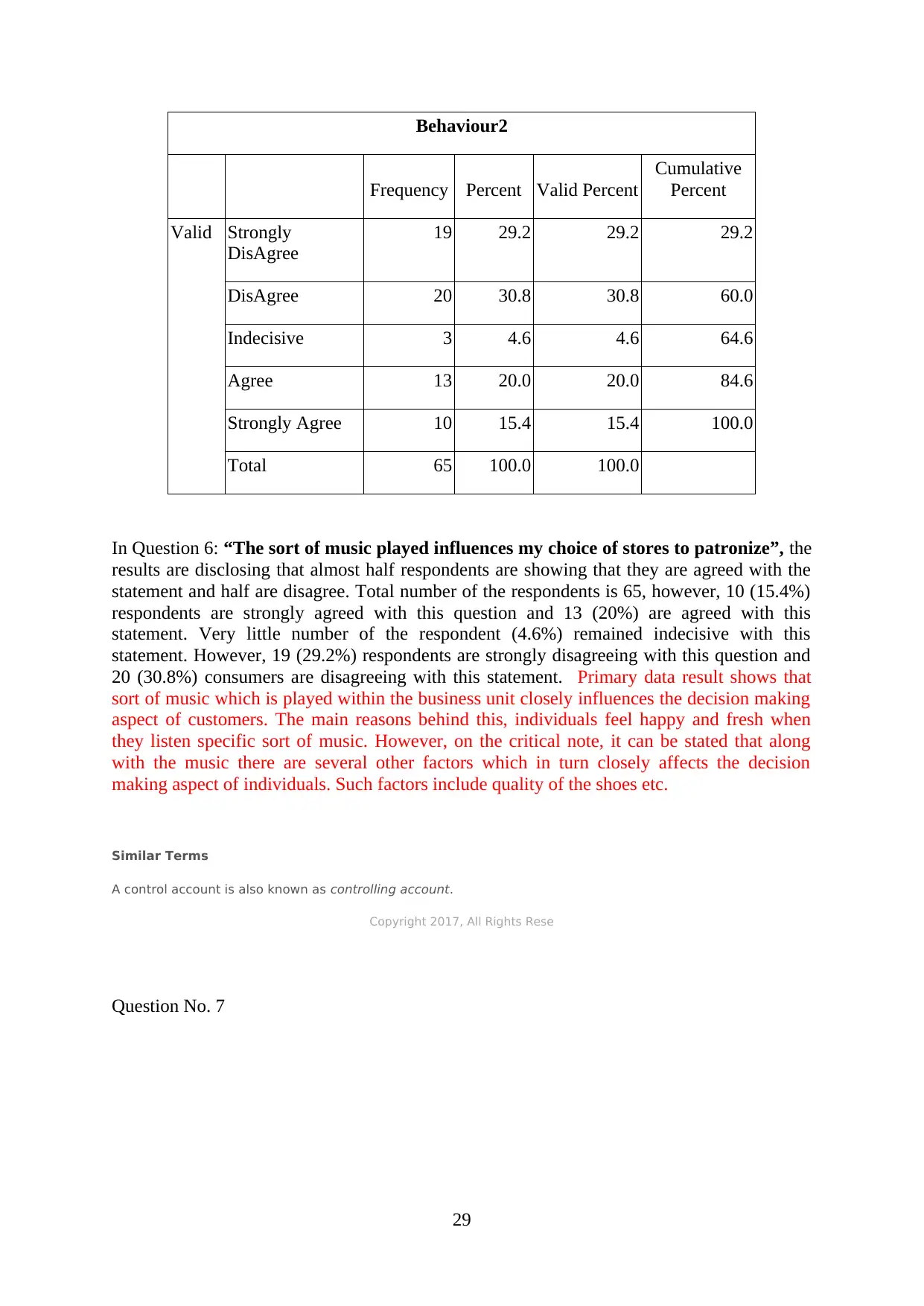
Behaviour2
Frequency Percent Valid Percent
Cumulative
Percent
Valid Strongly
DisAgree
19 29.2 29.2 29.2
DisAgree 20 30.8 30.8 60.0
Indecisive 3 4.6 4.6 64.6
Agree 13 20.0 20.0 84.6
Strongly Agree 10 15.4 15.4 100.0
Total 65 100.0 100.0
In Question 6: “The sort of music played influences my choice of stores to patronize”, the
results are disclosing that almost half respondents are showing that they are agreed with the
statement and half are disagree. Total number of the respondents is 65, however, 10 (15.4%)
respondents are strongly agreed with this question and 13 (20%) are agreed with this
statement. Very little number of the respondent (4.6%) remained indecisive with this
statement. However, 19 (29.2%) respondents are strongly disagreeing with this question and
20 (30.8%) consumers are disagreeing with this statement. Primary data result shows that
sort of music which is played within the business unit closely influences the decision making
aspect of customers. The main reasons behind this, individuals feel happy and fresh when
they listen specific sort of music. However, on the critical note, it can be stated that along
with the music there are several other factors which in turn closely affects the decision
making aspect of individuals. Such factors include quality of the shoes etc.
Similar Terms
A control account is also known as controlling account.
Copyright 2017, All Rights Rese
Question No. 7
29
Frequency Percent Valid Percent
Cumulative
Percent
Valid Strongly
DisAgree
19 29.2 29.2 29.2
DisAgree 20 30.8 30.8 60.0
Indecisive 3 4.6 4.6 64.6
Agree 13 20.0 20.0 84.6
Strongly Agree 10 15.4 15.4 100.0
Total 65 100.0 100.0
In Question 6: “The sort of music played influences my choice of stores to patronize”, the
results are disclosing that almost half respondents are showing that they are agreed with the
statement and half are disagree. Total number of the respondents is 65, however, 10 (15.4%)
respondents are strongly agreed with this question and 13 (20%) are agreed with this
statement. Very little number of the respondent (4.6%) remained indecisive with this
statement. However, 19 (29.2%) respondents are strongly disagreeing with this question and
20 (30.8%) consumers are disagreeing with this statement. Primary data result shows that
sort of music which is played within the business unit closely influences the decision making
aspect of customers. The main reasons behind this, individuals feel happy and fresh when
they listen specific sort of music. However, on the critical note, it can be stated that along
with the music there are several other factors which in turn closely affects the decision
making aspect of individuals. Such factors include quality of the shoes etc.
Similar Terms
A control account is also known as controlling account.
Copyright 2017, All Rights Rese
Question No. 7
29
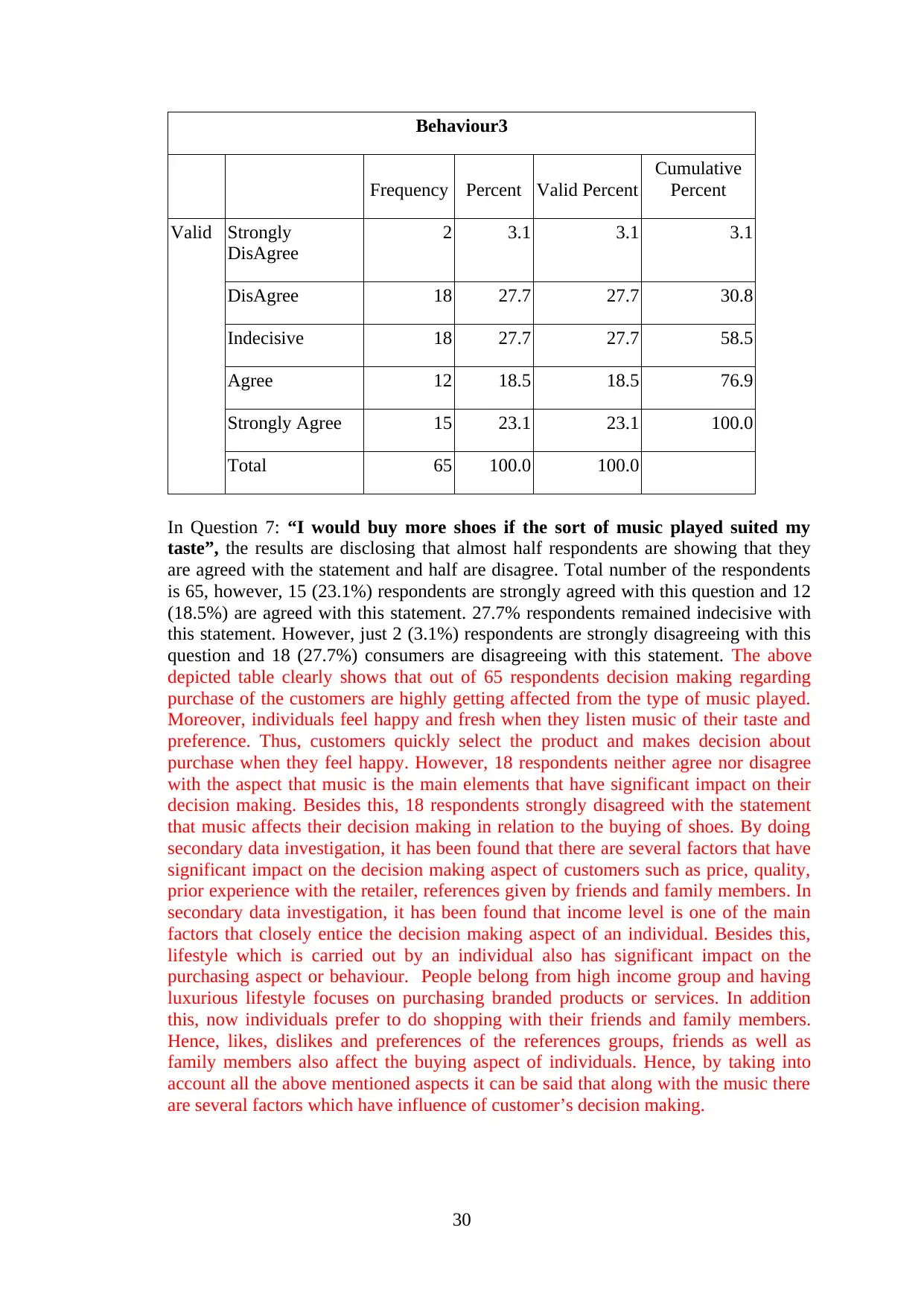
Behaviour3
Frequency Percent Valid Percent
Cumulative
Percent
Valid Strongly
DisAgree
2 3.1 3.1 3.1
DisAgree 18 27.7 27.7 30.8
Indecisive 18 27.7 27.7 58.5
Agree 12 18.5 18.5 76.9
Strongly Agree 15 23.1 23.1 100.0
Total 65 100.0 100.0
In Question 7: “I would buy more shoes if the sort of music played suited my
taste”, the results are disclosing that almost half respondents are showing that they
are agreed with the statement and half are disagree. Total number of the respondents
is 65, however, 15 (23.1%) respondents are strongly agreed with this question and 12
(18.5%) are agreed with this statement. 27.7% respondents remained indecisive with
this statement. However, just 2 (3.1%) respondents are strongly disagreeing with this
question and 18 (27.7%) consumers are disagreeing with this statement. The above
depicted table clearly shows that out of 65 respondents decision making regarding
purchase of the customers are highly getting affected from the type of music played.
Moreover, individuals feel happy and fresh when they listen music of their taste and
preference. Thus, customers quickly select the product and makes decision about
purchase when they feel happy. However, 18 respondents neither agree nor disagree
with the aspect that music is the main elements that have significant impact on their
decision making. Besides this, 18 respondents strongly disagreed with the statement
that music affects their decision making in relation to the buying of shoes. By doing
secondary data investigation, it has been found that there are several factors that have
significant impact on the decision making aspect of customers such as price, quality,
prior experience with the retailer, references given by friends and family members. In
secondary data investigation, it has been found that income level is one of the main
factors that closely entice the decision making aspect of an individual. Besides this,
lifestyle which is carried out by an individual also has significant impact on the
purchasing aspect or behaviour. People belong from high income group and having
luxurious lifestyle focuses on purchasing branded products or services. In addition
this, now individuals prefer to do shopping with their friends and family members.
Hence, likes, dislikes and preferences of the references groups, friends as well as
family members also affect the buying aspect of individuals. Hence, by taking into
account all the above mentioned aspects it can be said that along with the music there
are several factors which have influence of customer’s decision making.
30
Frequency Percent Valid Percent
Cumulative
Percent
Valid Strongly
DisAgree
2 3.1 3.1 3.1
DisAgree 18 27.7 27.7 30.8
Indecisive 18 27.7 27.7 58.5
Agree 12 18.5 18.5 76.9
Strongly Agree 15 23.1 23.1 100.0
Total 65 100.0 100.0
In Question 7: “I would buy more shoes if the sort of music played suited my
taste”, the results are disclosing that almost half respondents are showing that they
are agreed with the statement and half are disagree. Total number of the respondents
is 65, however, 15 (23.1%) respondents are strongly agreed with this question and 12
(18.5%) are agreed with this statement. 27.7% respondents remained indecisive with
this statement. However, just 2 (3.1%) respondents are strongly disagreeing with this
question and 18 (27.7%) consumers are disagreeing with this statement. The above
depicted table clearly shows that out of 65 respondents decision making regarding
purchase of the customers are highly getting affected from the type of music played.
Moreover, individuals feel happy and fresh when they listen music of their taste and
preference. Thus, customers quickly select the product and makes decision about
purchase when they feel happy. However, 18 respondents neither agree nor disagree
with the aspect that music is the main elements that have significant impact on their
decision making. Besides this, 18 respondents strongly disagreed with the statement
that music affects their decision making in relation to the buying of shoes. By doing
secondary data investigation, it has been found that there are several factors that have
significant impact on the decision making aspect of customers such as price, quality,
prior experience with the retailer, references given by friends and family members. In
secondary data investigation, it has been found that income level is one of the main
factors that closely entice the decision making aspect of an individual. Besides this,
lifestyle which is carried out by an individual also has significant impact on the
purchasing aspect or behaviour. People belong from high income group and having
luxurious lifestyle focuses on purchasing branded products or services. In addition
this, now individuals prefer to do shopping with their friends and family members.
Hence, likes, dislikes and preferences of the references groups, friends as well as
family members also affect the buying aspect of individuals. Hence, by taking into
account all the above mentioned aspects it can be said that along with the music there
are several factors which have influence of customer’s decision making.
30
Paraphrase This Document
Need a fresh take? Get an instant paraphrase of this document with our AI Paraphraser

Question No. 8
Behaviour4
Frequency Percent Valid Percent
Cumulative
Percent
Valid Strongly
DisAgree
3 4.6 4.6 4.6
DisAgree 8 12.3 12.3 16.9
Indecisive 2 3.1 3.1 20.0
Agree 24 36.9 36.9 56.9
Strongly Agree 28 43.1 43.1 100.0
Total 65 100.0 100.0
In Question 8: “The mood I am in affects my footwear purchasing behaviour”, the results
are disclosing that mostly respondents are showing that they are agreed with this question.
Total number of the respondents is 65, however, 28 (43.1%) respondents are strongly agreed
with this question and 24 (36.9%) are agreed with this statement. Very little number of the
respondent (3.1%) remained indecisive with this statement. However, 3 (4.6%) respondents
are strongly disagreeing with this question and 8 (12.3%) consumers are disagreeing with this
statement. By making evaluation, it has been identified that intention or mindset has great
impact on footwear purchasing decision. Moreover, without having an intention to purchase
individuals do not take interest in shoes which are displayed by the retailer. Hence, it is one
of the main reasons which in turn affects the purchasing behavior and decision making aspect
of customers.
31
Behaviour4
Frequency Percent Valid Percent
Cumulative
Percent
Valid Strongly
DisAgree
3 4.6 4.6 4.6
DisAgree 8 12.3 12.3 16.9
Indecisive 2 3.1 3.1 20.0
Agree 24 36.9 36.9 56.9
Strongly Agree 28 43.1 43.1 100.0
Total 65 100.0 100.0
In Question 8: “The mood I am in affects my footwear purchasing behaviour”, the results
are disclosing that mostly respondents are showing that they are agreed with this question.
Total number of the respondents is 65, however, 28 (43.1%) respondents are strongly agreed
with this question and 24 (36.9%) are agreed with this statement. Very little number of the
respondent (3.1%) remained indecisive with this statement. However, 3 (4.6%) respondents
are strongly disagreeing with this question and 8 (12.3%) consumers are disagreeing with this
statement. By making evaluation, it has been identified that intention or mindset has great
impact on footwear purchasing decision. Moreover, without having an intention to purchase
individuals do not take interest in shoes which are displayed by the retailer. Hence, it is one
of the main reasons which in turn affects the purchasing behavior and decision making aspect
of customers.
31
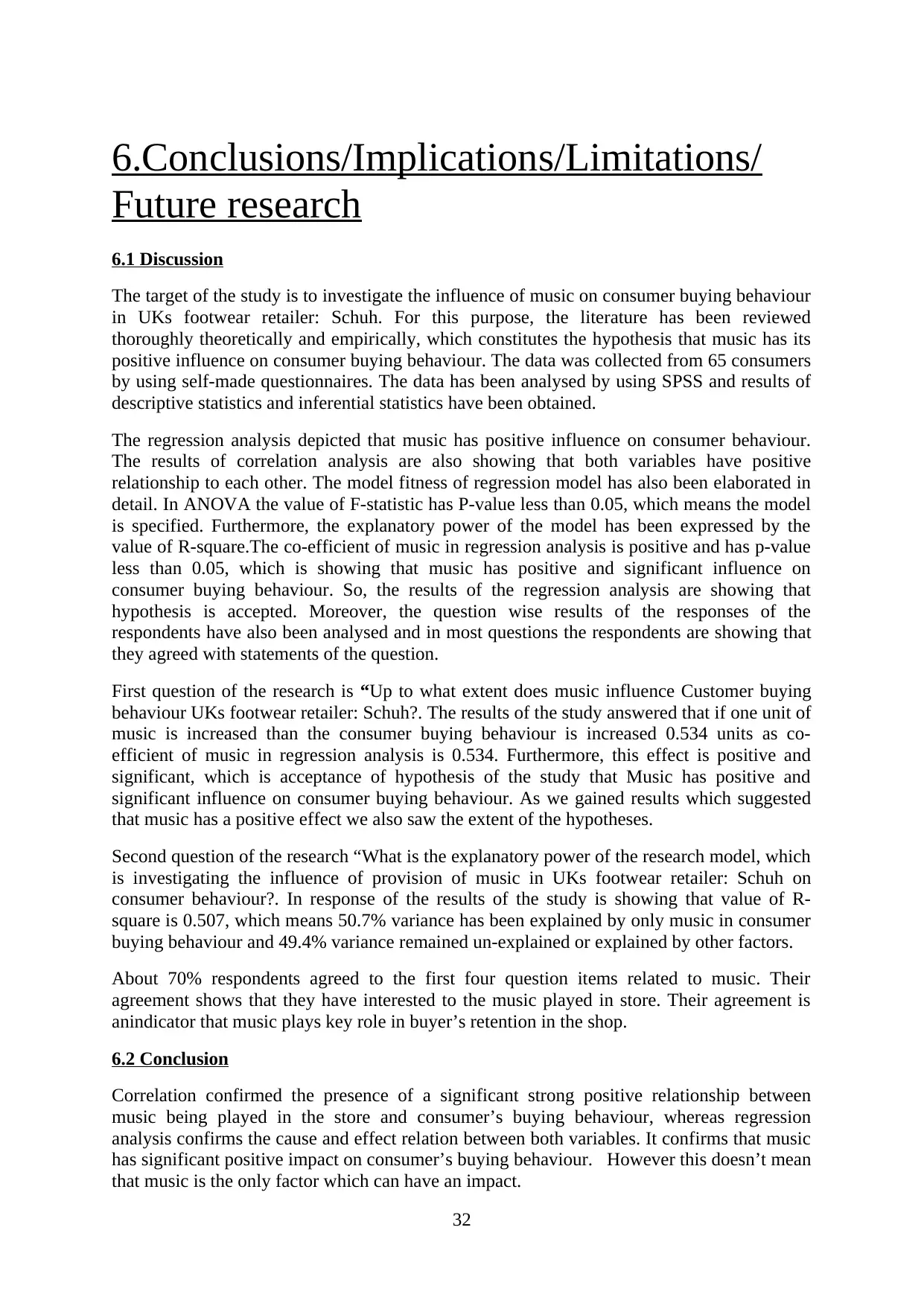
6.Conclusions/Implications/Limitations/
Future research
6.1 Discussion
The target of the study is to investigate the influence of music on consumer buying behaviour
in UKs footwear retailer: Schuh. For this purpose, the literature has been reviewed
thoroughly theoretically and empirically, which constitutes the hypothesis that music has its
positive influence on consumer buying behaviour. The data was collected from 65 consumers
by using self-made questionnaires. The data has been analysed by using SPSS and results of
descriptive statistics and inferential statistics have been obtained.
The regression analysis depicted that music has positive influence on consumer behaviour.
The results of correlation analysis are also showing that both variables have positive
relationship to each other. The model fitness of regression model has also been elaborated in
detail. In ANOVA the value of F-statistic has P-value less than 0.05, which means the model
is specified. Furthermore, the explanatory power of the model has been expressed by the
value of R-square.The co-efficient of music in regression analysis is positive and has p-value
less than 0.05, which is showing that music has positive and significant influence on
consumer buying behaviour. So, the results of the regression analysis are showing that
hypothesis is accepted. Moreover, the question wise results of the responses of the
respondents have also been analysed and in most questions the respondents are showing that
they agreed with statements of the question.
First question of the research is “Up to what extent does music influence Customer buying
behaviour UKs footwear retailer: Schuh?. The results of the study answered that if one unit of
music is increased than the consumer buying behaviour is increased 0.534 units as co-
efficient of music in regression analysis is 0.534. Furthermore, this effect is positive and
significant, which is acceptance of hypothesis of the study that Music has positive and
significant influence on consumer buying behaviour. As we gained results which suggested
that music has a positive effect we also saw the extent of the hypotheses.
Second question of the research “What is the explanatory power of the research model, which
is investigating the influence of provision of music in UKs footwear retailer: Schuh on
consumer behaviour?. In response of the results of the study is showing that value of R-
square is 0.507, which means 50.7% variance has been explained by only music in consumer
buying behaviour and 49.4% variance remained un-explained or explained by other factors.
About 70% respondents agreed to the first four question items related to music. Their
agreement shows that they have interested to the music played in store. Their agreement is
anindicator that music plays key role in buyer’s retention in the shop.
6.2 Conclusion
Correlation confirmed the presence of a significant strong positive relationship between
music being played in the store and consumer’s buying behaviour, whereas regression
analysis confirms the cause and effect relation between both variables. It confirms that music
has significant positive impact on consumer’s buying behaviour. However this doesn’t mean
that music is the only factor which can have an impact.
32
Future research
6.1 Discussion
The target of the study is to investigate the influence of music on consumer buying behaviour
in UKs footwear retailer: Schuh. For this purpose, the literature has been reviewed
thoroughly theoretically and empirically, which constitutes the hypothesis that music has its
positive influence on consumer buying behaviour. The data was collected from 65 consumers
by using self-made questionnaires. The data has been analysed by using SPSS and results of
descriptive statistics and inferential statistics have been obtained.
The regression analysis depicted that music has positive influence on consumer behaviour.
The results of correlation analysis are also showing that both variables have positive
relationship to each other. The model fitness of regression model has also been elaborated in
detail. In ANOVA the value of F-statistic has P-value less than 0.05, which means the model
is specified. Furthermore, the explanatory power of the model has been expressed by the
value of R-square.The co-efficient of music in regression analysis is positive and has p-value
less than 0.05, which is showing that music has positive and significant influence on
consumer buying behaviour. So, the results of the regression analysis are showing that
hypothesis is accepted. Moreover, the question wise results of the responses of the
respondents have also been analysed and in most questions the respondents are showing that
they agreed with statements of the question.
First question of the research is “Up to what extent does music influence Customer buying
behaviour UKs footwear retailer: Schuh?. The results of the study answered that if one unit of
music is increased than the consumer buying behaviour is increased 0.534 units as co-
efficient of music in regression analysis is 0.534. Furthermore, this effect is positive and
significant, which is acceptance of hypothesis of the study that Music has positive and
significant influence on consumer buying behaviour. As we gained results which suggested
that music has a positive effect we also saw the extent of the hypotheses.
Second question of the research “What is the explanatory power of the research model, which
is investigating the influence of provision of music in UKs footwear retailer: Schuh on
consumer behaviour?. In response of the results of the study is showing that value of R-
square is 0.507, which means 50.7% variance has been explained by only music in consumer
buying behaviour and 49.4% variance remained un-explained or explained by other factors.
About 70% respondents agreed to the first four question items related to music. Their
agreement shows that they have interested to the music played in store. Their agreement is
anindicator that music plays key role in buyer’s retention in the shop.
6.2 Conclusion
Correlation confirmed the presence of a significant strong positive relationship between
music being played in the store and consumer’s buying behaviour, whereas regression
analysis confirms the cause and effect relation between both variables. It confirms that music
has significant positive impact on consumer’s buying behaviour. However this doesn’t mean
that music is the only factor which can have an impact.
32
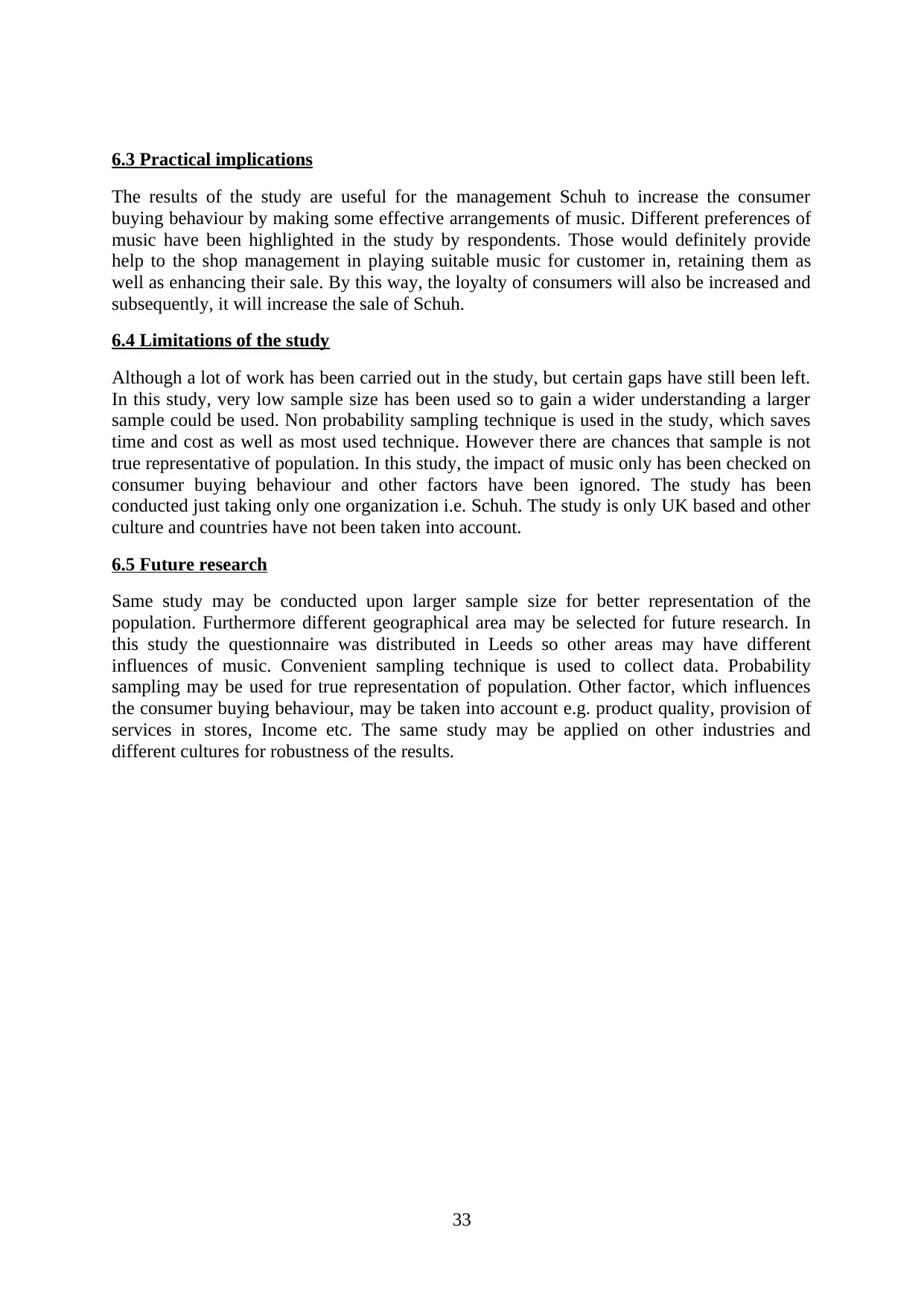
6.3 Practical implications
The results of the study are useful for the management Schuh to increase the consumer
buying behaviour by making some effective arrangements of music. Different preferences of
music have been highlighted in the study by respondents. Those would definitely provide
help to the shop management in playing suitable music for customer in, retaining them as
well as enhancing their sale. By this way, the loyalty of consumers will also be increased and
subsequently, it will increase the sale of Schuh.
6.4 Limitations of the study
Although a lot of work has been carried out in the study, but certain gaps have still been left.
In this study, very low sample size has been used so to gain a wider understanding a larger
sample could be used. Non probability sampling technique is used in the study, which saves
time and cost as well as most used technique. However there are chances that sample is not
true representative of population. In this study, the impact of music only has been checked on
consumer buying behaviour and other factors have been ignored. The study has been
conducted just taking only one organization i.e. Schuh. The study is only UK based and other
culture and countries have not been taken into account.
6.5 Future research
Same study may be conducted upon larger sample size for better representation of the
population. Furthermore different geographical area may be selected for future research. In
this study the questionnaire was distributed in Leeds so other areas may have different
influences of music. Convenient sampling technique is used to collect data. Probability
sampling may be used for true representation of population. Other factor, which influences
the consumer buying behaviour, may be taken into account e.g. product quality, provision of
services in stores, Income etc. The same study may be applied on other industries and
different cultures for robustness of the results.
33
The results of the study are useful for the management Schuh to increase the consumer
buying behaviour by making some effective arrangements of music. Different preferences of
music have been highlighted in the study by respondents. Those would definitely provide
help to the shop management in playing suitable music for customer in, retaining them as
well as enhancing their sale. By this way, the loyalty of consumers will also be increased and
subsequently, it will increase the sale of Schuh.
6.4 Limitations of the study
Although a lot of work has been carried out in the study, but certain gaps have still been left.
In this study, very low sample size has been used so to gain a wider understanding a larger
sample could be used. Non probability sampling technique is used in the study, which saves
time and cost as well as most used technique. However there are chances that sample is not
true representative of population. In this study, the impact of music only has been checked on
consumer buying behaviour and other factors have been ignored. The study has been
conducted just taking only one organization i.e. Schuh. The study is only UK based and other
culture and countries have not been taken into account.
6.5 Future research
Same study may be conducted upon larger sample size for better representation of the
population. Furthermore different geographical area may be selected for future research. In
this study the questionnaire was distributed in Leeds so other areas may have different
influences of music. Convenient sampling technique is used to collect data. Probability
sampling may be used for true representation of population. Other factor, which influences
the consumer buying behaviour, may be taken into account e.g. product quality, provision of
services in stores, Income etc. The same study may be applied on other industries and
different cultures for robustness of the results.
33
Secure Best Marks with AI Grader
Need help grading? Try our AI Grader for instant feedback on your assignments.
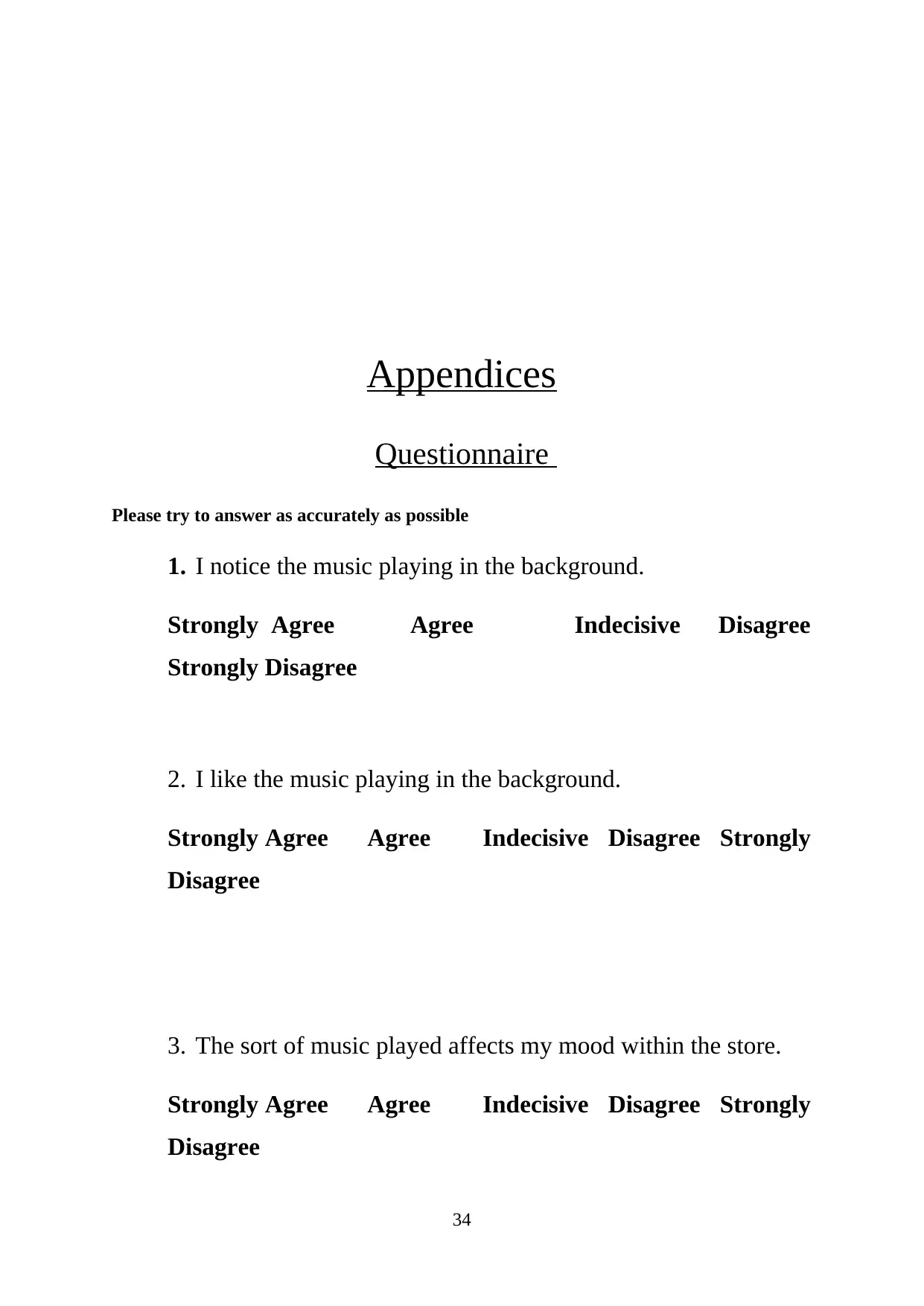
Appendices
Questionnaire
Please try to answer as accurately as possible
1. I notice the music playing in the background.
Strongly Agree Agree Indecisive Disagree
Strongly Disagree
2. I like the music playing in the background.
Strongly Agree Agree Indecisive Disagree Strongly
Disagree
3. The sort of music played affects my mood within the store.
Strongly Agree Agree Indecisive Disagree Strongly
Disagree
34
Questionnaire
Please try to answer as accurately as possible
1. I notice the music playing in the background.
Strongly Agree Agree Indecisive Disagree
Strongly Disagree
2. I like the music playing in the background.
Strongly Agree Agree Indecisive Disagree Strongly
Disagree
3. The sort of music played affects my mood within the store.
Strongly Agree Agree Indecisive Disagree Strongly
Disagree
34
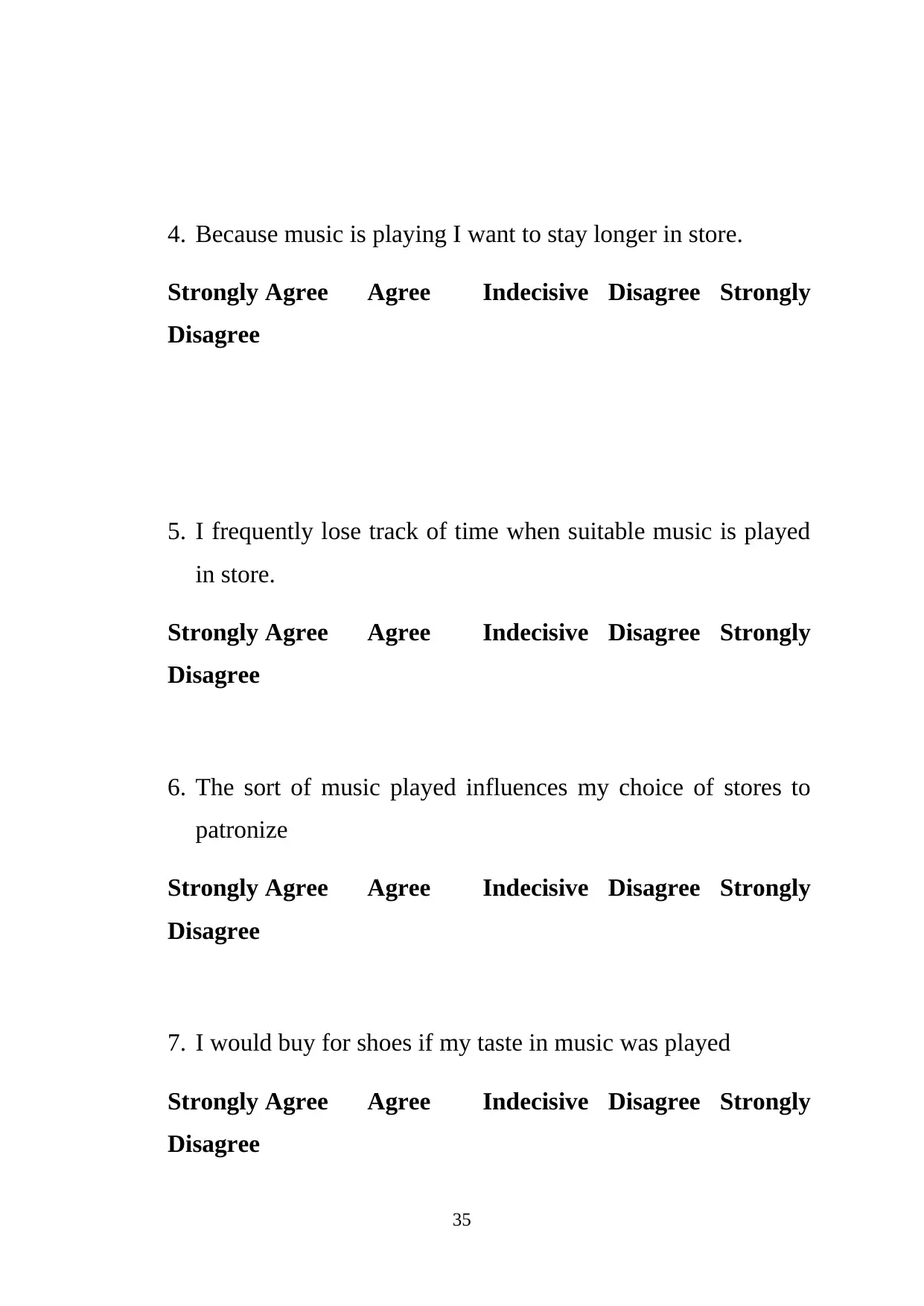
4. Because music is playing I want to stay longer in store.
Strongly Agree Agree Indecisive Disagree Strongly
Disagree
5. I frequently lose track of time when suitable music is played
in store.
Strongly Agree Agree Indecisive Disagree Strongly
Disagree
6. The sort of music played influences my choice of stores to
patronize
Strongly Agree Agree Indecisive Disagree Strongly
Disagree
7. I would buy for shoes if my taste in music was played
Strongly Agree Agree Indecisive Disagree Strongly
Disagree
35
Strongly Agree Agree Indecisive Disagree Strongly
Disagree
5. I frequently lose track of time when suitable music is played
in store.
Strongly Agree Agree Indecisive Disagree Strongly
Disagree
6. The sort of music played influences my choice of stores to
patronize
Strongly Agree Agree Indecisive Disagree Strongly
Disagree
7. I would buy for shoes if my taste in music was played
Strongly Agree Agree Indecisive Disagree Strongly
Disagree
35
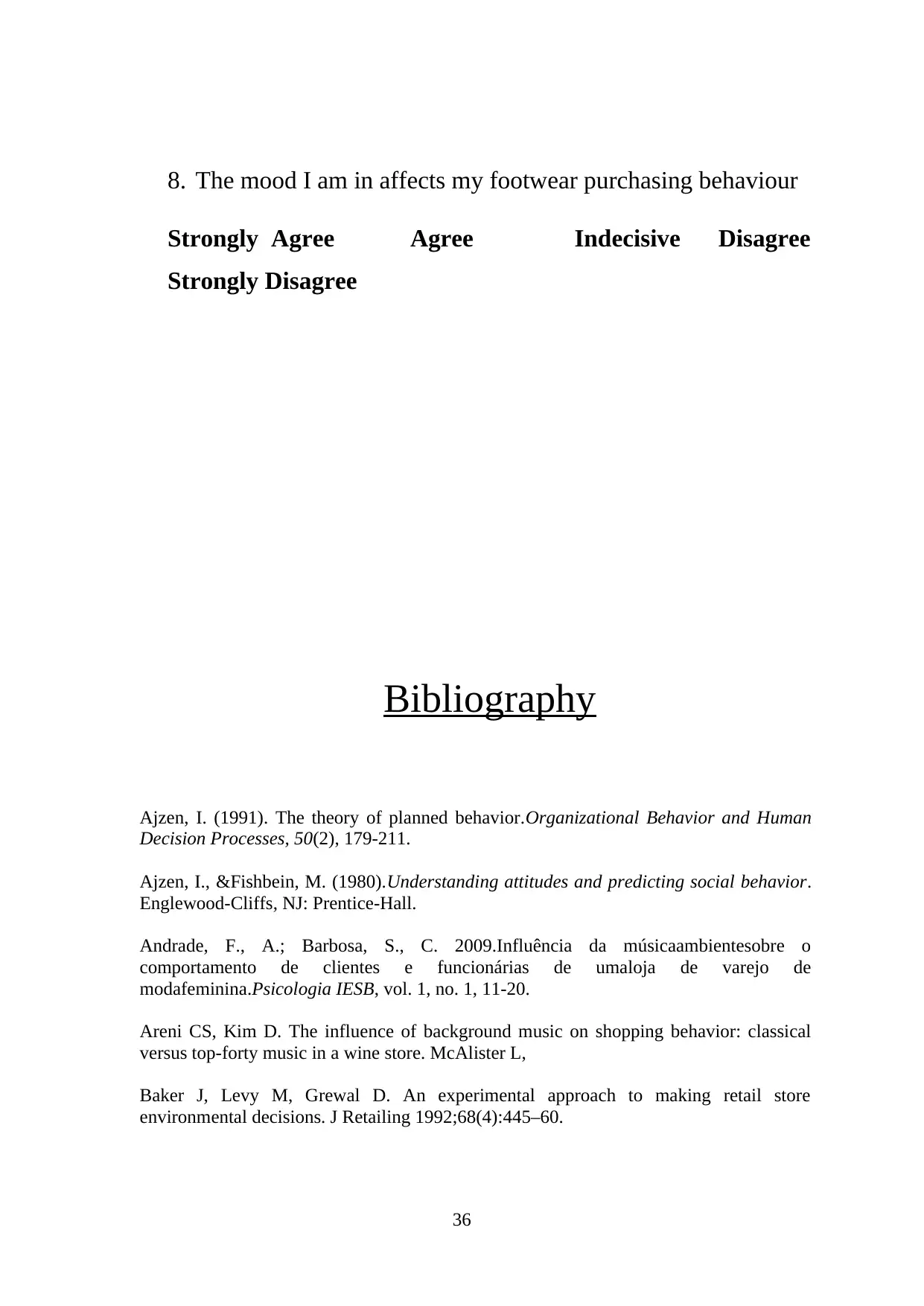
8. The mood I am in affects my footwear purchasing behaviour
Strongly Agree Agree Indecisive Disagree
Strongly Disagree
Bibliography
Ajzen, I. (1991). The theory of planned behavior.Organizational Behavior and Human
Decision Processes, 50(2), 179-211.
Ajzen, I., &Fishbein, M. (1980).Understanding attitudes and predicting social behavior.
Englewood-Cliffs, NJ: Prentice-Hall.
Andrade, F., A.; Barbosa, S., C. 2009.Influência da músicaambientesobre o
comportamento de clientes e funcionárias de umaloja de varejo de
modafeminina.Psicologia IESB, vol. 1, no. 1, 11-20.
Areni CS, Kim D. The influence of background music on shopping behavior: classical
versus top-forty music in a wine store. McAlister L,
Baker J, Levy M, Grewal D. An experimental approach to making retail store
environmental decisions. J Retailing 1992;68(4):445–60.
36
Strongly Agree Agree Indecisive Disagree
Strongly Disagree
Bibliography
Ajzen, I. (1991). The theory of planned behavior.Organizational Behavior and Human
Decision Processes, 50(2), 179-211.
Ajzen, I., &Fishbein, M. (1980).Understanding attitudes and predicting social behavior.
Englewood-Cliffs, NJ: Prentice-Hall.
Andrade, F., A.; Barbosa, S., C. 2009.Influência da músicaambientesobre o
comportamento de clientes e funcionárias de umaloja de varejo de
modafeminina.Psicologia IESB, vol. 1, no. 1, 11-20.
Areni CS, Kim D. The influence of background music on shopping behavior: classical
versus top-forty music in a wine store. McAlister L,
Baker J, Levy M, Grewal D. An experimental approach to making retail store
environmental decisions. J Retailing 1992;68(4):445–60.
36
Paraphrase This Document
Need a fresh take? Get an instant paraphrase of this document with our AI Paraphraser
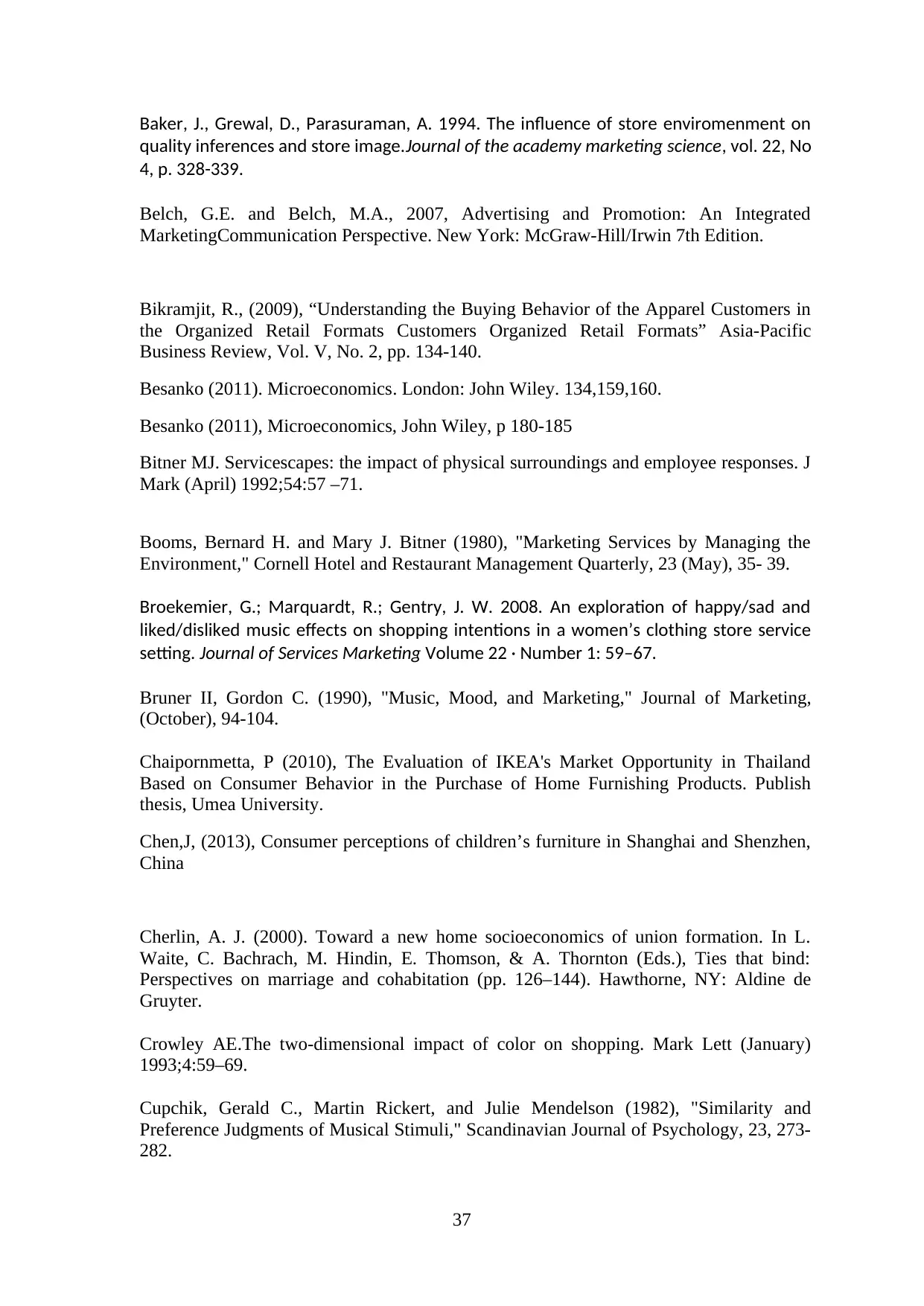
Baker, J., Grewal, D., Parasuraman, A. 1994. The influence of store enviromenment on
quality inferences and store image.Journal of the academy marketing science, vol. 22, No
4, p. 328-339.
Belch, G.E. and Belch, M.A., 2007, Advertising and Promotion: An Integrated
MarketingCommunication Perspective. New York: McGraw-Hill/Irwin 7th Edition.
Bikramjit, R., (2009), “Understanding the Buying Behavior of the Apparel Customers in
the Organized Retail Formats Customers Organized Retail Formats” Asia-Pacific
Business Review, Vol. V, No. 2, pp. 134-140.
Besanko (2011). Microeconomics. London: John Wiley. 134,159,160.
Besanko (2011), Microeconomics, John Wiley, p 180-185
Bitner MJ. Servicescapes: the impact of physical surroundings and employee responses. J
Mark (April) 1992;54:57 –71.
Booms, Bernard H. and Mary J. Bitner (1980), "Marketing Services by Managing the
Environment," Cornell Hotel and Restaurant Management Quarterly, 23 (May), 35- 39.
Broekemier, G.; Marquardt, R.; Gentry, J. W. 2008. An exploration of happy/sad and
liked/disliked music effects on shopping intentions in a women’s clothing store service
setting. Journal of Services Marketing Volume 22 · Number 1: 59–67.
Bruner II, Gordon C. (1990), "Music, Mood, and Marketing," Journal of Marketing,
(October), 94-104.
Chaipornmetta, P (2010), The Evaluation of IKEA's Market Opportunity in Thailand
Based on Consumer Behavior in the Purchase of Home Furnishing Products. Publish
thesis, Umea University.
Chen,J, (2013), Consumer perceptions of children’s furniture in Shanghai and Shenzhen,
China
Cherlin, A. J. (2000). Toward a new home socioeconomics of union formation. In L.
Waite, C. Bachrach, M. Hindin, E. Thomson, & A. Thornton (Eds.), Ties that bind:
Perspectives on marriage and cohabitation (pp. 126–144). Hawthorne, NY: Aldine de
Gruyter.
Crowley AE.The two-dimensional impact of color on shopping. Mark Lett (January)
1993;4:59–69.
Cupchik, Gerald C., Martin Rickert, and Julie Mendelson (1982), "Similarity and
Preference Judgments of Musical Stimuli," Scandinavian Journal of Psychology, 23, 273-
282.
37
quality inferences and store image.Journal of the academy marketing science, vol. 22, No
4, p. 328-339.
Belch, G.E. and Belch, M.A., 2007, Advertising and Promotion: An Integrated
MarketingCommunication Perspective. New York: McGraw-Hill/Irwin 7th Edition.
Bikramjit, R., (2009), “Understanding the Buying Behavior of the Apparel Customers in
the Organized Retail Formats Customers Organized Retail Formats” Asia-Pacific
Business Review, Vol. V, No. 2, pp. 134-140.
Besanko (2011). Microeconomics. London: John Wiley. 134,159,160.
Besanko (2011), Microeconomics, John Wiley, p 180-185
Bitner MJ. Servicescapes: the impact of physical surroundings and employee responses. J
Mark (April) 1992;54:57 –71.
Booms, Bernard H. and Mary J. Bitner (1980), "Marketing Services by Managing the
Environment," Cornell Hotel and Restaurant Management Quarterly, 23 (May), 35- 39.
Broekemier, G.; Marquardt, R.; Gentry, J. W. 2008. An exploration of happy/sad and
liked/disliked music effects on shopping intentions in a women’s clothing store service
setting. Journal of Services Marketing Volume 22 · Number 1: 59–67.
Bruner II, Gordon C. (1990), "Music, Mood, and Marketing," Journal of Marketing,
(October), 94-104.
Chaipornmetta, P (2010), The Evaluation of IKEA's Market Opportunity in Thailand
Based on Consumer Behavior in the Purchase of Home Furnishing Products. Publish
thesis, Umea University.
Chen,J, (2013), Consumer perceptions of children’s furniture in Shanghai and Shenzhen,
China
Cherlin, A. J. (2000). Toward a new home socioeconomics of union formation. In L.
Waite, C. Bachrach, M. Hindin, E. Thomson, & A. Thornton (Eds.), Ties that bind:
Perspectives on marriage and cohabitation (pp. 126–144). Hawthorne, NY: Aldine de
Gruyter.
Crowley AE.The two-dimensional impact of color on shopping. Mark Lett (January)
1993;4:59–69.
Cupchik, Gerald C., Martin Rickert, and Julie Mendelson (1982), "Similarity and
Preference Judgments of Musical Stimuli," Scandinavian Journal of Psychology, 23, 273-
282.
37
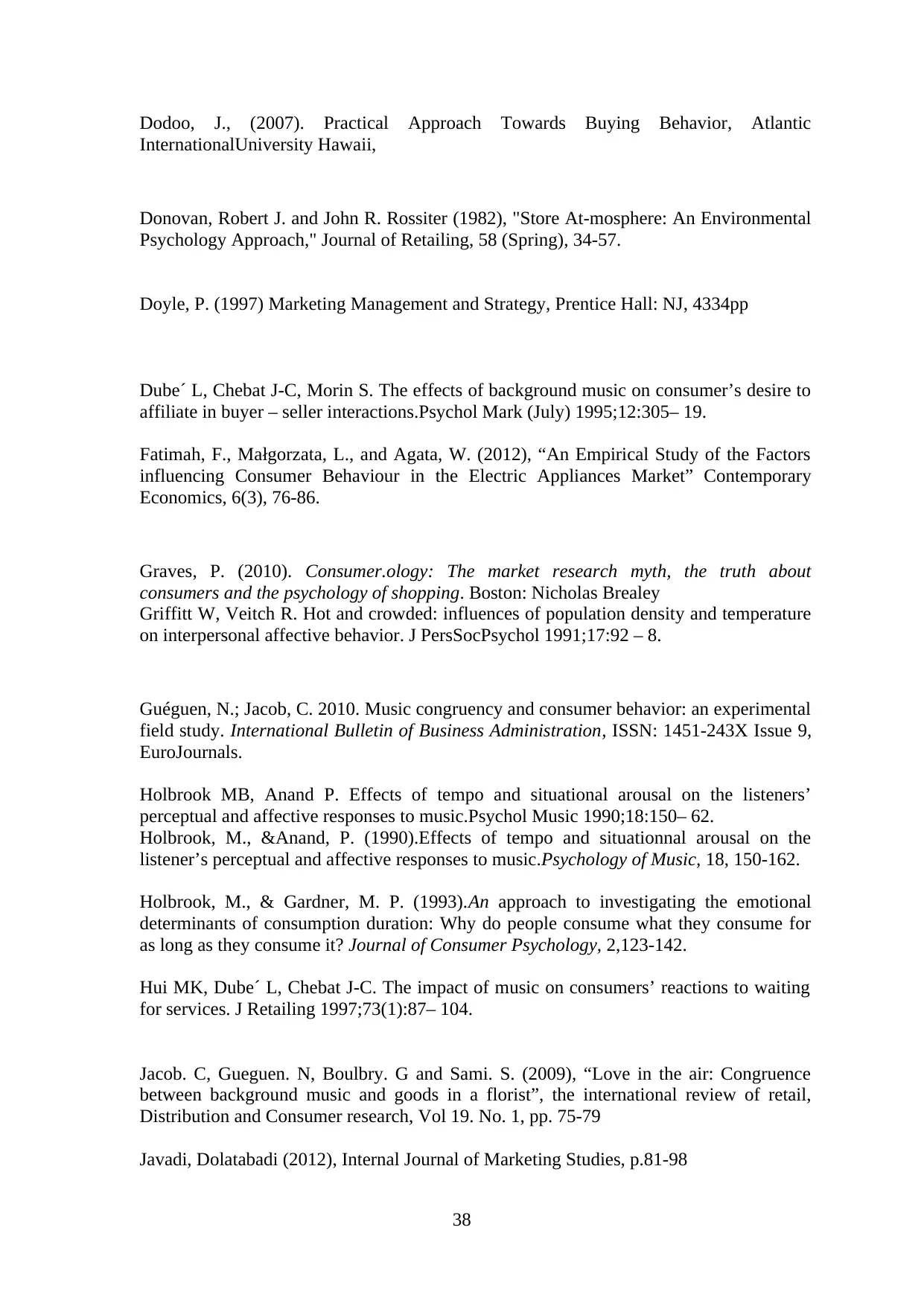
Dodoo, J., (2007). Practical Approach Towards Buying Behavior, Atlantic
InternationalUniversity Hawaii,
Donovan, Robert J. and John R. Rossiter (1982), "Store At-mosphere: An Environmental
Psychology Approach," Journal of Retailing, 58 (Spring), 34-57.
Doyle, P. (1997) Marketing Management and Strategy, Prentice Hall: NJ, 4334pp
Dube´ L, Chebat J-C, Morin S. The effects of background music on consumer’s desire to
affiliate in buyer – seller interactions.Psychol Mark (July) 1995;12:305– 19.
Fatimah, F., Małgorzata, L., and Agata, W. (2012), “An Empirical Study of the Factors
influencing Consumer Behaviour in the Electric Appliances Market” Contemporary
Economics, 6(3), 76-86.
Graves, P. (2010). Consumer.ology: The market research myth, the truth about
consumers and the psychology of shopping. Boston: Nicholas Brealey
Griffitt W, Veitch R. Hot and crowded: influences of population density and temperature
on interpersonal affective behavior. J PersSocPsychol 1991;17:92 – 8.
Guéguen, N.; Jacob, C. 2010. Music congruency and consumer behavior: an experimental
field study. International Bulletin of Business Administration, ISSN: 1451-243X Issue 9,
EuroJournals.
Holbrook MB, Anand P. Effects of tempo and situational arousal on the listeners’
perceptual and affective responses to music.Psychol Music 1990;18:150– 62.
Holbrook, M., &Anand, P. (1990).Effects of tempo and situationnal arousal on the
listener’s perceptual and affective responses to music.Psychology of Music, 18, 150-162.
Holbrook, M., & Gardner, M. P. (1993).An approach to investigating the emotional
determinants of consumption duration: Why do people consume what they consume for
as long as they consume it? Journal of Consumer Psychology, 2,123-142.
Hui MK, Dube´ L, Chebat J-C. The impact of music on consumers’ reactions to waiting
for services. J Retailing 1997;73(1):87– 104.
Jacob. C, Gueguen. N, Boulbry. G and Sami. S. (2009), “Love in the air: Congruence
between background music and goods in a florist”, the international review of retail,
Distribution and Consumer research, Vol 19. No. 1, pp. 75-79
Javadi, Dolatabadi (2012), Internal Journal of Marketing Studies, p.81-98
38
InternationalUniversity Hawaii,
Donovan, Robert J. and John R. Rossiter (1982), "Store At-mosphere: An Environmental
Psychology Approach," Journal of Retailing, 58 (Spring), 34-57.
Doyle, P. (1997) Marketing Management and Strategy, Prentice Hall: NJ, 4334pp
Dube´ L, Chebat J-C, Morin S. The effects of background music on consumer’s desire to
affiliate in buyer – seller interactions.Psychol Mark (July) 1995;12:305– 19.
Fatimah, F., Małgorzata, L., and Agata, W. (2012), “An Empirical Study of the Factors
influencing Consumer Behaviour in the Electric Appliances Market” Contemporary
Economics, 6(3), 76-86.
Graves, P. (2010). Consumer.ology: The market research myth, the truth about
consumers and the psychology of shopping. Boston: Nicholas Brealey
Griffitt W, Veitch R. Hot and crowded: influences of population density and temperature
on interpersonal affective behavior. J PersSocPsychol 1991;17:92 – 8.
Guéguen, N.; Jacob, C. 2010. Music congruency and consumer behavior: an experimental
field study. International Bulletin of Business Administration, ISSN: 1451-243X Issue 9,
EuroJournals.
Holbrook MB, Anand P. Effects of tempo and situational arousal on the listeners’
perceptual and affective responses to music.Psychol Music 1990;18:150– 62.
Holbrook, M., &Anand, P. (1990).Effects of tempo and situationnal arousal on the
listener’s perceptual and affective responses to music.Psychology of Music, 18, 150-162.
Holbrook, M., & Gardner, M. P. (1993).An approach to investigating the emotional
determinants of consumption duration: Why do people consume what they consume for
as long as they consume it? Journal of Consumer Psychology, 2,123-142.
Hui MK, Dube´ L, Chebat J-C. The impact of music on consumers’ reactions to waiting
for services. J Retailing 1997;73(1):87– 104.
Jacob. C, Gueguen. N, Boulbry. G and Sami. S. (2009), “Love in the air: Congruence
between background music and goods in a florist”, the international review of retail,
Distribution and Consumer research, Vol 19. No. 1, pp. 75-79
Javadi, Dolatabadi (2012), Internal Journal of Marketing Studies, p.81-98
38

Jobber, David. & Geoff, Lancaster. 2000, Selling and Sales Management, Pitman
Publishing.
Kellaris JJ, Kent RJ. The influence of music on consumers’ temporal perceptions: does
time fly when you’re having fun. J ConsumPsychol 1992;1(4):365 – 76.
Kellaris, J. J., & Rice, R. C. (1993).The influence of tempo, loudness, and gender of
listener on responses to music.Psychology &Marketing, 10, 15-29.
Kotler, P, Armstrong, G, 2006, Marketing principles, Translated by Bahman
Frozandeh,Amokhteh Publication, 5th Publication, Esfahan
Kotler, P. (1973). Atmospherics as a marketing tool.Journal of Retailing, 49(4), 48.
Retrievedfrom http://web.ebscohost.com/ehost/pdfviewer/pdfviewer?
vid=5&sid=902f4f4c-17f6- 482f-b329-d973deb9e727%40sessionmgr110&hid=10.
Kotler, P. (1994). Marketing management - analysis, planning, implementation, and
control.Prentice-Hall Inc, Englewood Clifts.1-801 pp.
Kotler, P. 1973. Atmospherics as a Marketing Tool.Journal of Retailing 49(winter): 48-64.
Kotler, P., Armstrong, G. (2007). Principles of Marketing. Upper Saddle River, NJ:
Prentice Hall.
Kuester, Sabine (2012): MKT 301: Strategic Marketing & Marketing in Specific
IndustryContexts, University of Mannheim, p-110L
Lindberg, P. J. (2009, November). Bad music in public spaces.Travel + Leisure.Retrieved
from http://www.travelandleisure.com/articles/bad-music-in-public-spaces.
Lindberg, P. J. (2009, November). Bad music in public spaces.Travel + Leisure.Lindberg,
P. J. (2009, November). Bad music in public spaces.Travel + Leisure. Retrieved from
http://www.travelandleisure.com/articles/bad-music-in-public-spaces
Mandila, M.; Gerogiannis,V. 2012. The effects of music on customer behavior and
satisfaction in the region of Larissa – the cases of two coffe bars.International conference
on contemporary marketing issues (ICCMI).
Mayer, C. (2012). Are you as sick of loud music in stores as I am? Forbes. Retrieved
fromhttp://www.forbes.com/sites/nextavenue/2012/12/27/are-you-as-sick-of-loud-music-
instores-as-i-am/
Mehrabian, A. (1980), Basic Dimensions for a General Psy-chological Theory,
Cambridge, MA: Oelgeschlager, Gunn, and Hain.
39
Publishing.
Kellaris JJ, Kent RJ. The influence of music on consumers’ temporal perceptions: does
time fly when you’re having fun. J ConsumPsychol 1992;1(4):365 – 76.
Kellaris, J. J., & Rice, R. C. (1993).The influence of tempo, loudness, and gender of
listener on responses to music.Psychology &Marketing, 10, 15-29.
Kotler, P, Armstrong, G, 2006, Marketing principles, Translated by Bahman
Frozandeh,Amokhteh Publication, 5th Publication, Esfahan
Kotler, P. (1973). Atmospherics as a marketing tool.Journal of Retailing, 49(4), 48.
Retrievedfrom http://web.ebscohost.com/ehost/pdfviewer/pdfviewer?
vid=5&sid=902f4f4c-17f6- 482f-b329-d973deb9e727%40sessionmgr110&hid=10.
Kotler, P. (1994). Marketing management - analysis, planning, implementation, and
control.Prentice-Hall Inc, Englewood Clifts.1-801 pp.
Kotler, P. 1973. Atmospherics as a Marketing Tool.Journal of Retailing 49(winter): 48-64.
Kotler, P., Armstrong, G. (2007). Principles of Marketing. Upper Saddle River, NJ:
Prentice Hall.
Kuester, Sabine (2012): MKT 301: Strategic Marketing & Marketing in Specific
IndustryContexts, University of Mannheim, p-110L
Lindberg, P. J. (2009, November). Bad music in public spaces.Travel + Leisure.Retrieved
from http://www.travelandleisure.com/articles/bad-music-in-public-spaces.
Lindberg, P. J. (2009, November). Bad music in public spaces.Travel + Leisure.Lindberg,
P. J. (2009, November). Bad music in public spaces.Travel + Leisure. Retrieved from
http://www.travelandleisure.com/articles/bad-music-in-public-spaces
Mandila, M.; Gerogiannis,V. 2012. The effects of music on customer behavior and
satisfaction in the region of Larissa – the cases of two coffe bars.International conference
on contemporary marketing issues (ICCMI).
Mayer, C. (2012). Are you as sick of loud music in stores as I am? Forbes. Retrieved
fromhttp://www.forbes.com/sites/nextavenue/2012/12/27/are-you-as-sick-of-loud-music-
instores-as-i-am/
Mehrabian, A. (1980), Basic Dimensions for a General Psy-chological Theory,
Cambridge, MA: Oelgeschlager, Gunn, and Hain.
39
Secure Best Marks with AI Grader
Need help grading? Try our AI Grader for instant feedback on your assignments.
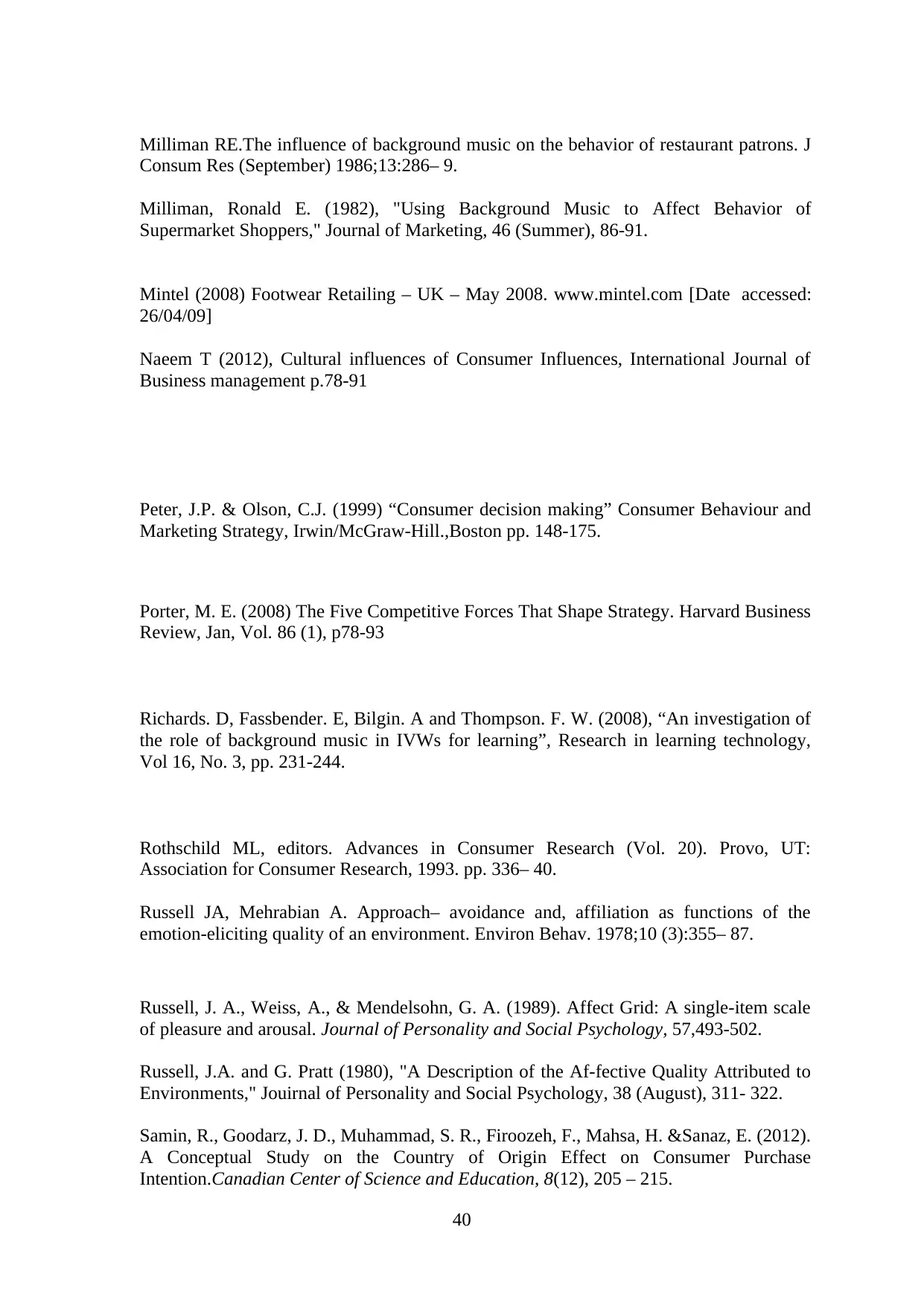
Milliman RE.The influence of background music on the behavior of restaurant patrons. J
Consum Res (September) 1986;13:286– 9.
Milliman, Ronald E. (1982), "Using Background Music to Affect Behavior of
Supermarket Shoppers," Journal of Marketing, 46 (Summer), 86-91.
Mintel (2008) Footwear Retailing – UK – May 2008. www.mintel.com [Date accessed:
26/04/09]
Naeem T (2012), Cultural influences of Consumer Influences, International Journal of
Business management p.78-91
Peter, J.P. & Olson, C.J. (1999) “Consumer decision making” Consumer Behaviour and
Marketing Strategy, Irwin/McGraw-Hill.,Boston pp. 148-175.
Porter, M. E. (2008) The Five Competitive Forces That Shape Strategy. Harvard Business
Review, Jan, Vol. 86 (1), p78-93
Richards. D, Fassbender. E, Bilgin. A and Thompson. F. W. (2008), “An investigation of
the role of background music in IVWs for learning”, Research in learning technology,
Vol 16, No. 3, pp. 231-244.
Rothschild ML, editors. Advances in Consumer Research (Vol. 20). Provo, UT:
Association for Consumer Research, 1993. pp. 336– 40.
Russell JA, Mehrabian A. Approach– avoidance and, affiliation as functions of the
emotion-eliciting quality of an environment. Environ Behav. 1978;10 (3):355– 87.
Russell, J. A., Weiss, A., & Mendelsohn, G. A. (1989). Affect Grid: A single-item scale
of pleasure and arousal. Journal of Personality and Social Psychology, 57,493-502.
Russell, J.A. and G. Pratt (1980), "A Description of the Af-fective Quality Attributed to
Environments," Jouirnal of Personality and Social Psychology, 38 (August), 311- 322.
Samin, R., Goodarz, J. D., Muhammad, S. R., Firoozeh, F., Mahsa, H. &Sanaz, E. (2012).
A Conceptual Study on the Country of Origin Effect on Consumer Purchase
Intention.Canadian Center of Science and Education, 8(12), 205 – 215.
40
Consum Res (September) 1986;13:286– 9.
Milliman, Ronald E. (1982), "Using Background Music to Affect Behavior of
Supermarket Shoppers," Journal of Marketing, 46 (Summer), 86-91.
Mintel (2008) Footwear Retailing – UK – May 2008. www.mintel.com [Date accessed:
26/04/09]
Naeem T (2012), Cultural influences of Consumer Influences, International Journal of
Business management p.78-91
Peter, J.P. & Olson, C.J. (1999) “Consumer decision making” Consumer Behaviour and
Marketing Strategy, Irwin/McGraw-Hill.,Boston pp. 148-175.
Porter, M. E. (2008) The Five Competitive Forces That Shape Strategy. Harvard Business
Review, Jan, Vol. 86 (1), p78-93
Richards. D, Fassbender. E, Bilgin. A and Thompson. F. W. (2008), “An investigation of
the role of background music in IVWs for learning”, Research in learning technology,
Vol 16, No. 3, pp. 231-244.
Rothschild ML, editors. Advances in Consumer Research (Vol. 20). Provo, UT:
Association for Consumer Research, 1993. pp. 336– 40.
Russell JA, Mehrabian A. Approach– avoidance and, affiliation as functions of the
emotion-eliciting quality of an environment. Environ Behav. 1978;10 (3):355– 87.
Russell, J. A., Weiss, A., & Mendelsohn, G. A. (1989). Affect Grid: A single-item scale
of pleasure and arousal. Journal of Personality and Social Psychology, 57,493-502.
Russell, J.A. and G. Pratt (1980), "A Description of the Af-fective Quality Attributed to
Environments," Jouirnal of Personality and Social Psychology, 38 (August), 311- 322.
Samin, R., Goodarz, J. D., Muhammad, S. R., Firoozeh, F., Mahsa, H. &Sanaz, E. (2012).
A Conceptual Study on the Country of Origin Effect on Consumer Purchase
Intention.Canadian Center of Science and Education, 8(12), 205 – 215.
40
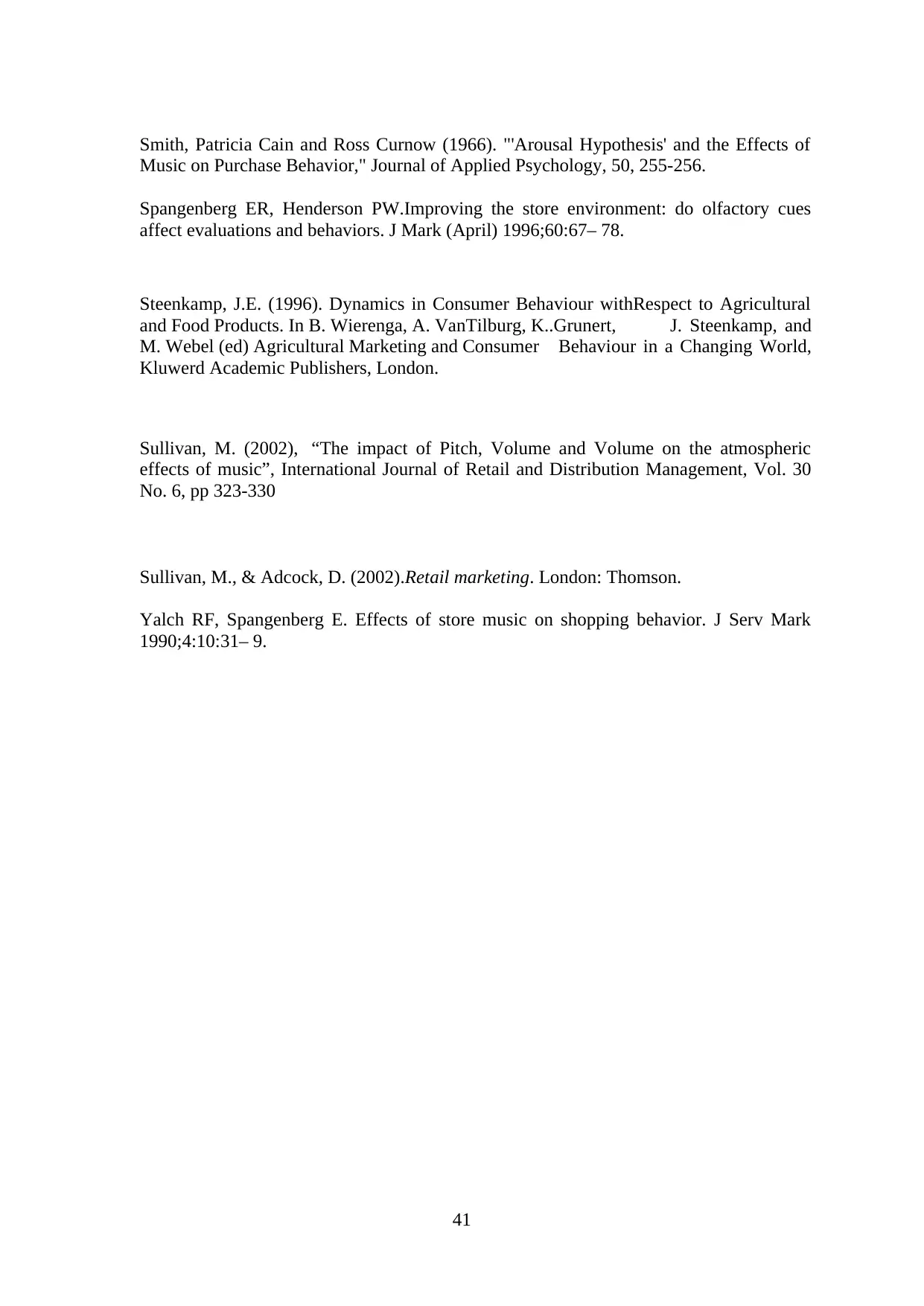
Smith, Patricia Cain and Ross Curnow (1966). "'Arousal Hypothesis' and the Effects of
Music on Purchase Behavior," Journal of Applied Psychology, 50, 255-256.
Spangenberg ER, Henderson PW.Improving the store environment: do olfactory cues
affect evaluations and behaviors. J Mark (April) 1996;60:67– 78.
Steenkamp, J.E. (1996). Dynamics in Consumer Behaviour withRespect to Agricultural
and Food Products. In B. Wierenga, A. VanTilburg, K..Grunert, J. Steenkamp, and
M. Webel (ed) Agricultural Marketing and Consumer Behaviour in a Changing World,
Kluwerd Academic Publishers, London.
Sullivan, M. (2002), “The impact of Pitch, Volume and Volume on the atmospheric
effects of music”, International Journal of Retail and Distribution Management, Vol. 30
No. 6, pp 323-330
Sullivan, M., & Adcock, D. (2002).Retail marketing. London: Thomson.
Yalch RF, Spangenberg E. Effects of store music on shopping behavior. J Serv Mark
1990;4:10:31– 9.
41
Music on Purchase Behavior," Journal of Applied Psychology, 50, 255-256.
Spangenberg ER, Henderson PW.Improving the store environment: do olfactory cues
affect evaluations and behaviors. J Mark (April) 1996;60:67– 78.
Steenkamp, J.E. (1996). Dynamics in Consumer Behaviour withRespect to Agricultural
and Food Products. In B. Wierenga, A. VanTilburg, K..Grunert, J. Steenkamp, and
M. Webel (ed) Agricultural Marketing and Consumer Behaviour in a Changing World,
Kluwerd Academic Publishers, London.
Sullivan, M. (2002), “The impact of Pitch, Volume and Volume on the atmospheric
effects of music”, International Journal of Retail and Distribution Management, Vol. 30
No. 6, pp 323-330
Sullivan, M., & Adcock, D. (2002).Retail marketing. London: Thomson.
Yalch RF, Spangenberg E. Effects of store music on shopping behavior. J Serv Mark
1990;4:10:31– 9.
41
1 out of 42
Related Documents
Your All-in-One AI-Powered Toolkit for Academic Success.
+13062052269
info@desklib.com
Available 24*7 on WhatsApp / Email
![[object Object]](/_next/static/media/star-bottom.7253800d.svg)
Unlock your academic potential
© 2024 | Zucol Services PVT LTD | All rights reserved.





